|
12/3/2025:
Tennessee Special Election: Post-Mortem
[RightDataUSA]
|

Democrats were counting on Santa coming early to Tennessee this year.
He must be running late.
On December 2, Republican Matt Van Epps defeated radical leftist Democrat Aftyn Behn in a special election in Tennessee's 7th Congressional District. With all precincts reporting, Van Epps had 54% to Behn's 45%. The district is routinely (but erroneously) described as "dark red", because Donald Trump won there in 2024 by 22%, and former congressman Mark Green (R) prevailed by a similar margin the last two times he ran. Green resigned from Congress last July. Van Epps will be sworn in later this month and, along with all other House members, will be up for re-election in November, 2026.
This special election was supposed to be much closer than usual -- and it was -- for the same reasons that special elections often work that way in GOP districts: Democrat money, motivation and organization are nearly always superior to that of Republicans, and Tuesday was no exception. The district is rated by us as being R+8, which means that the normal GOP margin of victory is approximately 16 points, not 8 points; Charlie Cook calls it R+10 (which would imply a 20-point Republican win) based on the limited data he uses. Van Epps won by 9.
Behn took nearly 80% in Davidson County (Nashville), but lost all of the other 13 counties in the district. Every county swung to the left as compared to 2024, with the biggest leftward lurches occurring in Davidson (19 points) and in suburban Montgomery County (12 points). Those are the two largest counties in the district, and together they account for just under half of the votes. Behn received 45% in Montgomery, which is the first time since 2008 that any Democrat House candidate has even attained 40% there.
 Photo credit: Tennessee Star
Photo credit: Tennessee Star
Van Epps' win was quite an important result, given the narrow GOP margin in the House, and the amount by which he triumphed is not nearly as important though it will be the subject of rigorous analysis in the media for the next few days before being forgotten.
Do not completely discount the closeness of the race; an ignorant "we had 'em all the way" attitude may be fine for casual observers who know little or nothing about the dynamics of this election, but if the GOP establishment takes a win which was half of the usual margin as an excuse for complacency, then they may be in for a rude surprise 11 months from now. Special elections often mean little as a harbinger of future events, however
current generic polls for Congress indicate a 4 to 6 point advantage for Democrats next year. If that gets translated into votes in November, the GOP would probably be looking at a net loss of something like 15-20 House seats. They can't afford anything even close to those numbers.
We have already highlighted much of the Tennessee Democrat's nutzoid viewpoints here, but of course few if any of those things were featured in Aftyn Behn's campaign ads. Instead, those ads focused on the economy, health care, and of course hating on Donald Trump and Republicans. Behn campaigned as a populist rather than as the woke lunatic she really is. She didn't fool quite enough voters, but she did make a dent in the customary Republican MOV in TN-7.
DNC chair Ken Martin called Behn's performance "historic", and "a flashing warning sign for Republicans heading into the midterms". Behn hinted that she may run again for Congress in 2026 (please do!), but Democrats are probably not quite so stupid as to allow that. Will anyone admit she was a bad candidate, or at least that she was just an experiment to see how a complete left-wingnut would fare in a low-turnout special election in a supposedly "deep red" district? Will they really stick to this approach going forward? A Democrat who is less radical than Behn would undoubtedly have fared better on Tuesday.
In the end, what we have here is yet another "moral victory" for Democrats to go with the actual victory for Republicans. The same thing happened 8 months ago in a couple of special elections in Florida, with Republicans winning and retaining those seats -- but they won by only half as much as they were "supposed" to. Democrats spent an inordinate amount of money trying to purchase an actual "solid red" district (FL-6), but they failed miserably there too. Because Republican Randy Fine won that election by only 14 points instead of 28 points in the R+14 district, Democrats were outwardly cheerful then too despite losing by over 25,000 votes.
Today's talking points regarding this tremendous Democrat victory (LOL) on Tuesday:
- A narrow Republican win is "a bad sign" [for the GOP] because Donald Trump had carried the seat by double digits every time he was on the ballot.
- Aggressive GOP "gerrymanders" -- like slicing Nashville into three Republican-leaning seats -- can backfire once demographics shift and Trump isn't literally on the ballot.
- Investing in "hopeless" red seats can force the GOP to spend money it doesn't have and build Democrat bench strength for later cycles.
- Independents [even in TN-7] have turned sharply against Trump.
- Republicans had to unleash every lever of MAGA power to hang on to a seat they once took for granted.
- Democrats have been surging -- outperforming 2024 presidential margins in special elections by an average of nearly 20 points from Florida to Arizona, and now Tennessee.
That's a considerable amount of gloating for a party which just lost an election they (deep down) actually thought they could win. It comes mainly from a "Newsweek" article which is being disseminated via other liberal outlets as well.
There is at least one kernel of truth contained within all the spinning, and that is point number two. For example, the recent re-map in North Carolina may help pick up one (1) seat for the GOP in 2026, however at least half a dozen Republican incumbents are endangered in the Tarheel State; the Republicans are still favored in their respective districts but in a "blue" wave a lot of them could drown. Meanwhile in California, the recently-approved Democrat gerrymander not only eliminates 4 or 5 GOP House seats, but also protects half a dozen Democrat incumbents who may have been vulnerable without the new map. When Republicans get into a gerrymandering war with the experts at such things -- Democrats -- they may find themselves outclassed even if the courts actually permit the new GOP maps to be used.
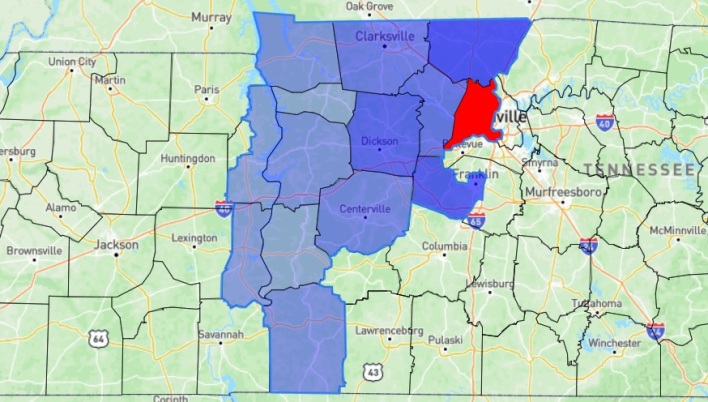 TN-7 results: December, 2025 special election
TN-7 results: December, 2025 special election
Election report card:
Nashville cast 22.3% of the vote in the 7th District in 2024; they moved up slightly to 23.6% this time. The surplus of votes (23,798) for the Democrat in Nashville was almost identical to the margin which Van Epps obtained in Robertson, Williamson, Dickson & Cheatham counties combined (23,338). But where is Montgomery County? It was right there with Robertson and Williamson at the top of Mark Green's list of benefactors in 2024. In 2025 it still cast the most votes of any county. We noted that "Green won Montgomery by 19.7% in 2024; Van Epps will not approach that number". Van Epps won Montgomery by only 8%; that was the biggest leap to the left outside of Nashville itself.
Here is the data for all counties, comparing 2025 to 2024. Every county in the district experienced a swing to the left in 2025.
Montgomery County was disappointing for Van Epps, but the ones other than Nashville saved him. We said, regarding the 2024 House election: "In the other 12 counties combined, Green took over 72%. Van Epps had better get 65% or more, even if he can't quite muster 72%". He got 68.7% in the 12 counties outside of Davidson & MontCo. Generally, the farther away a county is from Nashville, the less it swung to the left on Tuesday (Robertson being an exception; it is adjacent to Nashville but did relatively well for Van Epps anyway).
We asked: "Does 54.3% of the 2025 primary vote going to the GOP mean anything for the general election? If so, it probably just sets an upper limit for Van Epps". He took 53.9% as it stands now, very close to that theoretical limit. The relative party vote shares in primary elections in House races rarely forecast general elections with such precision as we saw in TN-7 in both 2024 and 2025.
Turnout was certainly a factor, with the early/absentee ballots (which always favor the left) being insufficient to get the Democrat over the hump. We said: "Even with visions of 2018 dancing in Democrat heads, it's possible that turnout next week will not reach that 2022 number (181,000). . . and low pre-election day turnout here -- if it stays low -- may actually favor Republicans". Turnout in 2025 was 180,000 with still a tiny number of votes possibly remaining to be counted. Rats needed a repeat of 2018 as far as motivation was concerned; instead they got a repeat of 2022. That wasn't bad at all for a special election, but not nearly enough to tip the scales.
We also predicted a Van Epps win "by 2 or 3 points". His MOV was 8.9% and that, under the circumstances, is a significant accomplishment even if it's not anywhere close to the 16% GOP lean of the district. Democrat money, motivation and organization had a big impact (as they always do in low-turnout special elections), but those things didn't make a big enough impact because Republican voter turnout on Election Day dwarfed that of the Democrats'. As we have noted above, the outcome in TN-7 was quite similar to the special election in FL-6 in April -- with the GOP winning, but only by half the normal amount. As in FL-6, although they invested heavily in the special election and claimed a moral victory, Democrats will not be spending quite so outrageously in 2026 in solid "red" districts, so Van Epps should be safe in TN-7 (except perhaps in a primary) from this point through at least 2030.
One final word about this district: of the 435 House districts nationwide there are 212 which lean R; 5 are rated even; and 218 lean D, not factoring in any of the 2025 redistrictings yet. TN-7 is rated as R+8, which ranks it only as the 139th most Republican district in the country (tied with 12 others). Even if you accept Charlie Cook's rating of R+10 instead of our R+8, that would rank TN-7 121st at best. In either case, that's a curious definition of "dark red". It's just ordinary red, that's all. But the media and other Democrats are obliged to make it sound to their unenlightened followers as if the greatest upset in election history almost occurred here.
Tags:
2025
Tennessee
Special election
Merry Christmas!
|
|
11/27/2025:
Tennessee Special Election: Do Republicans Need Another Wake-up Call Already?
[RightDataUSA]
|
 Photo credit: The Tennessee Conservative
Photo credit: The Tennessee Conservative
On December 2 there will be a special election in Tennessee's 7th Congressional District to fill the vacancy which was caused when Republican Mark Green resigned from the House in July to "take a job in the private sector". The GOP currently controls the House by the count of 219-213. There are two vacant Democrat seats (TX-18, NJ-11) which will be easily retained by other Democrats when the special elections for those seats roll around next year. The outcome of this Tennessee election next week will determine whether the Republican advantage is eventually 5 seats (220-215) or 3 seats (219-216).
Background:
Green, who was in his fourth term in Congress, was first elected in 2018 when former CD-7 incumbent Marsha Blackburn chose to run for the Senate. He had been a reliably conservative vote in the House and was chairman of the important Homeland Security Committee. Green almost declined to run for a fourth term, announcing in February of 2024 that he would not be a candidate for re-election that November. He changed his mind two weeks later, ran again in November 2024, and won easily.
That race was not quite as effortless as the ones he'd had in 2018 and 2020. The decreased margins in 2022 and 2024 weren't any reflection on Green himself -- the 7th District had been significantly altered prior to 2022 and was not quite the same as the district which routinely delivered landslides to GOP House members such as Blackburn, Ed Bryant and Don Sundquist. Nor was it the same as the district in which Green first ran 7 years ago.
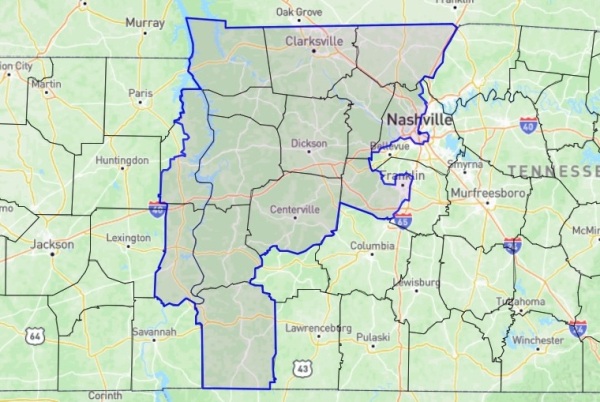 Current map of Tennessee congressional district 7
Current map of Tennessee congressional district 7
In 2021 Tennessee Republican redistricters did something that their colleagues in other states were too chicken to do. They broke up a Democrat district (CD-5) which caused Republicans to pick up one House seat as of 2022. CD-5 formerly contained all of the city of Nashville, and therefore was heavily Democrat. But for 2022 and beyond the city was split into three pieces, and those pieces were attached to heavily Republican suburban and rural territory. CD-5 incumbent Democrat Jim Cooper saw what he would be up against in 2022, and opted to retire.
CD-5 was won by Republican Andy Ogles in 2022, but a side effect of the new and improved CD-5 was that adjacent districts would be less overwhelmingly Republican than they had been. The Democrat Diaspora moved CD-6 and CD-7 somewhere around 10 points to the left. No big deal, they could afford it. So instead of GOP candidates taking 70% of the vote in House races, they would simply win with about 60% instead.
That's exactly what happened in CD-7, with Green losing approximately 10% of his previous support. We still rate the current version of CD-7 as R+8, which means that a typical Republican should win here by an average of 16 points. In 2024, Donald Trump took 60% of the vote in CD-7 and prevailed by 22 points; Green won by almost exactly the same amount that year.
The candidates:
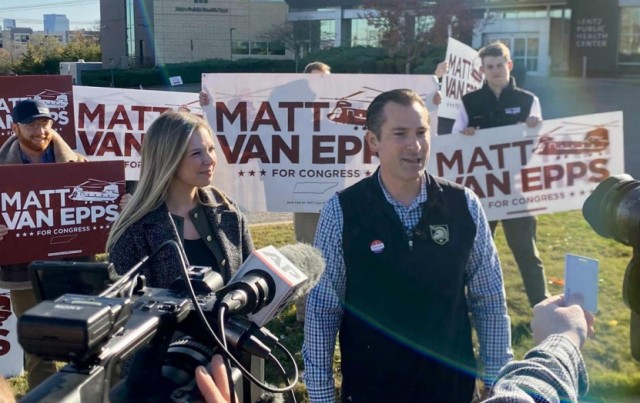 Photo credit: Nashville Tennesseean
Photo credit: Nashville Tennesseean
GOP nominee Matt Van Epps is a West Point graduate, U.S. Army veteran and current member of the Tennessee Army National Guard. He is a former official in the administration of Tennessee Governor Bill Lee, most recently as director of the state's Department of General Services. Van Epps previously served as Lee's "COVID Czar", which is not exactly a resume-enhancer. Van Epps, like Lee, is considered by many to be a member in good standing of the squishy GOP establishment. There was an 11-way Republican primary in October, which was decisively won by Van Epps after he received the endorsement of President Trump, much to the dismay of conservatives.
State representative Jody Barrett, who finished second to Van Epps in the primary, later confessed that he "didn't really want to win" because he never wished to seek federal office but was pushed into it. He also lamented the fact that the establishment (including Trump) was against him, both in terms of endorsements and money. Barrett made a point of not endorsing Van Epps for the general election.
Van Epps sounds like a solid conservative on all the issues: the economy, border control, Second Amendment rights, being pro-life, anti-transvestite, and so forth. GOP candidates running in (supposedly) solid "red" districts always sound like that when running for office.
 Photo credit: Tennessee Star
Photo credit: Tennessee Star
His opponent, radical leftist Aftyn Behn, could hardly provide a more stark contrast.
Behn prevailed with just under 28% of the vote in a 4-way Democrat primary which couldn't have been much closer, with less than a 5-point spread from top to bottom. Behn won only one of the district's 14 counties, but did well enough elsewhere to secure the victory. Longtime state representative Bo Mitchell was the relatively sane Democrat in the race, but he lacked the funds to truly compete for the W.
Behn, who has been lovingly described as the "AOC of Tennessee", is on the extreme left on every conceivable issue. No matter how much assistance she is receiving from the liberal establishment and the liberal media, this approach should be a recipe for abject failure in a House district which doesn't much resemble the one represented by the actual AOC. Nashville is bad, but it's not the Bronx.
The following items represent Aftyn Behn's "qualifications". That may sound sarcastic, but to her rabid, hate-filled supporters these are seen as being 100% in her favor:
Any one of the above would make a great campaign ad for Republicans. But are they on the air with any of this? Or are they just making a few posts on Twitter?
Polling and other data:
A new Emerson poll as of 11/26 shows Van Epps up but a very close race. Why should we trust anything Emerson says? Look at their forecast of the New Jersey Governor election -- they had the Republican losing by just 1 point. Just because they were delighted to be wrong about the extent of Jack Ciattarelli's defeat, doesn't make them any less wrong.
Some observers have noticed what appears to be an oddity in the internal breakdowns of yesterday's Emerson poll. Trump won Tennessee's 7th Congressional District with 60.4% of the vote in 2024. Yet Emerson has only 53.6% of their polling sample as being Trump voters. We concede that turnout and motivation are much different now than they were in 2024; to slightly modify a common phrase which is popular among losers: "12 months ago is an eternity in politics". But have things really moved 7 points to the left in CD-7? Haven't we been assured by the GOP establishment and other deniers of reality that everything bad which happened three weeks ago was confined to "blue" states only? So it can't happen here -- or can it?
As far as financial data, the latest FEC reports on this election are from two weeks ago. At that time the Democrat had raised about 25% more money than the Republican (what else is new?) but had spent slightly less. Even based on those somewhat out-of-date figures, Behn had about $300,000 more cash-on-hand than Van Epps did, heading into the final 3 weeks of the campaign. You can be reasonably certain that in those final 3 weeks, the Democrats have raked in, and will spend, far more than the Republican. That fact will be apparent when the final FEC reports become available.
 Photo credit: Drill Down with Peter Schweitzer
Photo credit: Drill Down with Peter Schweitzer
Nearly all of the $1.2 million which Behn has raised allegedly comes from "individual" contributors. The Democrats' ActBlue Laundromat routinely splits billionaire donations into tiny fragments and assigns those fragments to unaware individuals in a process known as "smurfing". This creates the illusion of broad "mom-'n-pop" support (not to mention evading campaign finance laws) and allows the Democrat to declare with a straight face that she is a candidate "of the little people". Van Epps, on the other hand, must rely on actual individual contributions, and those have been insufficient to be competitive in a high-stakes race like this one. To bridge the fundraising gap, the Republican has had to take a substantial amount (about 30% of his receipts) from PACs.
In 2024 Mark Green won 13 of the 7th District's 14 counties, losing Davidson County (Nashville) by 26,000 votes but winning overall by 69,000 votes. Nashville gets all of the hype in the district but cast only 22.3% of the vote in 2024. The city will give Behn a substantial majority next Tuesday; Nashville voters hate Republicans more than the Democrat nominee hates Nashville. It's a complex relationship, LOL.
Montgomery County, with 24.1% of the vote, is the top vote-producer in the district and carries a little more weight than Nashville. Green won Montgomery by 19.7% in 2024; Van Epps will not approach that number. In the other 12 counties combined, Green took over 72%. Van Epps had better get 65% or more, even if he can't quite muster 72%.
So how do all those figures from just 12 months ago suddenly translate into a very close race now? They shouldn't.
Green's performance last year was not an anomaly: even though the Democrats fielded a candidate who was a felon (but a cute one!), you can't say they didn't try to win in 2024; they spent $1.25 million, more than they spent in the other two Nashville-area districts combined. Even though Republican Andy Ogles in CD-5 was declared by the media to be vulnerable, the Democrats mostly bypassed Ogles and focused more resources on opposing Mark Green instead. Ogles won by nearly 20% in CD-5, almost the same MOV that Green attained in CD-7.
Primary data:
There were 53,483 total votes in the 2024 House primaries in CD-7, 59.6% of which went to the unopposed GOP candidate. Green then got 59.5% in the general (some little-known independent took 2.4%). It was just a coincidence that the primary vote share was so close to Green's general election percentage, but not a complete coincidence.
There were 67,886 total votes in the 2025 special election primaries, 54.3% of which went to Republicans. Democrats are seizing upon this data point, claiming it is an indicator of a substantial shift in their direction. However, the fragmented Rat primary and Behn's lack of endorsement by the primary losers could indicate an upcoming underperformance for her in December. It's a nice thought, but don't bank on it happening. The Republican primary was just as split as the Democrats', and the wounds inflicted there have not healed. On the Democrat side, money makes up for a lot of hurt feelings.
Does 54.3% of the 2025 primary vote going to the GOP mean anything for the general election? If so, it probably just sets an upper limit for Van Epps. There will be 4 independent candidates on the ballot, one of which is a former Republican. Altogether they will take 2 or 3 percent of the vote at most.
Conclusion:
All pertinent factors indicate a close race (within 5 points one way or the other). No factors indicate an easy GOP win. The factor which favors the Republicans to the greatest degree is the most irrelevant one of them all -- the PVI. PVIs are created based on regularly-scheduled elections with high turnout, and 2025 is not going to be one of those. There were 323,000 votes cast in CD-7 in the presidential year of 2024; turnout was 181,000 in midterm 2022, but it was a little over 250,000 in 2018 (the last midterm in which Democrats were motivated by as much hatred as they now possess). Even with visions of 2018 dancing in Democrat heads, it's possible that turnout next week will not reach that 2022 number. As of 11/26, 84,000 votes had been cast either early or absentee. That doesn't sound like much to us, and low pre-election day turnout here -- if it stays low -- may actually favor Republicans. We'll see. There are still a few days of pre-election voting to come, and they could be busy days.
Tennessee's 7th Congressional District is now rated as R+8 (Charlie Cook says R+10 based on his limited data). A rating of R+8 means that a Republican typically wins by 16 points. This race is going to be way closer than 16 points -- or even 10 points. As in nearly all special elections, Democrat money, organization and motivation are running very high, almost as high as Republican apathy. These factors, plus polling (such as it is) all indicate an outcome that is basically a tossup despite the overall Republican lean of the area.
Prediction: We'll say Van Epps win by 2 or 3 points. If that estimate turns out to be significantly off the mark, it will be in the wrong direction -- just like many people's estimates in New Jersey and Virginia were on November 4th.
Tags:
2025
Tennessee
Special election
|
|
11/20/2025:
Senate Prospects For 2026: Part Two, Voting Schemes and Pipe Dreams
[RightDataUSA]
|
We've already covered the eight U.S. Senate seats which have the greatest probability of changing hands in 2026. The list includes 3 seats currently held by Democrats and 5 which have GOP incumbents. Most of the other 27 Senate seats which will have elections next year appear to be perfectly safe for the party which holds them. A few others fall just short of "perfectly safe".
Perfectly safe (or close to it) Senate seats:
- Republican: Alabama, Arkansas, Florida (special), Idaho, Kansas, Louisiana, Mississippi, Montana, Oklahoma, South Carolina, South Dakota, Tennessee, West Virginia, Wyoming
- Democrat: Colorado, Delaware, Illinois, Massachusetts, New Jersey, New Mexico, Oregon, Rhode Island, Virginia
A couple of states which are neither likely to flip nor quite 100% safe are Nebraska and Minnesota. We will also cover a few other states below -- Louisiana because of its "new" voting scheme which finally abandons the jungle primary; Alaska because it may be a close race and because of its utilization of the Rigged Choice Voting scheme which could determine the Senate winner there; also Kentucky because that's on the Democrat pipe dream list along with Alaska and Nebraska. Kentucky has one Democrat who can win statewide and he's already occupied with being a figurehead Governor who covets higher office someday -- but not the Senate, at least not in 2026.
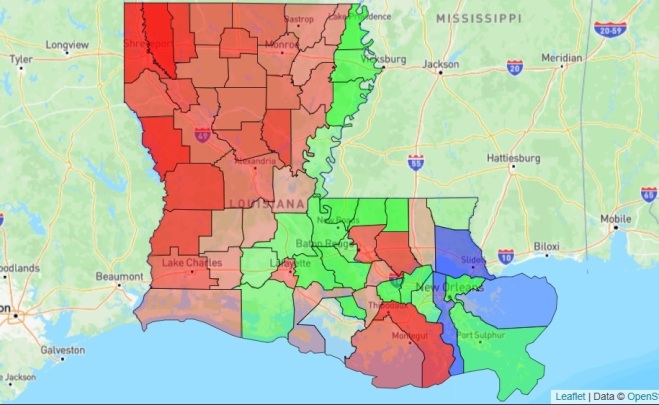 Louisiana gubernatorial jungle primary, 1987
Louisiana gubernatorial jungle primary, 1987
Louisiana:
This Senate seat is highly unlikely to slip away from the GOP next year, but it may be an interesting race.
As of 2026 Louisiana is abandoning its "jungle" primary system which was instituted in 1975 by Democrat Governor (and eventual convicted felon) Eddie Edwards. Louisiana is returning to single-party closed primaries, and that sounds like a good thing.
But it probably isn't.
In 1975 Republicans accounted for less than 10% of the Louisiana electorate and were outnumbered by as many as 2,000,000 Democrats statewide. From the end of Radical Reconstruction, Republicans were never anything close to being a viable factor in Pelican State elections. The GOP had not elected a Governor since 1876 and would never elect a Senator prior to the 21st century. Until the 1960's, Republicans were unheard of in the congressional delegation or in the state legislature. In these respects, Louisiana was no different from many other Deep South states.
By 1975 however, Edwards may have noticed that the GOP (though still largely nascent) was beginning to grow, and the Democrat Governor desired to rig the system to favor his party. In a jungle primary, all candidates regardless of party run together on the same ballot. The top two finishers -- also regardless of party -- advance to the general election which is essentially a runoff. A wrinkle which was added in Louisiana is that if any candidate achieves a majority of the vote in the jungle primary, then that candidate is declared the winner of the race and there is no general election for that office. An example of how this worked is the 2020 U.S. Senate election, in which RINO Bill Cassidy was re-elected.
In the jungle primary which took place on November 3, 2020, Cassidy faced 14 challengers (5 Democrats, 1 Republican, 1 Libertarian, 7 independents), exactly zero of which posed a serious threat -- all 5 Democrats combined added up to only 36% and the one other Republican contender barely registered a pulse. Cassidy won with 59.3% of the vote. Had his percentage not exceeded the magic number of 50, he would have been forced into a runoff with the second-place finisher.
 Photo of inmate No. 03128-095 from wwltv.com
Photo of inmate No. 03128-095 from wwltv.com
What really triggered Edwards was the February, 1972 gubernatorial race, in which he first won the Democrat primary against over a dozen other candidates (but did not even get 25% of the vote) and then narrowly prevailed in a grueling runoff against Bennett Johnston and then had to face Republican David Treen in the general which turned out much closer than expected. Treen had cruised easily through the GOP primary and did not need to endure any runoff. So why, Edwards asked, should the vastly outnumbered Republican party be guaranteed a spot on a general election ballot like in every other state, while Democrats had to face as many as two bruising contests just to get to that same spot?
The answer to that question, beginning in 1977, was to make Republicans in Louisiana into an effectively-disenfranchised minority group. Until the 1990's, the majority of statewide general elections in Louisiana were Democrat against Democrat. Furthermore, when no general election was needed because someone got over 50% in the jungle primary, that "someone" was always a Democrat.
This contrivance worked well for Louisiana Democrats for a long time. But Treen was elected Governor in a 1979 upset and by the 1980's the GOP at least fielded a candidate in most elections. Although after Treen won it was 16 years before another Republican was elected Governor, and it wasn't until 2004 that Republicans elected their first U.S. Senator from Louisiana. Democrats continued to dominate other statewide offices as well.
As of 2004 the tide had turned, and Democrats (and liberal Republicans) knew it. Then came the mass exodus of New Orleans Democrats as the result of Hurricane Katrina in 2005; New Orleans was already in population decline but the hurricane momentarily accelerated the process. From that point forward it has been Democrats who almost always find themselves on the outside in a general election, not simply because New Orleans temporarily lost about 100,000 potential voters, but because the general preference of Louisiana voters has done a 180-degree turn away from Democrats and towards Republicans. Since 2007 only Dirty Mary Landrieu in 2008 and John Bel Edwards (fluke wins in 2015 and 2019) have been able to prevail statewide as Democrats in Louisiana.
Liberal Republicans like Bill Cassidy have (along with Democrats) lately decried the jungle primary, and in 2024 the state legislature passed a bill which reverts to closed, single-party primaries for elections for federal offices effective as of 2026; elections for state and local office in Louisiana will continue with the jungle primary. The new scheme is a "win" for liberals of both parties: Democrats get a guaranteed spot on a general election ballot; RINOs no longer need to deal with Democrats taking votes from them in a primary, and thus stand a better chance against real Republicans.
In a supposedly "closed" GOP primary, Cassidy will receive a higher percentage of votes than he would in a jungle. He will be the winner if several conservative candidates split the right-wing vote while Cassidy has all of the left-wing votes for himself. Most likely, however, Cassidy will still need to survive a primary runoff. That won't be as difficult as it may sound. One very important provision of the new law which eliminated the jungle primary is that independent voters -- and there are plenty of those in Louisiana (nearly 30%) -- can cast a ballot in whichever primary they choose. Take a bunch of "moderate" independents, add in some Democrat voters who switch and become Republicans temporarily, and RINOs are suddenly far less endangered than they were before. If Cassidy's fate was decided only by true Republicans, it wouldn't be pleasant for him.
Cassidy's #1 opponent at the moment is state Treasurer John Fleming, a 74-year-old Republican. Democrats have nobody worth mentioning. Fleming served 4 terms in the U.S. House from the 4th District from 2009-2016; the guy who replaced Fleming in that district in 2016 is now the Speaker of the House. Fleming is a very solid conservative, and if other conservatives stay out of the May, 2026 Senate primary, Fleming has an excellent chance to win. November would be a formality. But the primary will not be so simple, and that works to the advantage of RINO incumbent Cassidy because the non-RINO primary vote will be fractured. Other prominent candidates include first-term state Senator Blake Miguez, who is a moderate-conservative; and St. Tammany Parish councilwoman Kathy Seiden, who is a young, attractive Christian conservative.
 Photo credit: wwltv.com
Photo credit: wwltv.com
Cassidy has a major cash advantage, Miguez and Fleming are building their war chests, and Seiden has only recently thrown her hat into the ring. Whoever wins the GOP primary will be Louisiana's next U.S. Senator. Miguez, though more of a centrist, will still take more votes from Fleming and Seiden than he will from Cassidy. Best case scenario is that at least one of the two actual conservatives makes the runoff. With one Democrat now guaranteed to be on the general election ballot (thanks again, Louisiana RINOs) billionaire ActBlue contributors may go all-out to try to steal this seat, but this is one state where it is very unlikely that they will succeed.
Alaska:

Democrats have nobody yet for this race in what people falsely assume is a Republican state; the GOP has only 24% of voter registrations in Alaska while 59% are registered independents. But the Democrats believe (and left-wing polls back them up) that fake-moderate ex-congresswoman Mary Peltola would be a formidable opponent against incumbent Republican Dan Sullivan. Sullivan, an actual moderate, was first elected to the Senate in 2014 when he defeated incumbent Democrat Mark Begich and then was re-elected in 2020 by an unimpressive margin over big-spending liberal Al Gross.
An obscure former state legislator from the outback, Peltola entered the spotlight in August, 2022 when she reaped the full benefit of Alaska's Rigged Choice Voting (RCV) election system and won the House seat of the departed Don Young by taking 39.7% of the vote in a special election. Sarah Palin's entry into that race split the GOP vote (which totaled 58.7%), and after RCV worked its black magic Peltola was declared the winner. She won again in November against the same two GOP combatants. Republicans finally got smart in 2024 and stopped the internal warfare, with Nick Begich winning the House seat he had been denied twice previously. Democrats desperately want Peltola to run for something in 2026, whether it be Governor, Senator or House, because no other Democrat seems to be remotely viable. Alaska's filing deadline isn't until June, so the "Peltola Watch" may go on for some time.
Peltola may have a greater chance at becoming Governor rather than Senator because no Republican (so far) is stepping up to plausibly challenge Sullivan; the GOP vote will not be split, and Sullivan's squishiness will appeal to so-called independents who might otherwise vote for a Democrat. However the Governor race is wide-open and numerous Republicans will be splitting the vote in the jungle primary and probably in the general election too. If Peltola gets into that race, other Rats will flee. The over-abundance of Republican wannabes gives Democrats and Peltola the perfect opportunity to use Rigged Choice Voting to their advantage again, a la 2022.
Even if Sullivan wins another Senate term in 2026, Alaska still might hand Senate control to the Democrats. As we first predicted over 3 years ago, if Senate control hangs in the balance, uber-RINO Alaska Senator Lisa Murkowski will almost certainly switch parties -- either ending her charade and becoming a Democrat, or going the Independent route and caucusing with the Dems -- and hand the Senate over to the Rats. The GOP majority hasn't been thin enough yet for this grandstanding attention whore to make any difference in that manner, but after 2026 it very well might be. Or Republicans may lose outright, and Murkowski might switch just to be on the winning team and get some better committee assignments in the last two years of her final term (before voters kick her to the curb in 2028 -- hopefully).
Murkowski previewed her intentions here, a few months ago.
Kentucky:
 Photo credit: Lexington Herald Leader
Photo credit: Lexington Herald Leader
The Bluegrass State is wide open due to the long-overdue retirement of Mitch McConnell. The best-known candidates in the Republican primary are moderate congressman Andy Barr and former Attorney General Daniel Cameron. Barr has represented the Lexington-area district in Congress since 2013 and he's turned what was once a marginal House seat into a rather safe one which Democrats no longer seriously go for in most elections; they are putting it back on their radar in 2026, however. Cameron, elected as A.G. in 2019, was seen by some on the right as insufficiently tough on Democrat crimes while in office, and his bid to move up to Governor ended dismally when he was totally outclassed (and vastly outspent) in 2023. There is also businessman Nate Morris running on the GOP side, and he is definitely the most conservative option of the three. Barr is currently the leader in the fundraising portion of the race.
Democrats seem to be pinning their hopes on one of two female statewide failures:
- Amy McGrath, who once wasted $8 million running against Barr in the 6th District and couldn't even win in hyper-Democrat 2018. The national party again spared no expense in 2020, spending nearly $100 million on McGrath as she failed to defeat the unpopular McConnell for the Senate. She won 3 counties. McGrath's 2026 campaign is built around "I hate Donald Trump, just like you do!" and nothing else aside from wrapping herself in the flag and posing as a patriot because she once was in the military. Democrats often try that approach; it seldom works outside of "blue" states (where that sort of thing isn't necessary and is probably counterproductive).
- State House Minority Leader Pamela Stevenson, who represents a Louisville ghetto district. Stevenson doesn't appear to have much of a campaign organization yet. Stevenson ran for Attorney General in 2023 and lost by 16 points even as Empty Suit Andy Beshear was winning at the top of the Rat ticket. Stevenson, like McGrath, also has military cred, having once been in the Judge Advocate General's Corps in the U.S. Air Force.
- There is also former CIA spook Joel Willett, the Deep State entrant into the race; Kentucky's version of Virginia's Abby Spanberger, but without any electoral history. He's trying to seize the all-important Democrat "Working Class Hero" (W.C.H.) designation for himself, and also has the "victim card" handy; this guy who nobody's ever heard of is apparently such a menace to GOP chances in the 2026 election that he claims to have received death threats from Republicans.
A recent addition on the Democrat side, presumably for additional comic relief, is horse trainer Dale Romans. Horses are big in Kentucky, and this guy's full of as much horseshit as any of them. He also wants to be the W.C.H. candidate in the contest, and describes himself as an "independent" Democrat even as he spouts the same nonsense as all other (presumably non-independent) Democrats. Bernie Sanders is an "independent" too.
McGrath is the most likely of the above to be the Democrat nominee, but nobody currently has any illusions that she will win. Morris may have a better shot than anticipated on the GOP side, but a squish like Barr probably has the best chance of winning a general election, and therefore the big money and big endorsements will be behind him. Cameron is currently being slimed with unproven allegations of misconduct while Attorney General, and he is also a proven statewide loser. Cameron appears to be the favorite to finish third in the GOP primary.
Minnesota:
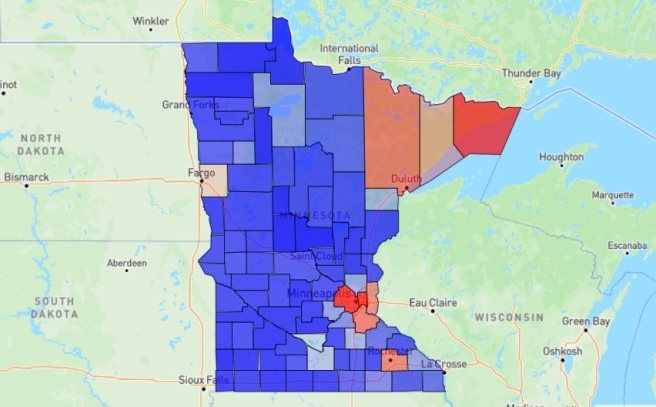 2024 presidential results in Minnesota
2024 presidential results in Minnesota
This state, like Virginia (see below) is nothing but a Republican pipe dream. The congressional delegation is always pretty well balanced, either 4-4 or 5-3 every election since 2000. The state House and state Senate are very close. Minnesota doesn't register voters by party, but a company whose business it is to estimate party breakdowns calculates that Minnesota is one-third Democrat, one-third Republican and one-third independent or minor parties. This may be an oversimplification, but the Twin Cities and their suburbs (at least the first two "rings") are terrible, the rest of the state is fine. The first part of that sentence is definitely true, anyway.
When it comes to statewide elections, the GOP sometimes comes close -- but never wins. Trump won every single county in Minnesota except 4 in the Twin Cities area, 3 in the Arrowhead Region, and the counties containing Rochester and Moorhead. He still lost by 4 points, which isn't too bad a showing for a Republican in the Great White (75% and dropping) North. But the last time a Republican presidential candidate won in Minnesota was back in 1972 -- 53 years ago. There's usually some hope but it's always false hope.
It's no different in other statewide elections. From 2008 to 2024 there were 23 non-presidential statewide elections in Minnesota, for offices ranging from Governor and U.S. Senator to Auditor, Attorney General and Secretary of State. Only one candidate (Amy Klobuchar) has ever exceeded 55% of the vote during those years, and she's done that 3 times. The other 20 elections were close. Democrats won all 20 of them.
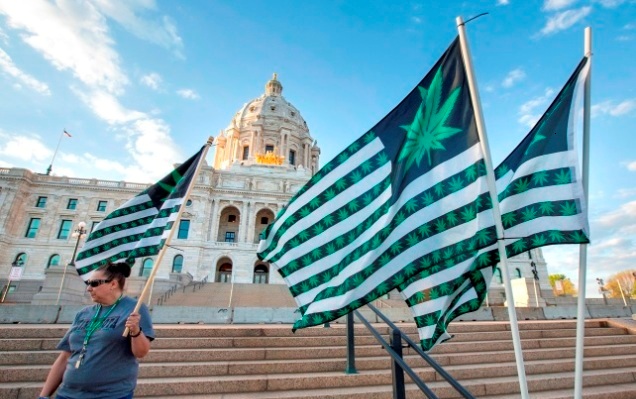 Photo credit: house.mn.gov
Photo credit: house.mn.gov
Speaking of "pipe dreams". . . one explanation for some of the previously close outcomes is -- or was -- the presence of doper parties on the ballot. The "Grassroots-Legalize Cannabis" party and the "Legal Marijuana Now!" party are both recognized political entities in Minnesota, but they ceased fielding candidates after 2022. That's because they no longer have any reason to do so; in 2023 the Democrat legislature passed a very lenient law which legalizes cannabis for any type of use, not just medicinal. The fact that the doper parties are now obsolete helps Democrats, because these parties were regularly siphoning off thousands of left-wing votes in major elections.
Republicans are pretending that they have a chance to pick up the Minnesota Senate seat in 2026. It is an open seat, being vacated by Democrat Tina Smith, who is retiring. Smith, who compiled a nearly 100% liberal rating while in the Senate, was first appointed in 2018 when Democrats forced another liberal Democrat, sexual predator Al Franken, to resign. Smith's most recent election in 2020 was a good example of how Democrats were once hindered electorally, as two stoner candidates combined to take 7.7% of the vote away from her. So Smith only won by about 5 points instead of 12 or 13 points.
The 2026 Democrat primary will be between Lt. Governor Peggy Flanagan and congresswoman Angie Craig. Flanagan has some problems, such as financial improprieties in her office, and being endorsed by Bernie Sanders; Craig is one of those lifelong liberals who suddenly sprints hysterically towards the center when seeking higher office. There's a 98% chance (rounding down) that one of these two will be the next ultra-liberal U.S. Senator from the state of Minnesota.
Ex-professional basketball player Royce White ran for the Senate in 2024 in Minnesota against Amy Klobuchar, and the Republican was stomped by over 15 points, a good example of a margin of Democrat victory when the dopers no longer split the left-wing vote. He is running again in 2026. White moved quickly across the political spectrum, going from left-wing hero in 2020 when he was leading Black Lives Matter protests after the death of "St. Floyd of Fentanyl" (White does have a history of mental illness); he's recovered from that, and is now described as a "right-wing populist". White has just as much chance of winning in 2026 -- none at all -- as he had in 2024. And he is the probable front-runner among Republicans, which shows just how much of a barren wasteland Minnesota is for the GOP. None of the state's 4 moderate Republican congressmen want any part of this race either.
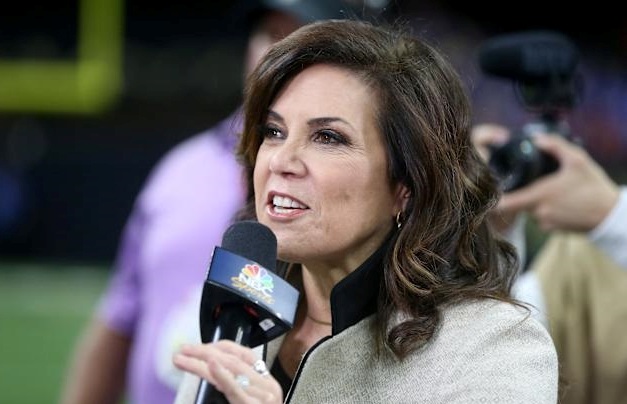 Photo credit: yahoo.com
Photo credit: yahoo.com
This foregone conclusion of an election might be spiced up a bit if ex-sports broadcaster Michele Tafoya were to enter the race on the GOP side. Tafoya was a long-time sideline reporter for NFL games, and during her career she was employed by several networks including CBS, ESPN and NBC. She retired from that profession in January, 2022; the last game she worked was Super Bowl LVI.
Tafoya, a self-described "pro-choice conservative with Libertarian leanings", is now a political commentator, doing podcasts from her home in the suburban Twin Cities area. She has been rumored as a potential candidate for the Minnesota Senate seat, but has not yet made any move towards running. The main challengers to White for the GOP nod are a pair of retired Navy veterans, Adam Schwarze and Tom Weiler, neither of whom have any political experience -- which isn't necessarily a bad thing -- but they have no name recognition (or sufficient funding, or a prayer of winning) either.
Nebraska:
 Photo credit: Zach Wendling/Nebraska Examiner
Photo credit: Zach Wendling/Nebraska Examiner
Democrat-in-disguise Dan Osborn is the Great "Independent" Hope for the left in the state of Nebraska. Fresh off of a defeat in the 2024 Senate election against incumbent GOP squish Deb Fischer in which he came closer than some expected, Osborn is rested and ready to give it another go in 2026. Osborn took all of the Democrat money he could get in 2024, but concealed his true political identity by refusing to accept the Democrat party label which is repugnant in the Cornhusker State outside of Omaha and Lincoln. Not even including all of the supposedly-independent liberal cashflow coming from outside the state, Osborn's fundraising dwarfed that of Fischer. Numerous polls showed a close race in 2024, and some even had Osborn prevailing by a small amount. Osborn won the two big liberal cities and lost everywhere else; the final outcome was a 6.7% victory for the Republican. Only one or two forecasters actually got it right; the other polls (nearly all of which were paid for by Osborn's campaign) were nothing but wishful thinking, propaganda and hot air.
Osborn's opponent in 2026 will be Nebraska's other squishy moderate Senator, Pete Ricketts.
Ricketts, the former two-term Governor of Nebraska, was appointed in January, 2023 to fill the Senate vacancy caused by the resignation of rabid Trump-hating Republican Ben Sasse. Ricketts then easily won the 2024 special election to fill the remainder of Sasse's unexpired term.
That effortless win came against a Democrat, and defeating any Democrat statewide is a slam dunk in Nebraska these days. In 2024 the national party kept its support of Osborn a secret until the final days of the campaign. National Rats are now out of the closet, and have proudly endorsed the faux independent for 2026. They have yet to support Osborn with the big money which will enable him to easily outspend Ricketts (but that will come). For his part, Osborn is careful to appear in flannel shirts, holding a hunting rifle if possible, and making sure to stress that he was once a member of Organized Labor. So unlike most Democrat "working class hero" wannabes, this guy really did once-upon-a-time work for a living before becoming a politician.
Just like in 2024, the polls purport to indicate a close race. Just like in 2024, those biased polls are very likely to be wrong when the votes are counted. But Democrats have all the money in the world, as they have conclusively shown in recent years, so why not spend it -- even on an "independent", even in a normally unwinnable state?
Because 2026 just might not be a normal election year.
Virginia:
One last word about a ridiculous GOP pipe dream state: there are probably some folks out there who are still in disbelief regarding the 2025 election results in Virginia. Unwilling to accept the reality that the Old Dominion is not remotely competitive anymore, they may think that outgoing Republican Governor Glenn Youngkin could somehow repeat his fluke win from 2021 in the 2026 Senate race against well-entrenched liberal Mark Warner.
Youngkin is a good man, and he stood up just recently against Virginia Democrats' attempt (which will succeed) to gerrymander the state's congressional districts and disenfranchise Republicans, costing them 2 or perhaps 3 seats. Youngkin is not a stupid man, and to all indications will not be entering a Senate race that he is extremely unlikely to win. If Youngkin declines, Republican pickup chances of the Virginia Senate seat drop from maybe 20% to absolute zero. Drop the pipe, wake up from the dream, and look elsewhere for potential Republican pickups.
Tags:
2026
Senate
Louisiana
Alaska
Kentucky
Minnesota
Nebraska
Virginia
|
|
11/17/2025:
Senate Prospects For 2026: Part One, The Flippables
[RightDataUSA]
|
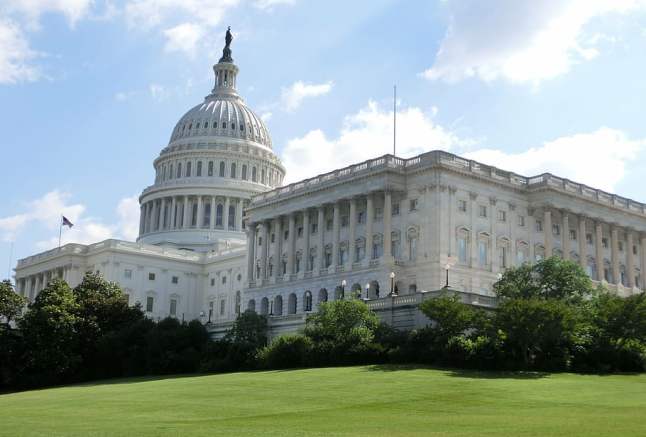
We have already examined the outlook for 2026 in the aftermath of the 2025 elections. Most of that commentary focused on the U.S. House and how the results from the last disastrous midterm election (2018) might foreshadow the upcoming potentially disastrous midterm election. We spent little time on the Senate, but noted that although 2018 was a train wreck for Republicans over almost the entire ballot, there was one minor exception: Republicans actually gained 2 Senate seats in 2018 and with some luck it could have been as many as 6. Because it was only a net +2, most observers on the right were extremely disappointed. Yet holding onto the Senate at all in 2018 was an important accomplishment and an impressive one under the circumstances. It kept rabid Democrats at least partially at bay. Recall what Democrats did with their total control of the House, and imagine what would have occurred with them in charge of the Senate during the final two years of Trump's first term in the White House.
The 2018 Senate elections provide a history lesson: that it is possible to hold steady (or even improve) at the Senate level even while being decimated up and down the remainder of the election ballot, as happened to the GOP that year.
However the individual Senate skirmishes from 2018 -- unlike the ones from the House -- are not germane as far as predicting what will happen in 2026. All 435 House seats are up for election every two years, which makes recent past midterms at least somewhat comparable to future ones. Many of the House members from 2018 are still in office, even though the configuration of their districts may have changed, and most of those members will be running again next year.
It is not the same in the Senate, where an entirely different set of Senate seats from 2018 will be contested in 2026, and that makes specific comparisons to 2018 impossible. Members of the "Class of 2018" completed their six-year terms in 2024; it is the "Class of 2020" which is up next year. Only one incumbent Senator who was elected in 2018 -- Mississippi Republican Cindy Hyde-Smith -- will be on the ballot again in 2026. That's because her 2018 win took place in a special election for a 2-year term.
Unlike 2018, 2020 was not a good year at the Senate level for the GOP. They suffered a net loss of 3 seats, turning their 53-47 majority into a 50-50 tie which was broken by the newly-elected Democrat Vice President. The Republican majority was still intact (52-48) in November; GOP control wasn't actually forfeited until January of 2021 when Democrats won two runoff elections in Georgia. Republican incumbents had lost in two other states (Arizona, Colorado) in November but the GOP picked up Alabama.
Democrats tried to purchase a much better Senate result than merely +3 in 2020, spending ungodly amounts of money in losing efforts in states such as Alaska, Iowa, Kansas, Kentucky, Maine, Mississippi, Montana, North Carolina and South Carolina (outspending the victorious GOP candidate in every one of them). That was in addition to the ungodly amounts of money the Democrats spent in their winning efforts. According to OpenSecrets.org, Democrats in the 2020 general election spent over $1.1 BILLION dollars to acquire control of the Senate, an amount of money 60% higher than Republicans could come up with.
Campaign finance will be a recurring theme in the 2026 previews below, with Democrats just about 100% guaranteed to obtain more money than their Republican counterparts in every state where there is even the slightest chance that Democrats can compete -- -- unless the Democrats and their "ActBlue" money laundry are finally forced to obey the same campaign finance rules that Republicans have to live by.
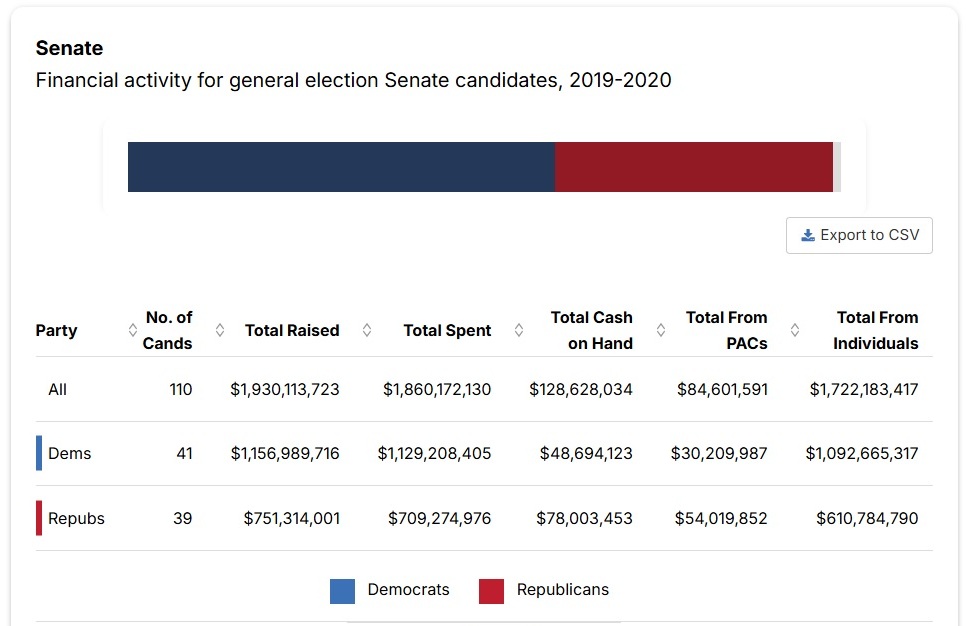 Source: OpenSecrets.org
Source: OpenSecrets.org
The current Senate terrain is not as favorable as it was in 2018, when Democrats had to play defense in most of the contested states. In 2026 Republicans have 22 seats to defend (including special elections in Florida and Ohio) while Democrats are up in only 13 states. Of those 13, just 3 present any real opportunity for a GOP gain while there are a minimum of 5 juicy targets for Democrats this time around. All things considered, the playing field is clearly tilted towards the left here.
The top (really the only) probabilities for Republican pickups are in Georgia, Michigan and New Hampshire. Democrats have a fighting chance in Iowa, Maine, North Carolina, Ohio and Texas and perhaps a couple of others, or so they claim.
Any eventual morsel of good news for Republicans, no matter how meager that morsel is ("Generic polls favor Democrats only by 5 points now instead of 6!") will cause hopium addicts on the right to begin fantasizing about Senate pickups in states such as Minnesota, New Mexico and Virginia, which they believe are purple but are in fact completely safe for leftists absent some "red" tsunami. In Louisiana, much like in Alaska in 2022, a RINO (Bill Cassidy) currently holds the seat but might be ejected by a true Republican in the primary. That wouldn't count as a pickup, but it would amount to the same thing and would bolster actual conservative representation in the Senate. It didn't happen in Alaska and probably won't in Louisiana either, but there is a chance.
Here are the 2026 Senate battleground states:
(in order of likelihood to flip, as things stand in November of 2025)
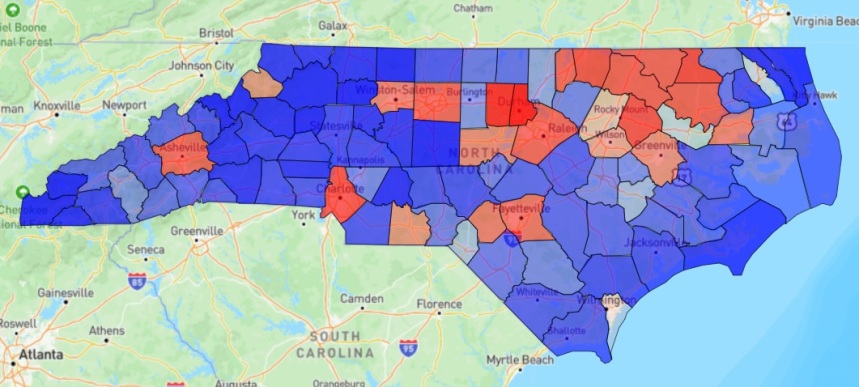 North Carolina Senate results from 2020
North Carolina Senate results from 2020
1. North Carolina:
Anti-Trump squish Thom Tillis announced months ago that he would not seek re-election to the Senate in 2026, beating GOP primary voters to the punch; Tillis decided to quit rather than being dumped in the primary. Not much more about Tillis needs to be written; we already did that here, describing Tillis' career and his increasingly RINO-ish behavior in 2025.
At the time Tillis made his retirement proclamation, Lara Trump was considered to be the best candidate to hold the NC Senate seat for the GOP. She probably still is the best candidate, but won't be running.
Numerous North Carolina congressmen were in position to be the fallback in the event that Trump opted out of the race. In what is likely to be a regrettable move (we'll find out in about a year), Republican National Committee (RNC) chairman Michael Whatley entered the NC Senate race shortly after Lara Trump passed. Whatley, despite his general ineffectiveness as head of the RNC, quickly received Donald Trump's imperial blessing, which meant that all other viable candidates might as well step aside.
Liberal former congressman Wiley Nickel was the first to jump in on the Democrat side, but he was merely a placeholder until phony moderate ex-Governor Roy Cooper made his decision to go for the Senate. To nobody's surprise, Cooper declared his candidacy in late July and within hours received millions of dollars in possibly-legal campaign donations. The latest financial reports from the FEC show Cooper with nearly 8x the amount of cash as Whatley. Cooper will probably eventually raise and spend at least $100 million here; Whatley will never get close in that department.
Though out of office for nearly a year now, Cooper is still very popular in the Tarheel State -- at least with the liberal media, who never tire of reporting how popular Cooper is. For all his alleged popularity, Cooper's electoral record isn't very impressive in this closely-divided "purple" state. He was sufficiently well-liked to win 4 terms as state Attorney General, but his percentages as Governor were 49.0% in 2016 and 51.5% when being re-elected in 2020.
Cooper's first gubernatorial win was aided by hysteria over the so-called "Bathroom Bill" which was passed by the Republican-controlled North Carolina legislature and signed by Republican Governor Pat McCrory in 2016. A bathroom bill is legislation that protects the safety and privacy of girls and women in public bathrooms against intrusion by boys or men who claim (or pretend) to be transgendered. You can understand why Democrats would be indignant about something like that.
The liberal media concocted some figures purporting to show that the bill would cost North Carolina a hillion jillion dollars in lost revenue because woke companies (like PayPal and Adidas) and woke organizations (like the NCAA) would pull out of the state. The 2016 gubernatorial election turned on this single issue, with Cooper supporting the efforts of Organized Deviancy and McCrory supporting common sense. Common sense was defeated that November, 49.0% to 48.8% with a Libertarian spoiler taking enough votes from McCrory to hand the win to the Democrat without a majority. The Republican legislature caved early in 2017 and repealed the bill.
Cooper's far-left stance on most issues is well-known to North Carolina voters despite the best efforts of the media. Republican Lt. Governor Dan Forest challenged Cooper in 2020, but lost by 4.5%. Forest was banking on voter disapproval of Cooper's authoritarian tactics during the COVID plandemic, but the voters weren't disapproving enough. Natural (or even laboratory-made) disasters seem to work in favor of Democrats in North Carolina despite that party's inept or ham-fisted approach to the problems; for example, the inept and even criminally negligent response to Hurricane Helene in 2024 -- Joe Biden's FEMA refusing to help people who had "Trump" signs in their yards (they did the same thing in Florida too), and local Democrats' relief efforts discriminating against Whites -- was supposed to be a boon for the GOP in that year's elections; Trump did win the state, but the most-affected areas in Western North Carolina actually moved to the left. Trump's win was a close one, and other Republicans on the ballot received no boost at all from the Democrats' mishandling of the hurricane aftermath.
Speaking of disasters, Whatley is likely to help fulfill the media's mission of making Cooper look more popular than ever. The Republican nominee will be grossly underfunded and largely uninspiring to the voters. Early polls are exactly as one might expect: Cooper with a lead but running under 50% for now. At least 10-15% of the electorate is still undecided, which is also what one might expect. This race is, and always has been, Cooper's to lose.
Another potential dire consequence is this: if Whatley loses convincingly next November, there are several Republican House incumbents in North Carolina who could go down with him because most GOP districts in the state are either in the tossup range or very close to it.
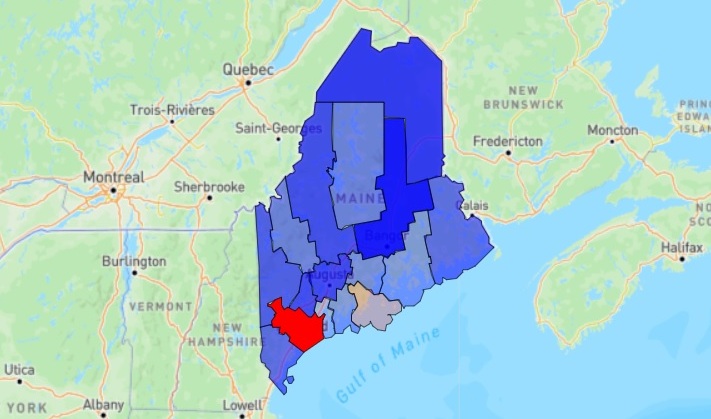 Maine Senate results from 2020
Maine Senate results from 2020
2. Maine:
The Maine Senate seat is the second most likely one to flip from being occupied by a Republican (such as she is) to one filled by a Democrat. Mega-RINO Susan Collins is currently in her fifth Senate term, and she is looking to make it 6 in 2026. Since Collins' last election in 2020, she has voted more often with Democrats than Republicans; she wasn't exactly a bargain before 2020 either. Collins is normally excused for her behavior because she represents Maine, and the GOP is hardly likely to do any better there.
Maine Republicans have little choice but to pin their hopes on Collins, because nobody who is more conservative would stand a chance in a statewide election, Paul LePage's fluke wins for Governor in 2010 and 2014 notwithstanding; the outcome of his 2022 quest for a non-consecutive third term (he got 42%) is more in line with Maine's preferences these days. It's possible that Collins won't do significantly better than 42% in 2026, but she's been counted out before. Notably in 2020 when Collins squeaked by with 51% against an ultra-liberal Democrat who raised over $75 million for the challenge (Collins barely got to $30 million). Collins received about 57,000 more votes in Maine in 2020 than Donald Trump did.
There will apparently be a two-way battle for the Democrat nomination between current term-limited Governor Janet "Butch" Mills and some guy who wants to be Maine's version of Pennsylvania Senator John Fetterman (before Fetterman began acting more sensibly and enraged the radical left): that guy would be alleged "working class hero" Graham Platner, who has described himself as a "communist" and "ANTIFA supersoldier" but denies being a "secret Nazi". We believe him. Whoever said it was a secret?
Mills ought to be the favorite in the Rat primary, but if she is it's not by much. One ludicrous poll had her down to Platner by 34 points; that poll must have been taken either on a college campus or in a media newsroom. The geriatric Mills (age 77) started her campaign by refusing to release her medical records, while Platner is suddenly raising millions of dollars from the type of people who think that the 2025 election results are a referendum in favor of killing Republicans. It's going to be quite a battle unless Mills bows out or Platner is dragged down by his past (and present). Democrat voters forgave the murderous racist in Virginia two weeks ago; Maine Democrats aren't likely to abandon any candidate no matter how much of a lunatic he may be -- as long as they think he can win next November.
Keep in mind that Maine uses Rigged Choice Voting (RCV), just like Alaska does. Imagine a 3-way race with Collins, Platner and some other leftist candidate who isn't violently nutzoid. Nobody gets to 50% initially so RCV kicks in and the comparatively moderate independent who finishes third is eliminated. Who gets his votes then?
We might not like the answer.
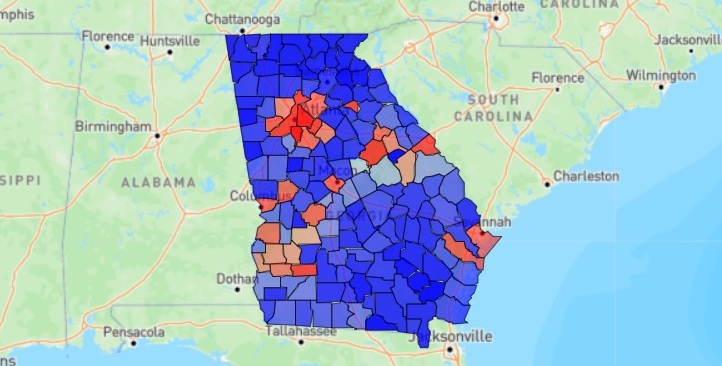 Georgia Senate results from 2020 runoff
Georgia Senate results from 2020 runoff
3. Georgia:
The incumbent Democrat, Hollywood Jon Ossoff, will once again be backed by enormous amounts of out-of-state money, just as he was in 2017 (when running for a House seat) and in 2020 when he spent over $150 million to defeat GOP Senator David Perdue. Ossoff lost in November of 2020, but won the January, 2021 runoff which was required because Perdue came up 0.3% short of 50% in the initial election. In the wake of the "questionable" (to put it mildly) presidential election results in 2020, you may recall that some GOP folks in high places were spitefully calling for Republican voters to boycott the January runoff. We've never really been sure what that was meant to accomplish, but you have to admit it worked. Hello, Senator Ossoff.
Ossoff will not have to face a primary opponent in 2026. Democrats nearly always do that -- clearing the field in situations like this, which helps their candidate and frees up Democrat voters to pollute Republican primaries in states (like Georgia) where that is permitted. In the general election Ossoff will take on one of the three current GOP frontrunners: congressman Buddy Carter (85% lifetime conservative rating), congressman Mike Collins (96% conservative) or football coach Derek Dooley; Dooley is running well behind the two congressmen. As of September 30, Ossoff (3% conservative) already had raised over $50 million with much more to come. Georgia deserves better than a couple of liberal stooges in the Senate. Republican-leaning pollsters indicate a close race, but Ossoff maintains a small lead across the board -- so far.
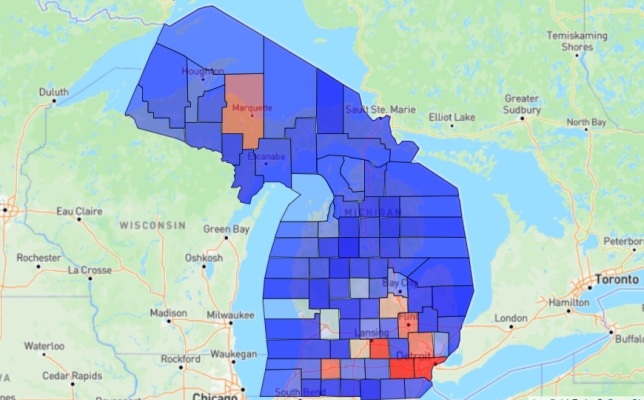 Michigan Senate results from 2020
Michigan Senate results from 2020
4. Michigan:
Michigan occasionally votes Republican for President lately (albeit by very small amounts), as it did in 2016 and 2024. It wasn't too long ago (2010 and 2014) that Michigan elected a GOP Governor; OK, Biden-supporter/Trump-hater Rick Snyder was basically a Democrat regardless of the letter after his name, but he did get elected twice as a Republican. Now here's a trivia question: when was the last time Michigan elected a Republican U.S. Senator?
The answer is. . . 1994. The have been 9 Senate elections in Michigan over the subsequent 30+ years, and the GOP is 0-for-9. The most recent two have been close; the other 7 weren't. In 2026 ex-congressman Mike Rogers is going to make a second run at the Senate on the Republican side. We covered Rogers a year ago as he was making his first run, which turned out to be unsuccessful but could hardly have been closer. Rogers lost by less than half a percent in 2024 while running 1.3% behind Donald Trump. Rogers needed to hang onto those coattails a little bit tighter, but apparently he couldn't.
Rogers' Democrat opponent, as in 2024, will be a congresswoman. Last time it was Elissa Slotkin; this time it's Haley Stevens, a far-left Democrat who once worked for Hillary Clinton and Barack Obama. Since 2019 Stevens has represented a deteriorating congressional district in suburban Oakland County, near Detroit. Stevens was first elected in the anti-Trump landslide of 2018, when the 11th district was still politically borderline. After 2020 the district was pushed farther to the left, aided by continuing demographic degradation in Oakland County. The district is now very safe (about D+11) for whatever Democrat runs there.
When Rogers lost in 2024 his Democrat opponent had a massive financial advantage, outspending him $51 million to $13 million. That chapter of the story will be the same in 2026, though as of the end of September Rogers was very close to Stevens in $$$; but the major part of fundraising season is not yet underway. Stevens will also have her hands full before (probably) moving on to face Rogers, because she has two primary opponents who are as well-funded as she is. Democrats were able to bypass a contentious Senate primary in 2024 (Slotkin had only token opposition), but that won't be the case next year. Perhaps some Democrat divisiveness will give Rogers the little extra boost he needs to become Michigan's next Senator. We wouldn't rely on it.
5. New Hampshire:
Seventy-eight-year-old Democrat Senator Jeanne Shaheen is ending her political career in 2026 after 6 years as New Hampshire Governor followed by 18 years in the Senate. After her 3 terms in Concord her string of election wins was interrupted in 2002 when she ran against incumbent Senator Bob Smith. Only it turned out that Smith wasn't her #1 opponent that year after all -- Smith lost in the primary to congressman John E. Sununu who, despite being outspent by both Shaheen and Smith, won just over 50% of the vote in the 2002 Senate election. He was the youngest member of the Senate during his term.
Shaheen won the rematch 6 years later and held the Senate seat for two more terms after that. Sununu had been out of politics since his 2008 defeat, but he's back for another go at it.
Do not confuse this Sununu with his younger brother Chris, who is the former Governor of New Hampshire (2017-2024). Also do not confuse him with his father John H. Sununu, who was George H.W. Bush's Chief of Staff. That Sununu is the one who gave us John Souter as a Supreme Court justice and who convinced his employer that "read my lips, no new taxes" was somehow not a good idea and shouldn't be taken literally. Sununu's employer's reward for following that advice was a trip to the unemployment line after 1992.
 Photo credit: John H. Sununu
Photo credit: John H. Sununu
Chris and his father are RINOs, if not outright Democrats; John E. Sununu is the conservative in the family. By "Sununu" standards, anyway. He's one of those oxymoronic "fiscal conservatives" now (i.e. anti-conservative on every other issue). There's no such thing as a fiscal conservative/social liberal. Because "social liberalism" is clearly anything but fiscally conservative when you look at how much those social programs cost.
Just as Sununu had to face an experienced senator (Bob Smith) in the GOP primary during his first run for that office in 2002, he will be facing another one in 2026 -- ex-Massachusetts Senator Scott Brown, who was a fluke winner in 2010 to replace the deceased Teddy Kennedy. Brown won 52% of the vote against Democrat Attorney General Martha Coakley. How repugnant do you have to be to lose to a Republican in Massachusetts? Coakley's done that twice. Brown started off as a moderate in the Senate, but even running hard to the left was not enough to save him in 2012. Brown did run well ahead of Mitt Romney in Massachusetts that year, and in both of his Senate races he showed an ability to run neck-and-neck against Democrats in terms of campaign cash.
Brown relocated to the north by 2014 and ran again for Senate in his new home state of New Hampshire. In that year's crowded GOP primary, one of the defeated candidates was good old (age 73) Bob Smith again. Brown came reasonably close to defeating Shaheen, but this time he was conclusively outspent and that was a major factor, as of course were the "carpetbagger" allegations though Brown was actually born in New Hampshire. Bob Smith, by the way, is still around and has endorsed Brown for 2026.
Instead of attacking each other too much (yet), both Sununu and Brown are training their artillery mainly on presumptive Democrat nominee Chris Pappas, who is currently the congressman from New Hampshire's 1st District. Pappas is in his fourth term and, like so many other liberal Democrats who seek higher office in states which are not solid "blue", has suddenly pretended to discover moderation after being nearly a 100% party-line liberal vote prior to 2025.
Sununu, who only jumped into the race recently, is the current favorite for the GOP nomination and matches up better against Pappas in general election polling. New Hampshire is about as closely divided a state as there is, but Democrats always seem to eke out victories and 2026 isn't likely to be any different. This race is definitely a toss-up, but there's a strong likelihood that the Republican will be the one getting tossed (out), albeit not by a very large amount.
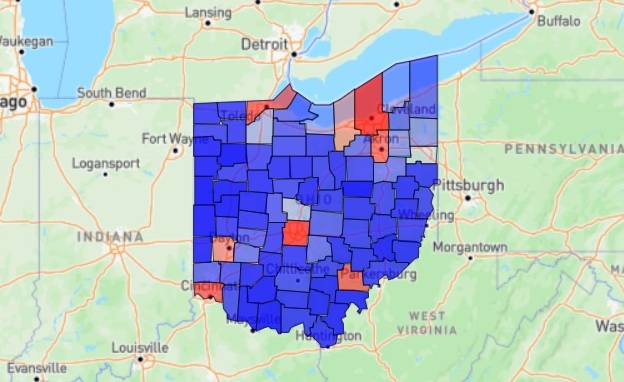 Ohio Senate results from 2024
Ohio Senate results from 2024
6. Ohio:
Ohio's 2026 Senate contest is a special election to fill the seat for the remaining two years of J.D. Vance's term. When Vance advanced to the Vice Presidency, Ohio Lt. Governor Jon Husted was promoted to the Senate via an appointment from Governor Mike DeWine. Husted entered politics at an early age (25), losing a bid for state House in 1992. He eventually served in the state House for 4 terms (becoming Speaker in 2005), had one state Senate term, was elected Secretary of State for 8 years beginning in 2011 and was DeWine's Lieutenant from 2019 until joining the U.S. Senate. Husted, now 58, is still quite young by Senate standards. During his short time in D.C., Husted has been a reliable albeit low-profile GOP vote on every issue.
Husted's Democrat opponent next November will be 73-year-old ex-Senator Sherrod Brown, who will be making his third appearance on a ballot in the past 8 years. Brown, a career politician, took a path which was somewhat similar to that of Husted, with Brown initially being elected to the Ohio state House in 1974 at the age of 21. Also like Husted, Brown was Ohio Secretary of State for several years (1983-1992). Brown won an open U.S. House seat in the Cleveland suburbs in 1992, the seat being open because incumbent Democrat Edward Feighan was implicated in the House Bank scandal which enveloped several Democrats that year, and Feighan chose to exit politics as a result.
Brown was a solidly liberal vote (lifetime ACU rating: 6% conservative) but began faking to the center in 2006 in preparation for his first Senate race. Brown defeated incumbent Senator Mike DeWine in that anti-Republican year, immediately resumed his ultra-liberal positions upon taking office in 2007, and was easily re-elected in 2012. Brown's past history of domestic (and other) violence was used against him as Brown was seeking a third Senate term in 2018. However Brown, with the assistance of his allies in the liberal media -- and a massive advantage in fundraising -- was able to shrug that off and score another relatively easy win. Those on the right expected a better outcome since Ohio had suddenly become (or so they thought) a "solid red" state now that it had voted convincingly for Donald Trump in 2016.
Brown's luck -- but not his money -- finally ran out in 2024. Brown and the Democrat Money Machine spent over $100 million to repurchase his Senate seat, but Republican Bernie Moreno was able to ride Trump's coattails to a 3.6% win after trailing in all polls until October. Moreno, though outspent 4:1 and overwhelmed by Brown's advertising presence in all types of media, won every Ohio county except the urban ones, one suburban county (Lorain) near Cleveland, and the academic wasteland of Athens County (University of Ohio). Moreno prevailed by over 200,000 votes in all.
With Ohio Democrats having nowhere else to turn in 2026 -- ex-congressman Tim Ryan declined and so did a couple of ghetto congresswomen -- Brown was tabbed to try to regain the Senate seat he occupied as recently as a few months ago. Ryan had run for the Senate in 2022 against Vance and suffered a humiliating loss despite having the usual astronomical cash and media advantages which accrue to Democrats even in GOP states.
It's not quite accurate to say that Ohio Democrats had nobody else willing and (financially) able to oppose Jon Husted. A Cleveland-area millionaire Democrat named Fred Ode jumped into the Democrat primary back in August and prepared to invest $5 million of his own money to show he was serious. Ode entered the Democrat primary because he feels that "old-school" Democrats like Sherrod Brown are not filled with sufficient hatred of Donald Trump and all other Republicans. For that reason, Ode believed that someone like Brown was unlikely to win against Husted next year. Ode definitely has a point about hatred being the ultimate motivator for Democrat voters (or have we already forgotten the election results from earlier this month?).
However just a few days ago Ode suddenly and mysteriously aborted his campaign which was still in its first trimester. Clearly angry (apparently as usual for him), Ode still did not give a reason. Perhaps Ode made his decision after finding a decapitated horse's head in his bed one morning? The Democrat establishment is every bit as capable of hatred and violence as the insurgents from the far left. Radicalism may work well for Democrats in New York City and California and (soon) Maine or even Texas -- and don't forget Virginia now -- but not necessarily in middle-America, apple-pie Ohio. Democrat leaders feel that their chances in Ohio are much better with Brown than with Ode or someone like him.
For 2026, early polls showed Husted moderately ahead of Brown but recent Democrat-leaning polls have it pretty much a tie. Ohio, along with Maine and North Carolina, could flip from R to D next year and result in a 50-50 tie for the Republicans in the Senate if those losses are not offset elsewhere. Any additional Republican losses in the Senate would hand control to Democrats. With the Senate almost within their grasp, Democrat billionaires will be tossing around campaign cash like never before, and things like a Republican being outspent only by a margin of 4:1 will seem quaint.
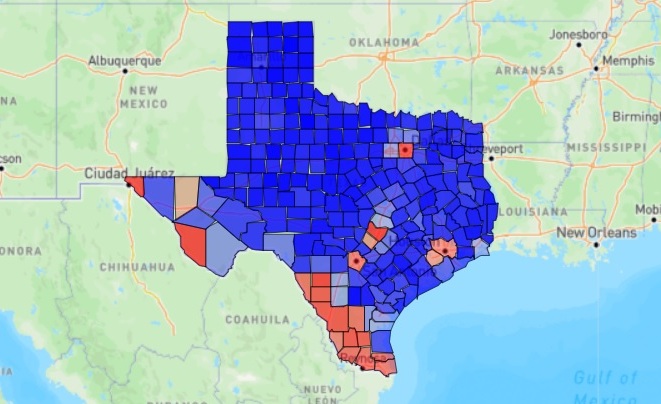 Texas Senate results from 2020
Texas Senate results from 2020
7. Texas:
The 2026 Senate race in Texas will feature spirited primaries on both sides, which is not a common thing in recent years. While it's true that Republicans often conduct a no-holds-barred donnybrook on their side (costing a considerable amount in money, and in hard feelings afterwards), Democrats regularly attempt to whittle down the number of candidates in any statewide election, whether for the benefit of a Democrat incumbent -- especially a vulnerable one -- or to anoint a "chosen one" to be their standard-bearer without interference from pesky voters. They even take that approach for presidential elections sometimes. There are several smart reasons why Democrats do this:
- It avoids a bloody primary fight in which even the winner suffers potentially mortal wounds, and is therefore less effective in the general election because of those wounds.
- It saves money (not that Democrat campaign funds are ever scarce) which can be used to greater effect in the general election.
- With diminished reason to vote on the Democrat side in the primary, this tactic frees up Democrat voters to sabotage Republican primaries by participating in those, in order to try to select the weakest possible GOP opponent. Even so-called closed primary states are not immune to this.
On the GOP side in Texas in 2026, we'll have incumbent senator John Cornyn vs. state Attorney General Ken Paxton vs. congressman Wesley Hunt. On the left, we'll have ex-congressman Collin Allred (back for a second try at higher office) vs. state House member Holy James Talarico. A late addition to the tag team could be congresswoman Jasmine Crockett, the self-appointed moral voice of the shrieking, hysterical (but dominant) wing of the Democrat party, and darling of the radical-left media. She believes herself to be the Texas version of AOC, and presumably considers that designation a complement.
Crockett already has raised at least $6.5 million (which is more than Talarico or Allred have done), and that's far more money than necessary for her to run in some little House district which is rated at least D+10 and will have no viable GOP alternative. It certainly looks like she's running for the Senate, but we'll have to wait to find out for sure. Queen Latifah Crockett has declared that she will make her solemn pronouncement at the filing deadline, which is December 8.
What reason would there be for her to not run for Senate? Aside from avoiding the risk of losing in the Senate primary, Crockett may realize that another easy House win in her district -- combined with the reasonable likelihood of Democrats taking control of the House after 2026 -- would give her a position of greater power and perhaps a juicy committee chairmanship. Worst-case scenario for Crockett is that she loses the Senate primary, is out of Congress starting in 2027, but then is hired by "The View", which obviously can never have enough shrill, unattractive women on its panel.
 Photo credit: splinter.com
Photo credit: splinter.com
Talarico describes himself as a deeply religious Christian, but is a phony who spouts that "Jesus-was-a-liberal" bullshit a la the self-righteous "He Gets Us" television ad campaign, which you may have seen. Picture Talarico as a combination of Bernie Sanders and Jimmy Swaggart (apologies to Swaggart). Talarico the "True Christian" adamantly opposed displaying the Ten Commandments in Texas schools, preferring that those institutions remain atheistic and free from anything which might accidentally encourage good moral values. He represents an ultra-liberal (D+26) Austin district in the state House, so Talarico's views are surely considered to be mainstream by his constituents but most of the rest of the state of Texas would disagree. Talarico is a one-trick pony, wearing his version of far-left Christianity on his sleeve at all times and using it to explain all of his immoral, pro-abortion, pro-crime and other radical votes in the legislature. He surely believes he can "out-liberal" and "out-hate" Crockett and Allred, but he's got his work cut out for him in those departments.
Colin Allred we already know about (click here for more info) from his 2024 Senate attempt. He is a former Dallas-area congressman who was first elected in Congressional District 32 in 2018 when Dallas County swung hard-left in elections that year. The Texas GOP did him a "solid" in 2022 by extending his district up into left-trending Plano (there is an ongoing massive influx of Muslims and Hindus into southern Collin County) and down into ghetto Balch Springs. Previously CD-32 was a D+1 district but became safely D+13 after the new leftist areas were added. Republican redistricters did this favor not so much for Allred but for themselves, sacrificing that district so that adjacent ones like CD-3, CD-5 and CD-24 would be safer for Republicans. When Allred left the House in 2024 to run for the Senate against Ted Cruz, the GOP didn't waste any resources trying to reclaim CD-32. But Allred wasted $94 million in his attempt to acquire a seat in the Senate.
Senator Cornyn is a squish but he is always a well-funded one. The 73-year-old has been in the Senate since 2003. He compiled a conservative voting record during his first two terms, but now has become so unreliable (i.e. "moderate") that he was actually eligible to apply for the job of Senate Majority Leader after Mitch McConnell stepped aside. No true conservatives need apply for that position, which was won by John Thune in a November, 2024 secret ballot of GOP senators. The outcome was said to be close. Cornyn has been in a panic throughout 2025, awkwardly trying to appear conservative (at least through next March's primary), furiously raising money and becoming more popular with the media as he and his allies toss allegations at his closest challenger, Ken Paxton.
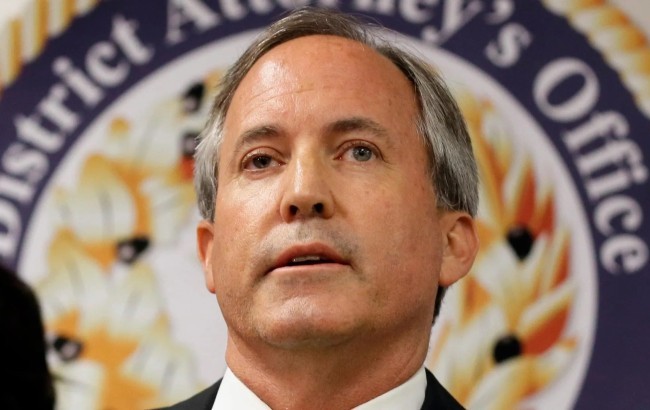
This is nothing new for Ken Paxton. The former state legislator was first elected as Texas Attorney General in 2014, succeeding Greg Abbott in that office as Abbott stepped up to become Governor. The solidly-conservative Paxton quickly showed that he was (and still is) one of the most effective A.G.'s in the entire country. However he is much too effective to suit the RINOs who perpetually have control of the Texas GOP and the Texas state House; Democrats loathe him even more than RINOs do.
The GOP establishment failed to stop Paxton from being elected to a third term in 2022 although they recruited a clueless geriatric congressman (Louie Gohmert) along with Land Commissioner George P. Bush, who is the son of former Florida Governor and momentary (2016) presidential candidate Jeb! Bush. The plan in 2022 was that RINO Bush and Clueless Gohmert and one other hopeless candidate would combine to steal enough primary votes to force Paxton into a runoff where he would either be defeated or severely damaged. The establishment strategy worked, up to a point.
Paxton dominated the runoff against Georgie P. and then won by nearly 10 points in November against the Democrat; all Texas statewide Republican candidates did better than expected in 2022, with Paxton having the closest race of any of them and it still wasn't very close. Maybe it was the "Beto Effect", with Beto the Bozo (D) helpfully running statewide again, and this time being demolished by Abbott, 55%-44%.
Having failed in their 2022 assignment, Texas RINOs led by state House Speaker Dade Phelan and Rep. Andrew Murr impeached Paxton in 2023. Other RINOs joined the Phelan-Murr witch hunt, and Paxton ended up on the wrong end of a 121-23 vote in the House; 60 of those 121 votes for impeachment came from "Republicans". However the Texas state Senate, which is not RINO-controlled, was tasked with completing the impeachment process. During the Senate hearings, one witness who accused Paxton admitted he actually had "no evidence" whatsoever of wrongdoing. Another witness conceded that the claims of malfeasance he made against Paxton were about things he "didn't know whether [they] were true or not", but he regurgitated them anyway. No credible evidence was presented at all. Mere accusations against a Republican are normally sufficient for conviction, but the Senate wasn't buying it this time. In September of 2023 Paxton was acquitted of all charges.
With his enemies living in mortal terror of Paxton becoming a U.S. Senator, the smear campaign against him has ramped up again in 2025 since he announced his run against Cornyn in April. The smear campaign seems to be having an effect, judging from the polls. Paxton has only a slight lead over the unpopular GOP incumbent, Cornyn, and is only neck-and-neck with Allred in hypothetical general election polls. Our opinion is that Paxton is so good at what he is currently doing (you can tell by the amount of hate he receives), that we'd be much better off with him in a fourth term as Texas Attorney General rather than a first term as a U.S. Senator.
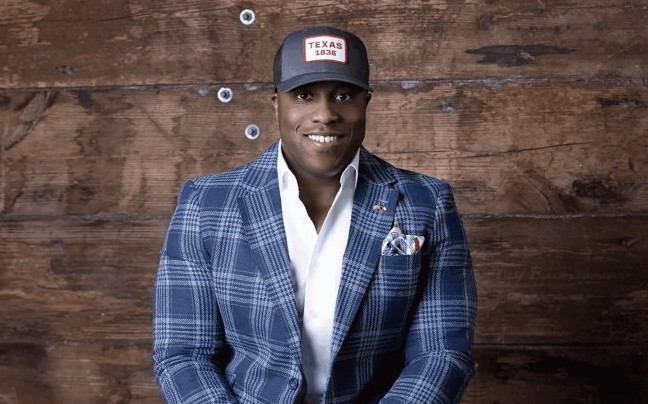 Photo credit: Texas Scorecard
Photo credit: Texas Scorecard
As noted above, the GOP primary is not just a 2-way race anymore. In October, congressman Wesley Hunt announced that he would abandon his safe (R+10) district in the suburban Houston area and join the Senate race. The 44-year-old Hunt has a fine military background, graduating from West Point in 2004, serving 8 years in the U.S. Army before earning 3 Masters' Degrees, and then entering politics. Hunt's first bid for Congress came in 2020 in the deteriorating 7th District and was unsuccessful though he made a solid showing (47.5%) under difficult circumstances. When the new 38th District was created in 2022 in approximately the same area, Hunt won a majority in a crowded 10-way Republican primary and then easily sealed the deal in November. Hunt was re-elected in 2024 with only token opposition, and has been a reliable conservative vote in the House. He currently trails his primary opponents in fundraising (and is way behind the wealthy Democrats) but he's only been in the race for about 6 weeks.
Although Texas remains a relentlessly "purpling" state due to demographic changes caused by invaders both domestic and foreign, most forecasters agree that -- as things stand now -- Republicans should be able to hold this Senate seat in 2026. We concur, although the GOP winning percentages are more likely to be in the same range as they were in Texas from 2016-2020 (~50-55%) than their slightly higher levels (sometimes 55-60%) from 2022-2024.
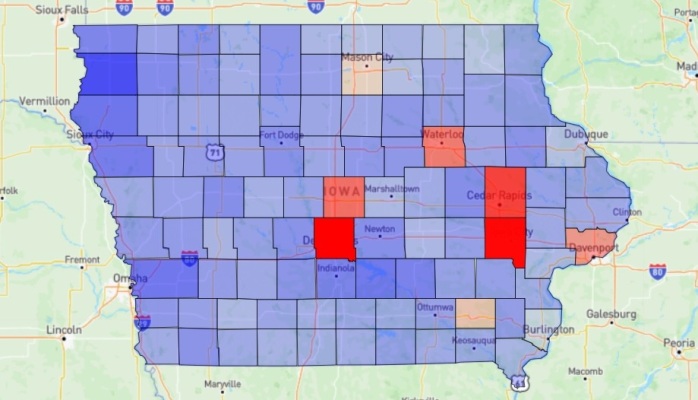 Iowa Senate results from 2020
Iowa Senate results from 2020
8. Iowa:
Moderate GOP incumbent Joni Ernst is calling it quits in the Hawkeye State after two Senate terms during which she moved gradually but perceptibly to the left. President Trump attempted to prevail upon Ernst to run one more time, but she declined and decided to proceed with her retirement (shades of 2018, egad!). Ernst, who is probably the only pig castrator currently serving in Congress, has been described as a "fiscal conservative". That's far more letters than are necessary to spell "RINO".
The supposed Democrat heavyweight in Iowa -- i.e. a Democrat who can actually get elected -- is state auditor Rob Sand. But he's running for Governor in 2026, not for the Senate, and he's not some electoral wizard anyway. Sand won in the hyper-Democrat year of 2018 with 51% of the vote and held on by his fingernails (50.1%) in 2022 after outspending his Republican opponent by a mere 40:1 ratio.
Ernst's withdrawal is a golden opportunity for the GOP to find a true conservative as a replacement. Or at least it would be, if they cared to try. Instead, squishy congresswoman Ashley Hinson is the clear favorite among Republicans. Not only would the Senate be an obvious step up for Hinson, but she may be figuring that getting elected statewide in Iowa could be less difficult than being re-elected in her marginal congressional district. There's a possibility that Hinson will have primary opposition from Iowa state House Speaker Pat Grassley. That last name may sound familiar. Patrick may choose to try to join his 92-year-old father in the Senate, but for now he is not running. Several low-level Democrat candidates are amassing funds to take on Hinson, and although they may be low-profile their campaign accounts are growing daily. This race is not likely to be the slam-dunk that some might anticipate, but Hinson is favored at this time.
Tags:
2026
Senate
North Carolina
Maine
Georgia
Michigan
New Hampshire
Ohio
Texas
Iowa
|
|
11/13/2025:
An Electoral S.A.T. Math Question: "2025 Is To 2017 As 2026 Is To ____ ?"
[RightDataUSA]
|
The election results from November 4, 2025 bear a striking resemblance to those from November 7th of 2017. In the aftermath of the 2025 Democrat sweeps in Virginia, New Jersey, New York City -- and elsewhere -- most right-wing analysts are trying to appear calm as they whistle past the graveyard in their attempts to dismiss the disaster as "completely expected", "limited to 'blue' states", "unimportant" and, most of all, "meaningless as far as next year's midterms are concerned".
If that's what most analysts are claiming, then most analysts are wrong.
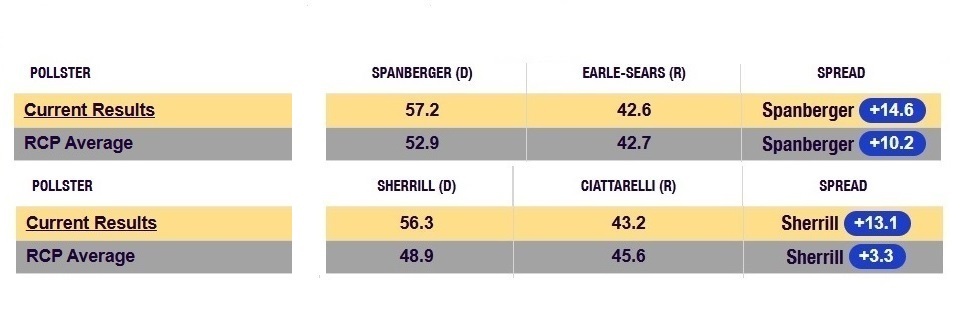 The polls sure were wrong -- but not the way we wanted them to be.
The polls sure were wrong -- but not the way we wanted them to be.
"Completely expected":
An election day puff piece about new RNC Chairman Joe Gruters claimed there were going to be "close contests for Governor in New Jersey and Virginia" and Gruters trumpeted GOTV efforts by Republicans in those states. Of course the races turned out to be not so close except in some pre-election outlier polls like this one, and the GOTV effort was apparently quite insufficient. The margin of defeat was so great that even the usual "Frodd! Frodd! Frodd!" claims aren't being made, except by those for whom facing reality isn't exactly a strong point. This isn't 2020.
Numerous prognosticators understood that the GOP candidates were likely to lose this year in VA and NJ, but who the hell had 13 points as the margin of defeat in New Jersey? We sure didn't. One ridiculously biased Rutgers poll back in June had Ciattarelli losing by 21 points, however polls which showed him neck-and-neck with the Democrat Top Gun were also way off the mark. Most New Jersey pollsters had forecast a race that would wind up within, or close to, the margin of polling error.
In Virginia, only hardcore GOP surveyors such as Trafalgar ever had Winsome Sears coming within spitting distance of the Governor's mansion in Virginia, and as election day loomed, even they bailed on her chances. Trafalgar still had the Virginia Lt. Governor race being close (it wasn't), and had Jason Miyares being narrowly re-elected (he wasn't) as Attorney General against savage Democrat Jay Jones.
 Possibly thinking: "Wow, the voters agreed with me! Republicans (and their children) DO deserve to die!"
Possibly thinking: "Wow, the voters agreed with me! Republicans (and their children) DO deserve to die!"
Regarding the Republicans' gubernatorial defeats: it's one thing to be expected to lose, it's another thing to be completely obliterated and to have the calamity permeate the entire election ballot to the point where Republicans also hemorrhaged seats in the Virginia House of Delegates and the state Assembly in New Jersey.
Given the Democrat gerrymander of the state House maps in Virginia, we mentioned that Republicans had done well to keep the partisan balance close in prior elections. It ain't close no more. Democrats picked up 13 seats.
In New Jersey the GOP, which came into November with only 28 out of 80 Assembly seats, has lost at least 3 more and 4 races (all seats held by Republicans) are still uncalled so there is the potential to wind up at minus-7 though a more likely end result is minus-5 (23 R, 85 D). The degree of Democrat gerrymandering in New Jersey state-level districts points to 23-25 R seats as an approximate expectation, which means -- like in Virginia -- Republicans had actually been slightly overachieving before 2025.
"Limited to 'blue' states":
Pennsylvania is a state Trump won twice, and there has been considerable publicity over Republican voter registrations growing while Democrats lag. Twelve short months ago Pennsylvania also ousted a well-entrenched liberal Democrat from the Senate, and somewhat thwarted the PA Democrat gerrymander of U.S. House seats by finally winning a couple of closely-balanced districts in the eastern part of the state after failing to do so in three previous attempts. The Keystone State is supposed to be "purple" now, not blue.
Last week there were crucial elections regarding three geriatric ultra-liberal justices on the PA Supreme Court. These three, and their liberal colleagues, are wholly responsible for (among other atrocities) the hyper-partisan Democrat gerrymanders which exist at all levels in Pennsylvania. These gerrymanders were dictated by the court, which:
- In 2018 overthrew the legitimate congressional district map which had been created by the GOP state legislature in 2011.
- Replaced that map with a Democrat gerrymander which was put into effect for the 2018 midterms. It cost Republicans 4 House seats and almost became 6.
- Overruled the GOP legislature and sided with Democrats again in 2022. First, they used the Democrat-gerrymandered 2018 map as a basis for the new districts, and then revised that map to take away one more seat from Republicans. Secondly, they overruled the legislature's state-level district maps and replaced them with Democrat gerrymanders which cost the Republicans 13 seats in the state House when that map was first used in 2022 -- 13 being exactly the number of flipped seats which was required to give Democrats control.
 In 2025, Democrats cemented their control of the PA Supreme Court for years to come.
In 2025, Democrats cemented their control of the PA Supreme Court for years to come.
Pennsylvania voters had the opportunity to send those judges packing. Instead, all three judges who were up for retention were overwhelmingly returned (by nearly 25-point margins) to the court for another 10-year term. The PA Democrat Supreme Court thus maintains its 5-2 majority, and one of the two Republicans on the court barely qualifies as such; there is only one true Republican out of seven judges on the PA Court.
In Georgia, which like PA is hardly a solid "blue" state (yet), Democrats scored shocking upsets in two statewide races for the unimportant-sounding office of Public Service Commissioner. Republican incumbents in Districts 2 and 3 were up for re-election, and both got stomped by 25 points with over 1.5 million votes cast in each race.
Pundits on the right have told us in the past that special election losses in tiny state House districts in which not even 3,000 votes were cast were actually of vital importance as far as the GOP "learning lessons" from the defeat. Would they now say we should ignore or deliberately misinterpret election outcomes (not just the ones from Georgia and Pennsylvania) in which millions of votes were cast?
"Unimportant". . . "Not a big deal":
Virginia, like some other solid "blue" states, is considering congressional re-redistricting. Virginia Democrats, soon to be in complete control of state government, would like to imitate California and disenfranchise Republicans via extreme gerrymandering. The results from last Tuesday surely embolden those Democrats. A small minority of New York City voters just elected a radical alien socialist as mayor. Tell the good people of California, Virginia and New York City that these results are "not a big deal".
But the tiny, fragile twig that GOP pundits are seriously attempting to hang their hats on is this one:
These results mean nothing for the future because "things change", "twelve months is an eternity in politics", blah blah blah.
Platitudes, wishful thinking and other drivel are a poor substitute for actual analysis. On this website, we look at data rather than "feels". With the results from 2025 being so uncannily similar to the ones from 2017, it would be idiotic not to examine the results from 2018 and see how they might be pertinent to the upcoming 2026 midterms even if those midterms are "an eternity" away at this moment.
The similarity of 2017 to 2025 is parallel to the relationship between 2016 and 2024. In 2016 Donald Trump won the presidency with 304 electoral votes and took 30 states. He won 45.9% of the popular vote. In 2024 Trump won the presidency again, this time with 312 electoral votes and 31 states (adding Nevada). He received 49.7% of the popular vote, the improvement coming not at the expense of his Democrat opponent but from the deterioration of third-party candidates, whose vote share was 4% less in 2024 than it had been in 2016. Kamala Harris actually took a greater percentage of the popular vote (48.2%) than Hillary Clinton had (48.0%).
The parallel doesn't quite carry over to the House, where Republicans were in much better shape after 2016 than they are after 2024 (a net loss of 21 seats). But that's mainly because of what happened in 2018 -- which is the whole point here -- with the GOP losing many seats. Those losses were only partially offset in 2020 and 2022. After 2016 Republicans controlled the Senate by 52-48. After 2024 they now have a 53-47 advantage. That's pretty similar.
Having compared 2024 to 2016, let's now shift one year and consider 2025 vs. 2017. Because 2021 was a significant factor in the false optimism which accompanied future elections in New Jersey and Virginia, we will show data for that year as well.
2017:
- NJ Governor: D+14.1%, 2.15 million total votes
- NJ Senate: D+1 seat
- NJ Assembly: D+2 seats
- VA Governor: D+8.9%, 2.61 million total votes
- VA Lt. Governor: D+5.5%
- VA Attorney General: D+6.7%
- VA Senate: no scheduled elections in 2017
- VA House of Delegates: D+15 seats
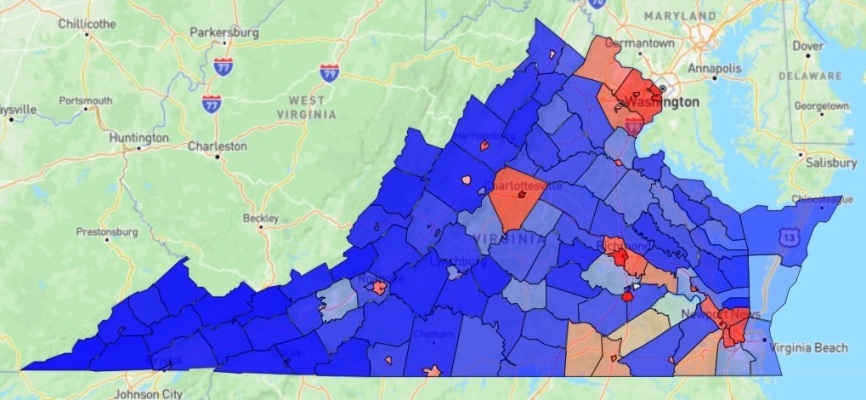 Happier days: 2021 gubernatorial election results in Virginia
Happier days: 2021 gubernatorial election results in Virginia
2021:
- NJ Governor: D+3.2%, 2.61 million total votes
- NJ Senate: R+1
- NJ House: R+6, resulting in more seats for the GOP in the NJ Assembly than anytime since 2003
- VA Governor: R+2.0%, 3.29 million total votes
- VA Lt. Governor: R+1.5%
- VA Attorney General: R+0.8%
- VA Senate: no change
- VA House of Delegates: R+7 seats, retaking control
Adding to the false hope in NJ was Trump losing by "only" 5.9% in 2024 and Curtis Bashaw losing by only 9.7% for the Senate. Also there was a voter registration shift to the right, a net change of 100K between 2022 and 2024, but the Rats were still up 900K (13.5%). In 2025 things improved, with the GOP being down 855K and 12.9%. Whoopee. As far as the 2025 elections in New Jersey were concerned, that wasn't false hope -- that was no hope. Turnout helped Republicans overcome some of their disadvantages in NJ in 2021 (registration deficit and state-level gerrymander) but things would return to normal in 2025 despite the indications from some occasionally cheery -- but sadly inaccurate -- pre-election polls.
In Virginia there was an actual basis for hope after 2021 -- for a little while. There are no partisan voter registration stats to go by, however the election results were so encouraging that Republicans were expecting further gains in 2023 and 2024. In 2023 they failed to pick up the one state Senate seat they needed to get to 20-20 (GOP Lt. Governor would break the tie), and they lost 3 seats in the state House of Delegates, which was the exact number required to lose the House, giving Democrats full control of the state legislature and derailing any agenda GOP Governor Glenn Youngkin may have had.
In 2024 Trump reduced his deficit from 10.1% to 5.7%, but his margin of defeat (260,000 votes) was still the second-worst of any GOP candidate in Virginia history, second only to Trump in 2020. Even in percentage terms it was the worst (aside from 2020) of any GOP nominee since Goldwater in '64. False hope extended to the 2024 senatorial campaign of Republican Hung Cao, whose 2022 showing as a House candidate in CD-10 was considered to be impressive. He lost by merely 6.5% that year in a district which was designed to give the Democrat a 10-12 point win. Whoopee again. Many delusionals thought that Cao could keep it close against Timmy Kaine in 2024, but few polls ever had him within single digits. Cao "overachieved" again. He only lost by 9 points.
There was no false hope regarding GOP chances in Virginia in 2025; there was no hope at all aside from perhaps the Attorney General race. Polls showed a tossup but it turned out that a majority of Virginia voters agreed with the Democrat candidate on the pertinent topic of slaughtering Republicans and their children.
2025:
- NJ Governor: D+14.1%, 3.23 million total votes so far
- NJ Senate: no scheduled elections in 2025
- NJ Assembly: D+3 seats at least, giving Democrats their highest total since 1973
- VA Governor: D+14.8%, 3.38 million total votes so far
- VA Lt. Governor: D+11.1%
- VA Attorney General: D+6.2%
- VA Senate: no scheduled elections in 2025
- VA House of Delegates: D+13 seats (all of them tossup districts, only 1 of which was an open seat)
Republicans can be thankful for the lack of state Senate contests in NJ and VA in November, 2025; they couldn't lose more seats there if there weren't any elections.
2025 New Jersey gubernatorial results by region:
The above results for the 2025 Governor election are of course still unofficial (data as of 11/10) but are at least 95% complete in most counties. We defined the regions of New Jersey here: November 2025 Gubernatorial Elections -- New Jersey & Virginia.
The Republican percentage of the vote collapsed to pre-2021 levels in all regions, even if not quite (in some areas) as bad as the GOP percentages from 2017 . Only in the Central Coast area did Jack Ciattarelli compare favorably at all to his results from 2021. In every other region of the state he finished well behind not only his surprisingly competitive 2021 performance but also behind Trump's mediocre showing in 2024. GOP results in the critical (and supposedly right-trending) northern part of New Jersey were especially disappointing. South Jersey was also a disaster for Ciattarelli. He had come barely one point away from winning that region in 2021 but lost it by a whopping 15 points last week. As we predicted, turnout in the ghetto areas of New Jersey returned to normal from the 2021 dropoff. That certainly wasn't good news for the Republican, but his problems were hardly confined to the worst areas of the state. Also, slightly-improving voter registration figures apparently aren't a guarantee of electoral success -- especially when those voters decline to participate.
 Artist's conception of the GOP's 2018 election results
Artist's conception of the GOP's 2018 election results
Back to 2018:
A preview of the upcoming Republican disaster came one month before 2018 got underway, when Judge Roy Moore lost the special U.S. Senate election in deep "red" Alabama. Senator Jeff Sessions had resigned the seat early in 2017 to become Trump's first Attorney General, and Luther Strange was appointed as Sessions' replacement. An acrimonious 3-way Republican primary occurred, in which congressman Mo Brooks was relegated to third place due to demonstrating insufficient fealty to President Trump. Moore and Strange slugged it out in the runoff with Moore advancing to face unknown liberal Democrat trial lawyer Doug Jones.
Moore, a controversial figure to begin with due to his conservative views, was falsely accused of sexual indiscretions during the 2017 campaign. Five years later, well after it mattered electorally, Moore won his defamation lawsuit against a Democrat PAC. Five days before the December, 2017 election the Democrats ousted their own sexual predator, Al Franken, from the Senate (knowing he would be replaced by another Democrat, without an election being held) in order to try to obtain "credibility" for their attacks on Judge Moore. Mo(o)re importantly, they outspent the GOP nominee in Alabama by a factor of over 4:1. Jones won by 1.7% and was a reliably liberal senator for three years before his inevitable defeat in 2020 by Republican Tommy Tuberville in a 60%-40% landslide as Alabama returned to normal.
An ongoing story throughout 2018 was the number of Republican incumbents in the House of Representatives who suddenly decided that they would not seek re-election in November. There were 23 Republicans who declined to run again for any office, and 11 other House Republicans who chose to run for a different office. Many of these 34, such as former House Speaker Paul Ryan, were anti-Trump moderates or liberals in marginal districts who were content with the prospect of potentially being replaced by Democrats.
When trying to explain the debacle which resulted that November, with the GOP losing 40 House seats, the voluntary exodus was a convenient excuse albeit a false or at least incomplete one. Of the 34 Republicans who walked away in 2018, only 10 of them were replaced by Democrats. That's a considerable number, but a far cry from 40.
The far bigger reason for the Republican party demise was the 30 incumbents who ran for re-election and lost. Seven of the total of 40 GOP losses occurred in California, which had just legalized a new form of Democrat electoral chicanery known as "ballot harvesting". That tactic allows ballots to be collected and counted for weeks after election day. Of the 7 Republican seats which evaporated in CA, at least 5 of them required "extra time" for the Democrat to eventually prevail.
In 2018 the Real Clear Politics generic congressional polling final averages were GOP 44.9%, Democrat 53.3%. That polling could hardly have been more accurate -- after all the ballots were finally counted, the House vote share was GOP 44.8% (was 49.1% in 2016), Democrat 53.4% (was 48.0% in 2016). In case you're wondering about 2026 at this point, the current RCP congressional polling averages are GOP 42.0%, Democrats 46.1%. There are still lots of undecideds 12 months out from the election, but that 42.0% mark is abysmal. The whistlers past the graveyard now have another data point to ignore if they intend to remain adamant that 2026 can't possibly be as bad as 2018 was.
 Senate results from 2018
Senate results from 2018
The House went up in flames but Election Night 2018 was a good one for Republicans in the Senate. Good, but not great. The 2017 GOP defeat in Alabama had left the Republicans with a narrow 51-49 majority. In 2018 they picked up 4 Senate seats (FL, IN, MO, ND) but also lost a pair of seats which they had previously held (AZ, NV) for a net +2. For a little while there also seemed a possibility of the GOP losing Thad Cochran's seat in Mississippi.
The two defeats combined with their fumble of two other anticipated pickups (MT, WV) to render the overall Senate outcome as a significant disappointment for Republicans. There were unrealistic prospects of seizing other Senate seats (MI, OH) as well, leading some dreamers to anticipate up to an 8-seat gain. Viewed in that light, +2 tasted rather bitter indeed and Democrats were relieved that it hadn't been worse.
Somewhat lost in the mourning over the House catastrophe and the missed Senate opportunities were major Republican losses at the state level in 2018. Not only did the GOP suffer a loss of 7 governorships (IL, KS, ME, MI, NM, NV, WI) but they were decimated in state legislatures as well. Republicans went a net minus-66 in state Senate seats that year (losing control in CO, ME, NH & WA), and minus-251 in state Houses (losing control in MN and NH).
If 2026 turns out to be a 2018-type bloodbath, don't discount the impact further down the ballot.
Here, at last, is how the playing field stands as we head into 2026:
Before we look at the prospects for the House in 2026, let's quantify what happened in 2018. In 2018 there were 80 districts (out of 435) across the nation which we would classify as marginal -- being in the range of D+5 to R+5. Those 80 are worth examining because they were the districts most likely to change hands. During any kind of "wave" election, as we saw in 2018, obviously more of them will change hands. Districts which are outside the marginal range are normally considered safe unless there is a wave of unusual intensity or there are other circumstances which make an incumbent vulnerable despite the lean of his district.
Some facts about those 80 marginal districts in 2018:
- 27 favored Democrats, 10 were rated as completely even, and 43 were Republican-leaning
- 23 districts had a Democrat incumbent who ran again and won
- 16 districts had a Republican incumbent who ran again and won
- 5 districts had a Democrat incumbent who did not run again -- Rats held all 5
- 10 open Republican seats were won by Democrats
- 1 Republican was able to hold an open GOP seat (Paul Ryan's old district, WI-1)
- 2 Republicans won open Democrat seats, both of which were in Minnesota
- 23 Republican incumbents were defeated
Additionally, Republicans lost 8 House seats which were not in the marginal range and were assumed to be at least moderately safe. Six of those 8 districts saw GOP incumbents bite the dust; only 2 were open seats (one more dagger in the feeble "we lawst just coz of all the re-tyre-mints!" argument).
The above data illustrates the impact of the 2018 "blue" wave in the House. Even though the 80 marginal districts tilted slightly to the right on average, Republicans still managed to lose 61 of the 80. And on top of that the 8 others which were supposed to be safe-ish. That's what a massacre looks like, so you'll recognize it if you see one again in 2026.
As noted, the "marginal playing field" was tilted towards the Republicans in 2018. If the parties had won every tossup district in which they were favored and then split the 10 even districts, Republicans won have won 53 out of those 80 districts instead of just 19 of 80, a difference of 34 seats. Give the GOP 34 more House seats in 2018 (they would've had control, 234-201) and suddenly the second half of Trump's first term looks a lot different.
We have looked at all House districts for 2026, factoring in new maps in Texas, Missouri, Ohio, North Carolina and California and we are assuming they are not overturned in court prior to ever being used. Try to look surprised when the partisan Democrat gerrymander in California passes judicial muster but Republican maps elsewhere do not.
A new Democrat gerrymander was just approved on November 11 by a liberal judge in heavily-Republican Utah, which creates two more marginal districts (not being counted here yet) and very well could cause two Republicans to lose in 2026.
In Utah.
Pending upcoming Democrat gerrymanders which are still on the drawing board in states like Virginia, Maryland, Illinois and Colorado, and pending the much-anticipated Supreme Court ruling which may remove the requirement for certain states to create anti-White districts, here is how the House battleground is taking shape for 2026:
There are currently 91 House districts which fall into the D+5 to R+5 range according to our ratings. We count 41 of those districts as having GOP incumbents and 41 with Democrat incumbents. The remaining 9 districts have no incumbent running, and that number will increase over the next few months. Including currently open seats, Republicans must defend 45 districts and Democrats 46. That's about as even a breakdown as can be.
The likely effects of the ongoing redistricting currently are:
- California: + 4 safe Democrat seats, and there is only 1 marginal seat (Democrat-leaning, that's how they figure +5 in all) in the entire state; it's now held by a Republican. This leaves 47 (!) almost perfectly-safe Democrat seats here, barring any miracles. This is an incredible accomplishment -- screwing Republicans massively while at the same time shoring up every single Rat incumbent who might have been even remotely endangered (e.g. Josh Harder, Adam Gray, Jim Costa, George Whitesides, Derek Tran, Dave Min). All six Democrats on that list are breathing much easier as of last Tuesday.
- Missouri: +1 safe GOP seat, 1 currently marginal GOP seat becomes slightly safer and just barely exits tossup range.
- North Carolina: Nothing much happened here despite all the wailing from Democrats and high-fiving from Republicans. One marginal Rat-leaning seat becomes a marginal Republican-leaning seat -- but numerous GOP seats in North Carolina (practically every single one of them) are marginal too or very close to that threshold, so if there is ever a "blue wave". . . look out.
- Ohio: No substantial changes to any district, much to the disappointment of Republicans. GOP cowards (fearing some black-robed tyrant, perhaps?) created a new map which doesn't ensure their party any gains at all. They can still pick up 2 or 3 seats anyway, but they could have done that even in 2022 or 2024. The seats were there for the taking, but Republicans blew it both times in CD-1, CD-9 and CD-13.
- Texas: +1 safe Republican seat (yes, only 1), but 4 current Democrat seats are turned into Republican-leaning tossups which the GOP is counting on winning. Assuming no liberal judges say otherwise.
We will cover the Senate prospects for 2026 in a commentary which will shortly follow this one.
Conclusion:
With even more re-redistricting to come, forecasting the outcome of the 2026 U.S. House elections from this far out is just a guessing game. Democrat-controlled states including (but not limited to) Virginia, Maryland, Illinois, Colorado and New York are lining up to disenfranchise Republicans further whether the law permits them to do so at this time or not. Maryland has only one GOP congressman left to be exterminated, but those other states can do much more damage. As we've mentioned, even rock-solid Republican Utah is being forced by a liberal black-robed tyrant to hand over 1 or perhaps even 2 House seats to Democrats (Utah only has 4 altogether).
Some Republican states, perhaps including Florida, Kansas, Nebraska and Indiana can do unto Democrats as Democrats in other states will be doing unto Republicans. But deep-"red" Indiana has already chickened out, Kansas (like Indiana and Missouri) could gain only 1 seat at most -- they all count, so don't scoff too much -- and the GOP can't gain any in Nebraska but can save one which otherwise is about to go down the toilet. Only in Florida is there the potential for a Republican state to get some "California-style" revenge on Democrats, but they could overextend themselves and wind up worse off than where they started (as could easily occur in North Carolina).
The Supreme Court may come to the rescue. Do not hold your breath waiting for that.
A case is pending, brought by a group of White voters in Louisiana who are challenging the racist congressional district map which was demanded by a judge and then used for the 2024 House elections. These disenfranchised voters are suing in an attempt to strike down a map which created a second black-majority district in their state. If the USSC rules in favor of the plaintiffs, professional racists are concerned that all racist Democrat gerrymandering everywhere -- which has been "the law" since at least the early 1990s -- will collapse, thereby eliminating several districts ("19" is the magic number they keep quoting) which are currently held by black Democrats, and those Democrats will all be replaced by White Republicans. As a result, the GOP would firm up its control of the House such that no amount of Democrat gerrymanders in California, Virginia, New York, Illinois or wherever can offset.
This is utter nonsense.
First the case has to actually be decided and the Supreme Court is in no hurry, especially in an election year; it will surely be 2026 before anything happens.
Secondly, the court has to decide the right way. Does anyone really expect there to be 5 votes for doing the right thing here? John Roberts can almost certainly be relied upon to do the wrong thing. Again.
Then there has to be sufficient time to draw new maps in the affected states. And sufficient time for the immediate Democrat lawsuits to be heard. And then those suits must be rejected so the new maps can be implemented. Good luck with all that.
And then things have to work out the way panicky Democrats fear they will. Let's take a look at how the Democrat crystal ball came up with this cockamamie number of "19" seats which they claim are in jeopardy if the USSC disallows racist (i.e. Democrat) gerrymandering in certain southern states. Remember: this stuff was never about race; it was always about partisan politics. Whenever you see the word "black" or "minority" in some racist court ruling, replace that word with "Democrat" if you want to know the truth.
As best we can guess from trying to interpret the feverish nightmares of Democrats, here are the Magic 19:
- Alabama: 2 seats (Republicans should be able to get one back)
- Florida: 4 seats
- Georgia: 5 seats
- Louisiana: 2 seats (one of which is the subject of this court case)
- Mississippi: 1 seat
- Missouri: 2 seats (the GOP will gain one with their new map)
- North Carolina: 2 more seats (after taking NC-1 with the new map)
- South Carolina: 1 seat
So there you have it: 19 House seats which are currently held by black Democrats. If the recently created maps in MO and NC hold up in court, then the GOP will be +2. If the Supreme Court does the right thing and does it promptly, there is a good chance for Republicans to reclaim the two seats (AL-2, LA-6) which black-robed leftist dictators stole from them in 2024. There will be no further developments in Missouri or North Carolina. That leaves Florida and Georgia as the only hopes for inflicting some damage on the Rats. That's much easier said than done.
No matter what lies Democrats are telling about this upcoming court ruling, Republicans will never get anywhere near +19. Doing so would require them to eliminate most or all of the above districts and then create ones which will elect a Republican. And then have those district maps persist despite Democrat lawsuits. That's completely impossible, and Democrats know it. But they never fail to play the race card or the victim card whenever they can, the media swallows that shit up and then regurgitates it for the purpose of bamboozling low-info, low-intelligence voters into voting (D).
The fluctuating re-redistricting landscape is making 2026 a unique year for which to forecast House elections, and that will be true until all maps are final.
Even ignoring that factor for the moment, there is already substantial evidence to conclude that the 2026 results will mirror the results from 2018; conversely, at this time there is zero evidence (wishful thinking is not "evidence") that the 2026 results will not mimic 2018, at least as far as the general direction those results will take. To what degree that will happen is something that can't be anticipated with any precision yet. It's very possible that Congress in 2027-28 will look very much like the one from 2019-20, with Democrats -- no matter how slender their majority -- marching in lockstep in full control of the House ("Peach Mints are back on the menu immediately!") while disunited Republicans perhaps cling to nominal Senate control with a lame duck in the White House.
Tags:
2025
2026 (uh oh)
Virginia
New Jersey
And just about everywhere else
|
|
10/24/2025:
November 2025 Gubernatorial Elections -- New Jersey & Virginia
[RightDataUSA]
|
Although the elections may be tantalizingly close (in truth, they probably won't be that close), the likeliest outcome for the Republicans is. . .
The races have generally (but not consistently) been tightening in both states, especially according to polling organizations which are classified as Republican-leaning by liberal media sources. Some hardcore leftists (e.g. Washington Post) are cheerleading for a Democrat blowout in Virginia, but the ones who attempt to be less transparently liberal forecast the contests as being moderately competitive. Close though the races may be, as things stand now both Jack Ciattarelli (NJ) and Winsome Earle-Sears (VA) appear to be heading for losses. It's up to the good voters of New Jersey and Virginia to get out and vote and prove the pollsters wrong.
We'll start with a look at New Jersey.
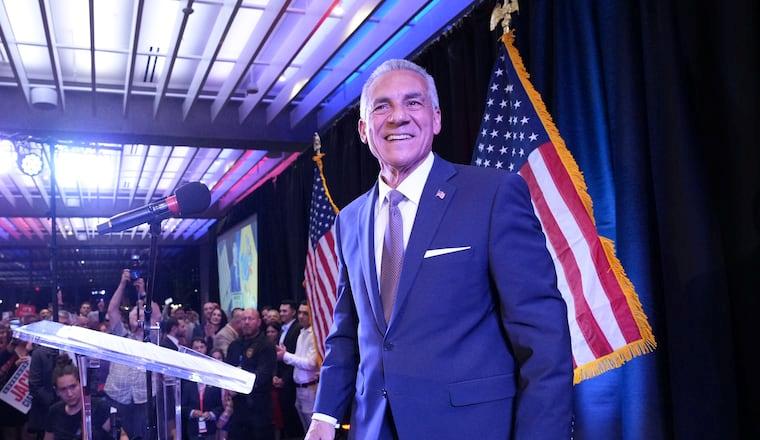 Photo credit: inquirer.com
Photo credit: inquirer.com
Background:
In 2025 Ciattarelli is making his third attempt for Governor of New Jersey. The three-term state legislator ran in 2017 and finished second in the Republican primary to Kim Guadagno, the two-term (2010-2017) Lt. Gov. under Governor Tubba Goo.
In 2021 Ciatterelli came closer than expected to an upset victory after starting 15 to 20 points down in early general election polls. Even polls taken in late October (by Democrat-college groups such as Emerson, Rutgers, Farleigh Dickinson & Monmouth) anticipated incumbent Democrat Phil Murphy being victorious by 6 to 10 points. Only the Trafalgar Group (R) came close to getting it right, predicting a 4-point loss for the challenger; Ciattarelli lost by 84,000 votes (3.2%).
Murphy was first elected in 2017 by vastly outspending Republican nominee Guadagno, as well as by capitalizing on the massive unpopularity of outgoing Republican Governor Chris Christie, to whom Guadagno was constantly linked. That election result maintained New Jersey's habit of alternating parties every 8 years in gubernatorial elections, a pattern which has held since 1993 when ultra-liberal Republican Christine Todd Whitman denied Democrat Jim "Flimflam" Florio a second term by eking out a surprising 1-point victory. Florio later claimed that he was "one of the first victims of modern right-wing talk radio", LOL. Democrats appear likely to break that alternating pattern in 2025.
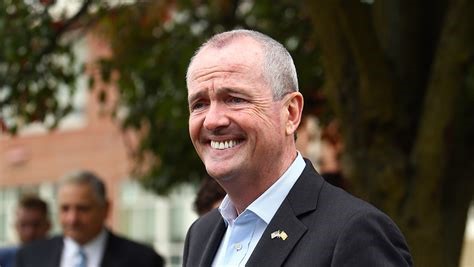 Photo credit: app.com
Photo credit: app.com
The 2021 election was mainly a referendum on Murphy's first term, with Ciatterelli being regarded as sufficiently bland and moderate to avoid alienating potential crossover Democrat voters which any Jersey Republican requires in order to have a chance of winning a statewide election. Murphy is a huge supporter of the illegal importation of new Democrat voters from foreign countries, and he designated New Jersey as a sanctuary state. He also took several steps to hinder the deportation of illegals, such as not permitting law enforcement to ask about immigration status. By 2021 many New Jersey voters had grown weary of the invasion and their disaffection hurt Murphy's re-election chances. Nor were the voters pleased with the numerous tax increases which were passed by the overwhelmingly Democrat NJ legislature.
Unlike 2017, Republicans were able to compete on almost equal financial footing in 2021 in the expensive gubernatorial election. The same applies in 2025, though as we head into the final days of the race the Democrat has substantially more cash on hand, and therefore will likely be more visible in the media than Ciatterelli (nevermind the media bias advantage the Democrat already holds for free).
Ciattarelli won 6 of New Jersey's 12 congressional districts in 2021 -- including the one represented by 2025 Democrat nominee Mikie Sherrill. Sherrill is currently in her fourth term in the House, and is a member in good standing of the far-left wing of her party. She was first elected in the anti-Trump year of 2018 in what at the time was a tossup district (NJ-11) centered on upscale, suburban Morris County.
Until 2018 Morris County had been forever represented in Congress by liberal Republicans such as Rodney Frelinghuysen. Like several other squishy Republicans in the House, the staunchly anti-Trump Frelinghuysen picked 2018 to retire. The 72-year-old, 12-term representative was not comfortable being "forced" to toe the party line and support a president whom he despised. Frelinghuysen abandoned his House seat, hoping (or knowing) that he would be replaced by a Democrat who would help the new Democrat majority thwart Trump's legislative agenda and begin Trump's congressional persecution. Sherrill filled that role nicely.
Morris County seems to have recently begun a journey away from the left and back towards the center, voting for Trump in 2024 after giving Joe Biden a 4.2% victory in 2020. Morris is reliably Republican in other statewide elections too (Murphy lost there twice and it wasn't particularly close), even selecting hapless Curtis Bashaw over Andy Kim in the 2024 Senate race. In 2022 Democrat gerrymanderers added a larger portion of ghetto Essex County to the Eleventh District, taking it from being a complete tossup to favoring Democrats by 5 points. Republicans face an uphill battle to win NJ-11 in 2026 from either Sherrill or whoever her special-election replacement is if Sherrill becomes Governor as expected.
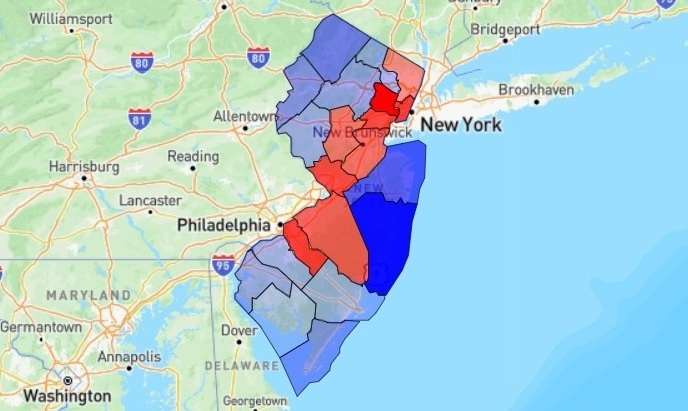 2024 presidential election results in New Jersey
2024 presidential election results in New Jersey
Geography:
We have divided New Jersey into the six geographical regions listed below, shown with the counties which correspond to those regions:
- South Jersey: Atlantic, Burlington, Camden, Cape May, Cumberland, Gloucester, Salem
- Central Jersey: Mercer, Middlesex, Somerset
- West Jersey: Hunterdon, Morris, Sussex, Warren
- Central Coast: Monmouth, Ocean
- Urbanized North: Bergen, Passaic
- Ghetto Jersey: Essex, Hudson, Union
West Jersey and the Central Coast are the most Republican areas of the state; together they normally cast 28-30% of the statewide vote.
Unsurprisingly, Ghetto Jersey is by far the most Democrat area of the state; it delivers about 18% of the statewide vote and gives a tremendous margin to whatever Rat is running. Of the three recent elections (2017 Governor, 2021 Governor, 2024 President) which we will be focusing on for the purpose of establishing trends, Trump did the best of any GOP candidate in this region, but still received only 32% of the vote.
Central Jersey (epitomized by places such as Trenton, New Brunswick and Princeton) is consistent in its anti-Republicanism and provides approximately a 16-point margin for the Democrat while accounting for 16-17% of the statewide vote.
South Jersey is the largest region both in land area and in number of votes. It accounts for about 22% of New Jersey's votes and can be marginal. It was heavily against Ciatarelli in 2017 but he nearly won there in 2021 before the region swung back a few points to the left against Trump in 2024.
The Urbanized North is the most marginal region now and is the one which is moving most noticeably to the right although still slightly favoring the left. It is this area which GOP analysts see as the key if they are to win in New Jersey. Republicans have recently been competitive in the 9th congressional district which lies almost entirely in this region, despite being grossly outspent and despite a Democrat gerrymander which deliberately omits the better parts of Passaic County. Ciattarelli improved here by 12 points (net) between 2017 and 2021 and Donald Trump nearly won this region, losing by only 1.5% in 2024.
The next table shows the margin of victory (or defeat, if the number is negative) by region for the GOP candidate in these three elections:
Finally, the number of votes cast by region, along with the region's percentage of the statewide vote:
One of the keys to the near-upset in the 2021 gubernatorial election was the fact that many ghetto voters (Democrats, obviously) chose to sit that one out rather than vote for Murphy. The share of the statewide vote from Essex, Hudson and Union counties dropped nearly 2 percent. Those voters were re-energized in 2024 to vote against Trump and the statewide vote share from the 3 ghetto counties rebounded to where it had been in 2017.
Anti-Murphy apathy will not be on the ballot in a couple of weeks, but anti-Trump motivation will be -- here and everywhere else where an election is taking place (at least in "blue" areas). As was the case in the disastrous election years of 2017-18, Trump is always "on the ballot" as far as the left is concerned. Turnout in these off-year races isn't quite as meager as it is for little-publicized special elections which often take place at odd times (i.e. not November), but turnout still does not approach presidential-year levels. That means motivation, organization and money are the key factors to generating turnout; Democrats are normally substantially ahead in all 3 of those factors, and it shows.
Voter Registration:
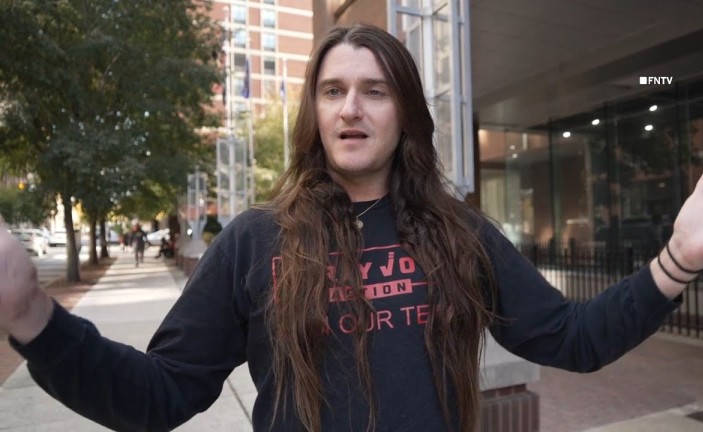 Photo credit: redlineheadlines.com
Photo credit: redlineheadlines.com
Scott Presler and his organization have worked diligently over the past couple of years to increase Republican voter registration counts in certain states. Presler focused on Pennsylvania during 2024 and has been given inordinate credit for the GOP victories which occurred there -- Trump's win along with that of Senator Dave McCormick, and the important pickup of two House seats (CD-7 and CD-8) in Eastern PA.
While it is true that the Democrat registration advantage in PA was reduced to 3.1% from 5.6% during 2024 (a net GOP gain of 165,000 registrations in 12 months), the trend in PA has been significantly in the R direction for over 15 years now. Between November of 2008 and November of 2023 the GOP added 210,616 voters in the Keystone State while Democrats diminished by 579,285, a net change of 789,901 in the positive direction for Republicans.
Pennsylvania has apparently "cleaned up" its voter rolls in 2025, with both parties seeing a reduction in registrations:
2024:
- 3,710,290 R (40.5%)
- 3,991,381 D (43.6%)
- 1,460,307 I (15.9%)
2025:
- 3,642,630 R (40.9%)
- 3,811,262 D (42.8%)
- 1,448,470 I (16.3%)
The last time Republicans achieved a 40.9% or greater share of voter registrations in a November election in PA was 2003.
This November, Pennsylvania voters will have the chance to oust 3 Democrat members of the state Supreme Court. Those members, along with their liberal colleagues, are responsible for the hyper-partisan gerrymander which has affected not only congressional districts in Pennsylvania but state legislative districts as well. These gerrymanders cost Republicans 4 U.S. House seats (and almost 2 others) from 2019-2024 and cost 12 state House seats -- exactly enough to give Democrats control. Republicans have a chance to eliminate some of the justices who caused those events to happen, and perhaps gain a majority on the PA Supreme Court in the process.
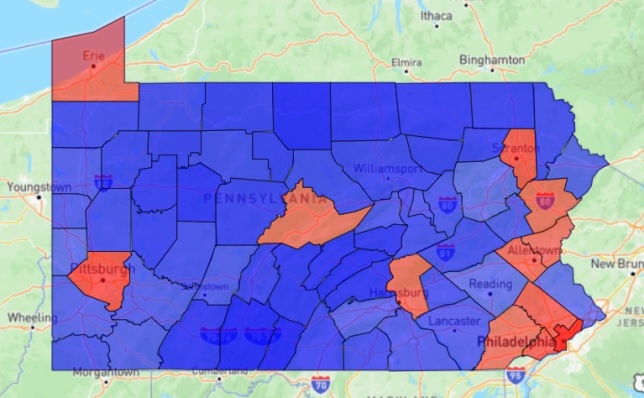 2024 PA voter registration, by county
2024 PA voter registration, by county
After 2024, Presler and his vote registrars moved east to New Jersey in an attempt to turn that state "red". As in PA, trends in New Jersey were already favoring Republicans, although these trends have not manifested themselves in any victories. Trump's loss by 5.9% here in 2024 was actually the best showing for a Republican candidate since George Bush lost by only 2.4% in the 3-way election of 1992. Prior to 1992, the GOP won 6 presidential elections in a row in New Jersey before the state's demographics began to head rapidly south.
Recent results have been no better down the ballot, with Chris Christie the only Republican to win statewide since Christie Whitman in 1997; the GOP has not elected a U.S. senator from the Garden State since ultra-liberal Clifford Case in 1972, and the U.S. House districts have been gerrymandered to an amount which limits Republicans to just 3 districts out of 12 (and at least one of those GOP districts, CD-7, is very marginal). Those factors notwithstanding, Trump did a little better statewide than expected in 2024, Jack Ciattarelli almost pulled off a major upset in the most recent gubernatorial election, and there appears to be reason for some optimism on the Republican side going forward.
The trend is also apparent in the New Jersey voter registration figures, to a minor degree.
November 2023:
- R: 1,541,158 (23.7%)
- D: 2,504,294 (38.6%)
November 2024:
- R: 1,628,633 (24.2%)
- D: 2,534,932 (37.7%)
October 2025:
- R: 1,670,297 (25.3%)
- D: 2,525,346 (38.2%)
It is worth noting that a sizable number of New Jersey voters are neither Republicans nor Democrats. If the polls are correct, independents are favoring the Democrat by a substantial amount in the 2025 gubernatorial race.
Going back to 2008, Republicans have added 614,894 voters in New Jersey and Democrats have added 742,790. However the recent data is more affirmative with the GOP registering large gains during 2024 and then almost as many again in 2025. Democrat registration has been stagnant during the past two years. Will the "Presler bump" in 2025 be enough to put Ciattarelli over the top on November 4? Current polling suggests it will not. He may be fortunate to lose by only as much as he did in 2021.
Conclusion:
It is being reported, even by far-left sources, that all is not well in Camp Sherrill despite her clear lead in nearly every poll. There has also been fear that black voters and other minorities will turn out at less than their usual rate, as occurred in 2021 (spoiler alert: that isn't going to happen again in 2025). The Naval Academy cheating scandal in which both Sherrill and her husband are allegedly involved isn't resonating at all with voters and (shockingly!) isn't being covered in the so-called mainstream media.
Even lefties concede that Sherrill does not generate much enthusiasm, but the fact that New Jersey has nearly 1 million more Democrats than Republicans makes "enthusiasm" a rather moot point in the face of that landslide registration advantage. Furthermore, while comparatively few Democrat and independent voters may be excited about voting for Mikie Sherrill, they are probably quite motivated to vote against Donald Trump clone Jack Ciattarelli. Of course Ciattarelli is no such thing, but hatred is a powerful motivator for Democrats and no facts are going to be allowed to impede that hatred.
Final prediction: Sherrill prevails by 2 to 4 points, with a decent potential for an even greater margin (say, 4-6 points). We'd positively adore being wrong about this outcome, but even if she only wins by 1 then we're still not quite wrong enough.
Virginia:
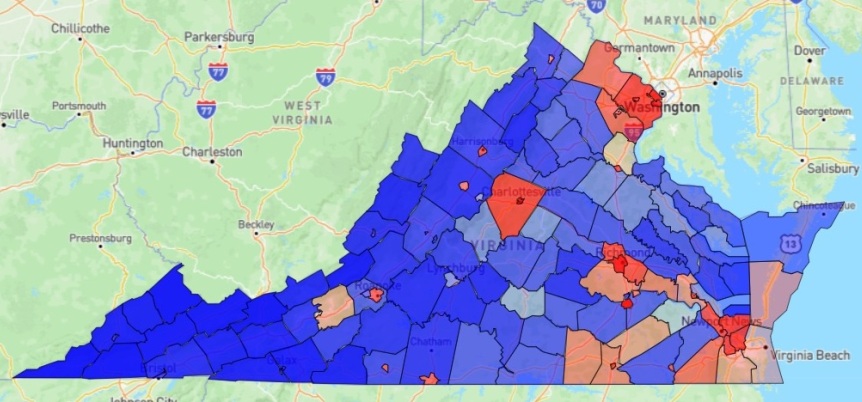 2024 presidential election result in Virginia
2024 presidential election result in Virginia
Background:
Although Trump lost the Commonwealth of Virginia in 2024, his margin of defeat (5.7%) was a distinct improvement over 2020 when he lost by over 10 percent; the 2024 outcome was in line with other recent presidential elections in Virginia. There was false optimism in the 2024 U.S. Senate race, where many wishful thinkers believed that Hung Cao would defy the polls and score a major upset over incumbent radical leftist Timmy Kaine, or at least make it a close call. Cao did neither of those things, losing by 9 points which was just a slight tick better than the polls predicted.
Trump's sizable step in the right direction, along with the surprise victory by Republican Glenn Youngkin for Governor in 2021, helps to create the illusion that Virginia is a "purple" state where Republicans have almost as good a chance at winning as Democrats do. In reality, Virginia is slipping behind the rest of the country and becoming "bluer" by the day. Relative to the nationwide percentage of the Republican presidential vote, Trump's 4-point underachievement in VA in 2024 was the worst showing here for a GOP candidate since the 1940's when Virginia was solidly Democrat across the entire ticket. Although Virginia does not register voters by party, recent estimates of party affiliation indicate that Democrats have nearly a 2:1 advantage over Republicans. That's not very purple-ish.
Speaking of Governor Youngkin, his win in 2021 was primarily the result of the stars and planets aligning in his favor, and it is now abundantly clear that Youngkin's electoral success (and that of his party, which gained 7 seats and took control of the state House that year) was a temporary phenomenon.
Youngkin benefited from several factors, which have some parallel to Donald Trump's surprise victory in 2016, and those factors may have also helped Republicans in races down the ballot in Virginia in 2021:
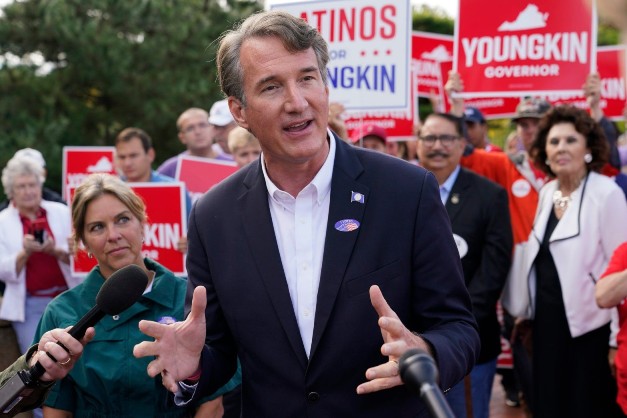 Photo credit: washingtonmonthly.com
Photo credit: washingtonmonthly.com
- Youngkin, like Trump in '16, was a political outsider and not a career politician, and both were fortunate to be able to run against the single most repugnant and unlikeable Democrat available at the time (Terry McAuliffe, Hillary Clinton). Former Governor and Clinton crony McAuliffe was a godsend for Youngkin. McAuliffe's abrasive personality and his far-left political positions proved to be quite helpful to the moderate Republican candidate. Furthermore, the Republican was able to compete financially against the Democrat's massive fundraising advantages by contributing significantly to his own campaign. Youngkin distanced himself from Trump (while McAuliffe was not able to distance himself from Joe Biden) enough to keep moderate and independent voters from bolting to the left.
The 2021 Republican nominee was aided in great measure by voter revulsion against local school boards (notably in Loudoun County) which were defying parents -- and common sense -- by welcoming the presence of boys in girls' bathrooms and by continually "overstepping parental rights during the pandemic". When a male student raped a female student in a Loudoun County school bathroom in 2021, the incident and the school's mishandling of it rightfully became a national scandal -- at least in the "right wing" media. The liberal media downplayed and/or ignored the story after an initial cursory report, with a majority of voters in upscale, liberal Loudoun County probably being totally unaware of what had occurred right in their own backyard. But many good voters in the rest of the state were aware of this atrocity, and their logical reaction to it helped Youngkin considerably.
- Virginia is not exactly known for the cleanliness of its elections in recent years, but Youngkin was perhaps not taken as seriously by Democrats as he should have been even though he was close or even slightly led McAuliffe in polls which were taken in the closing weeks of the race. Trump also was not given a serious chance to win in 2016, and liberal pollsters right up to election day helped the Democrats maintain their (false) overconfidence; Democrats and Deep Staters of both parties did prepare for the eventuality of Trump's election by fabricating the "Steele Dossier" and all the phony "Russia, Russia, Russia" crap to attempt to hamstring him after the fact, but they apparently didn't put as much -- let's call it "extra effort" -- as usual into achieving their desired electoral outcome in the first place.
Underestimating the amount of voter support which both Trump and Youngkin actually had, the Democrats apparently did not feel the need to ensure victories by their usual methods (cough, cough). Trump was able to achieve narrow victories in critical states such as Pennsylvania (by 0.7%), Michigan (0.2%), Wisconsin (0.7%) and Florida (1.2%) and thus win the electoral vote despite losing the popular vote by 2.1%. Youngkin improved his party's showing from 2017 in several areas of the state, winning major portions of the Tidewater and Greater Richmond areas, and vastly reducing the deficit in NOVA -- even in Loudoun County, but still lost by 11 points there.
In the aftermath of that glorious 2021 outcome it was reported that one of the main reasons for it was the "Virginia Project", a Republican effort to increase election integrity (something Democrats always oppose) by, for one thing, recruiting poll watchers for as many precincts as possible. With 36% of the votes in the 2021 Virginia gubernatorial election being cast early or absentee, the impact of GOP poll watchers was somewhat muted unless they were present when the envelopes were being opened and the ballots counted; their presence on election day was still helpful, though.
With it seeming to work so well in Virginia that year, the Virginia Project (we were told) would serve as a model for helping ensure the honesty of future elections, and would be expanded to states beyond Virginia. Looking at many important outcomes from 2022 onward, the proponents of the Virginia Project either never implemented their model or it didn't function as well as expected. In any event, there's much more to the concept of election integrity than poll watchers can accomplish.
- Even with all of those advantages, both Trump and Youngkin won rather unconvincingly. The mistakes which national Democrats made in 2016 at the presidential level were "rectified" in 2020; the mistakes which Virginia Democrats made in 2021 began to be rectified almost immediately: the 7-seat gain which gave Republicans the Virginia state House starting in 2022 was partially offset in November of 2023 when Democrats added 3 seats and seized control of the House, 51-49; they have held the state Senate throughout Youngkin's term, by a 21-19 margin.
The candidates:
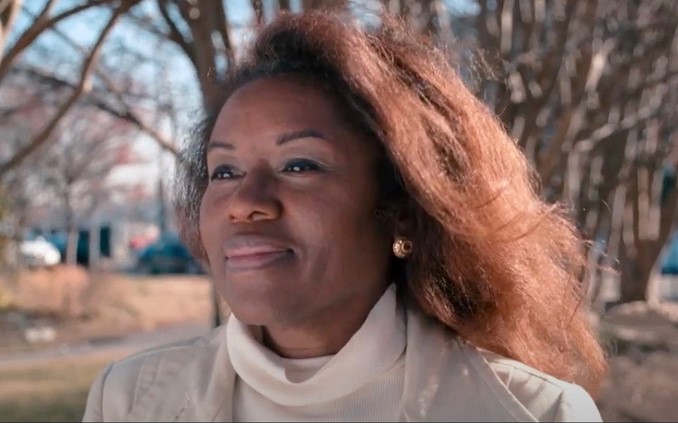 Photo credit: lifenews.com
Photo credit: lifenews.com
GOP nominee Winsome Earle-Sears is an immigrant from Jamaica who arrived in the U.S. at the age of 6. She served in the United States Marine Corps for 4 years in the 1980's and became an American citizen during that time. Her political career commenced in the early 2000's when she won a race for the state House, upsetting a black Democrat who had been in office for two decades. She was the first Republican to win a state House seat in a majority-black district in Virginia since 1865. She later became the state's first female Lieutenant Governor (elected in 2021) and is the first black female to be elected to any statewide office in Virginia.
Although Sears endorsed Donald Trump in 2020 and served as the chairman of a PAC called "Black Americans to Re-elect the President", she broke with Trump in 2022 because she believed that the candidates Trump had endorsed that year were too conservative and therefore unelectable (in fact they weren't elected, but Sears was wrong about the reason for their defeats). At that time Sears declared she would not support Donald Trump's election bid if he were to run in 2024.
Probably for this reason (yeah, "probably"), Trump for a long time refused to support Sears for Governor in 2025, though he belatedly came through with an endorsement earlier this week. That endorsement, however, seemed to focus more on Spanberger being a "disaster" for Virginia than it did on Sears being Trump's choice for the job.
Sears also has the endorsements of Governor Youngkin, state Attorney General Jason Miyares, the entire Virginia Republican congressional delegation, and some congressmen from other states. Sears is pro-life, supports "common sense" tax cuts and government spending cuts, and opposes Democrats' radical pro-crime policies such as "catch and release" and sanctuary cities. She opposes incompetent (but powerfully unionized) teachers and favors school choice and parents' rights. Sears also strongly supports Virginia's "right-to-work" law. These positions stand in stark contrast to that of her allegedly "moderate" Democrat opponent, Abigail Spanberger.
 Photo credit: twitchy.com
Photo credit: twitchy.com
Spanberger, a native of New Jersey, went from being a substitute schoolteacher and a postal inspector to (as of 2006) being a spy for the Central Intelligence Agency; a rather interesting career change, to say the least. When she first entered politics, Spanberger's CIA resume was sanitized so that it could be declassified and, according to ABC News, the former spook stuck "to carefully scripted lines, approved by the agency, when talking about her work" on the campaign trail.
In 2018 CIAbby was recruited to run against Republican incumbent Dave Brat for a seat in Congress. Brat had irritated many GOP bigwigs by daring to oppose -- and defeat -- golden boy Eric Cantor, a squish who was a member of the GOP leadership (House Majority Leader) when he was shocked by Brat in the 2014 primary. We wrote at length about Brat's situation here, and his parallels to ex-congressman Bob Good. Good, a very solid conservative like Brat, fell out of favor with his party's leadership in 2024, and irritated the biggest bigwig of them all (Donald Trump). Good was defeated in the 2024 primary.
VA-7, the formerly Republican-oriented district in which Brat toppled Cantor and then 4 years later was defeated by Spanberger, was altered to give Democrats a much greater chance of success after 2014. Brat survived in 2016 because the Democrats pretty much gave him a free pass, but in 2018 Spanberger was able to raise and spend over $7 million dollars to purchase that House seat. That was more than double the amount which Brat could raise (or obtain from his indifferent party leadership). The surplus millions which Deep State Abby was able to throw around proved to be critical as she eked out a 1.9% win in the recently-gerrymandered district; her margin of victory came almost exclusively from the new Democrat areas in the Richmond suburbs which were added after 2014.
Democrats spent lavishly while procuring numerous House seats in 2018 and, coincidentally, another new Democrat who was the recipient of an astronomical "investment" that year was New Jersey's Mikie Sherrill who is now her party's gubernatorial nominee in that state.
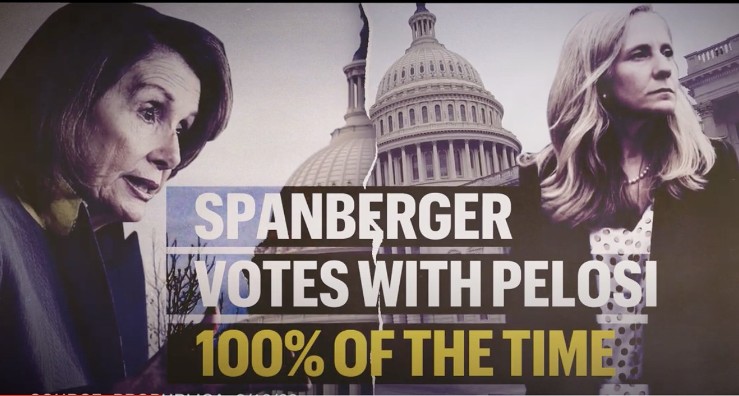 Photo credit: NRCC
Photo credit: NRCC
Republicans picked up 13 House seats in 2020 but Spanberger's wasn't one of them although a serious effort was made. Her district, which had been rated as R+10 prior to the 2016 Democrat gerrymander, was still slightly "red" and Republicans had it high on their list of potential pickups. Spanberger, then as now, occasionally talks like a moderate and did cast a highly publicized (and highly choreographed) vote against Nancy Pelosi for Speaker in January, 2019. Spanberger then spent the remainder of her first term in Congress establishing her liberal bona fides, but was able to conceal that fact from the voters as she reverted back to her faux-moderate persona.
Nick Freitas, a solid conservative, defeated squishy John McGuire (now a congressman from Virginia's Fifth District) in a contentious Republican party primary convention in July of 2020, and won the right to oppose Spanberger in November. As in 2018, the Republican carried all areas of the district aside from the deteriorating Richmond suburbs, but that was not sufficient to prevail district-wide. Or was it?
On the afternoon of the Wednesday following the 2020 election, Freitas had a lead of a little more than 1,300 votes over Spanberger. Then came the discovery of a "flash drive" in Henrico County by the husband of a Democrat operative, and that flash drive miraculously contained over 14,000 as yet uncounted votes in the 7th District. Just as miraculously, Spanberger happened to receive a tremendous percentage (64%) of those flash votes. The Democrats later found even more votes for CIAbby, making sure that her final margin was outside the range which would require an automatic recount. In 2022, Spanberger spent over $9 million dollars to successfully retain the 7th District seat; redistricting by that time had moved the district even further left in order to help ensure her another term. Spanberger did not seek re-election in 2024 in order to focus on her gubernatorial run.
Geography:
As we did with New Jersey, we have split Virginia into 6 regions:
- Rural Chesapeake Bay area
- Greater Richmond
- Hampton Roads
- Northern Virginia
- Piedmont / Southside
- Shenandoah Valley / Southwest Virginia
Taking some of these regions together, Virginia can be divided into three pieces of approximately equal electoral weight. Two of the three nearly always favor Democrats.
NOVA is of course the most Democrat-infested area, teeming with people whose livelihoods depend on the federal government taxpayer. If it were a congressional district it would be rated approximately D+17 based on recent results. It is also the most populous region, casting just under one-third of the state's votes in most elections. The large number of votes which must be counted here undoubtedly explains why NOVA is typically the last area of Virginia to report on election night, wink wink.
The portion of the state which is included in the Piedmont / Southside / Shenandoah / SW Virginia regions accounts for just under 30% of the statewide vote and gives Republicans their biggest margins of any region. The statistically insignificant (barely 2% of the vote), lightly populated Chesapeake Bay counties also support Republicans lately, by almost exactly the same percentages as obtained in the Piedmont / Southside areas.
The Greater Richmond and Hampton Roads regions together outnumber NOVA in total voters, though not by a lot. They solidly favor Democrats in most races, and if a Republican is going to win a statewide election he needs to come close to getting 50% here. Youngkin did that in 2021 (he received about 48%) but Ed Gillespie didn't in 2017 nor did Donald Trump or Hung Cao in 2024. The latter 3 GOP candidates mustered only about 42% or 43% there; Youngkin won statewide, the others did not.
Conclusion:
Unlike in North Carolina in 2024, where the unpopularity of one GOP candidate (Mark Robinson) dragged down the entire statewide Republican ticket although some Republicans won anyway, the presence of violent, feral racist Jay Jones as Democrat nominee for Attorney General has had no impact on other Virginia Democrats in 2025; in fact, Jones still retains about a 50-50 chance of winning himself according to left-wing pollsters. So any Jones Effect on the gubernatorial race which would assist Sears can likely be discounted as non-existent.
As of October 15, campaign finance reports showed that CIAbby had raked in $53.8 million and disbursed $48.4 million. The Sears campaign lags far behind, running on about half of what the Democrat has done in both of those categories. There is also a wide disparity between the two candidates in terms of remaining cash-on-hand, with about a 3:1 advantage to Spanberger as we head into the final days of the campaign.
The Lieutenant Governor race and the one for Attorney General will end up closer than the Sears-Spanberger duel, but Republicans are likely to lose at least one of those two downballot tilts, and quite possibly both. There is some chance that they could win both (while still losing for Governor), but that is less likely barring a significant change in fortunes between now and November 4.
The Virginia state Senate has been in Rat hands since they picked up the two seats they needed in 2019. It's been status quo since then, with the Republicans needing one seat to forge a tie and two to take control. With the L.G. probably going Democrat in 2025, one seat isn't going to be enough. The state Senate map for this decade has been gerrymandered to favor Democrats, and under those conditions the GOP is doing well to merely be down 21-19. A similarly gerrymandered state House map also strongly favors Democrats; again, the GOP has done well to even keep it close. The forecast for this November is not sunny for Virginia Republicans at the state legislative level, and they are going to need to overachieve a little more if there is any hope of thwarting the agenda of "Governor Spanberger". Ugh.
Tags:
2025
Governor
New Jersey
Virginia
|
|
7/2/2025:
Today's Breakfast Specials: Fried Bacon, Toasted Tillis
[RightDataUSA]
|
Over the past few days, two moderate Republicans have announced that they will not be seeking re-election in 2026: Rep. Don Bacon of Nebraska and Senator Thom Tillis of North Carolina. Both of these anti-conservative politicos have taken great pride in being a thorn in the side of the majority of their party, and they bask in the positive media attention they get when they oppose President Trump.
Trump normally saves his greatest degree of vengeance for those who oppose him from the right (such as ex-Rep. Bob Good or current Rep. Thomas Massie) while going easier on Republicans who come at him from the other direction (such as Impeachment RINO Dan Newhouse of Washington), and he nearly always endorses squishy moderate incumbents over conservative challengers even in the safest of Republican districts. However, Trump recently declared War on Tillis and, probably as a result of that, Tillis has decided to scram. Trump's reaction notwithstanding, Tillis did not become a darling of the left only recently; he had already sealed his probable re-election fate months earlier.
Fried Bacon:
 Photo credit: AP Photo/J. Scott Applewhite
Photo credit: AP Photo/J. Scott Applewhite
Although he did not make the official announcement until June 30, there had already been chatter that Bacon was through after this term. He was first elected alongside future nemesis Donald Trump in 2016, defeating erratic Democrat incumbent Brad Ashford by 1.2%. Ashford started out as a Democrat, switched to Republican, then became an Independent, then back to Democrat again. He used his scattershot background to provide cover for his natural liberalism; although Ashford campaigned as a moderate he nearly always voted as a liberal during his lone term in Congress.
Bacon survived the anti-Trump liberal landslide of 2018 because the so-called moderate Ashford was edged out by far-leftist Kara Eastman in the Democrat primary that year; Ashford would have likely won the general election rematch, but Bacon lucked out by having a more "progressive" opponent who repelled enough moderate voters to seal her defeat.
Bacon was truly a moderate during his first term and part of his second one (2017-2019) but he began to panic and/or seek liberal media approval for his "maverick" status during the COVID year, and his voting record jumped noticeably to the left. His record has stayed that way ever since. It could be successfully argued that, as bad as Bacon is, he remained a good fit for his ever-deteriorating district (NE-2) which is based in and around the city of Omaha. Bacon won 5 times without ever getting even 52% of the vote in this highly marginal district, which is impressive in its own way.
Bacon's greatest achievement was his most recent victory in 2024. It's rare that a long-term House incumbent suddenly becomes an underdog absent some scandal or adverse redistricting (neither of which applied to Bacon in 2024), but liberal Democrat Tony Vargas was leading in every poll taken from mid-August on and nearly every prognosticator -- including us -- expected Bacon to lose; he won by 1.8% in one of the most surprising outcomes on election night.
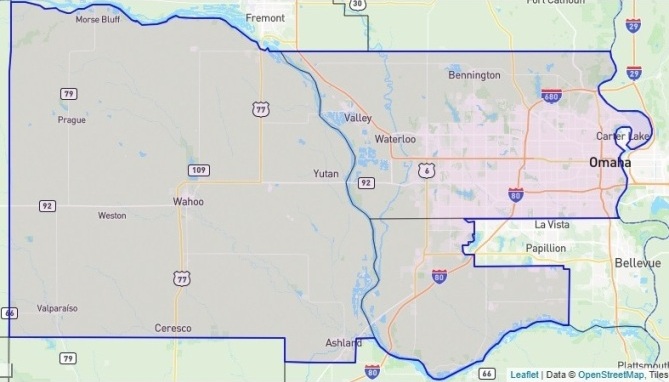 Nebraska congressional district 2
Nebraska congressional district 2
Nebraska's Second Congressional District contains all of Omaha, and the city comprises 75% of the district. It is the other 25% which (so far) has kept this a Republican seat in the House. By 2024, the White percentage of the district was down to approximately 65% (it had been 80% as of the early 2000s) while the Hispanic percentage continues to rapidly increase. This district -- which awards its own Electoral Vote in presidential elections -- not only has rejected Trump twice in a row now, it also voted heavily against incumbent Republican Senator Deb Fischer in 2024, preferring "independent" Dan Osborn by a whopping 12 points. NE-2 did vote Republican for Governor in 2022 and for the other Senate seat (Ricketts) in 2024, however it was by the narrowest of margins. Led by Omaha, the district is obviously trending leftward and is now rated as D+2. Even as recently as 2020 it was rated as leaning to the right by a miniscule amount, but those days are gone.
John Gizzi -- who at one time was a respected political analyst for the conservative publication Human Events but now in his dotage regularly reveals himself to be a member in good standing of the GOP establishment -- crafted an article for Newsmax on June 26 which correctly anticipated Bacon's departure. That article contains a couple of errors however, one of which is a hilarious whopper but quite appropriate for an establishment RINO to make.
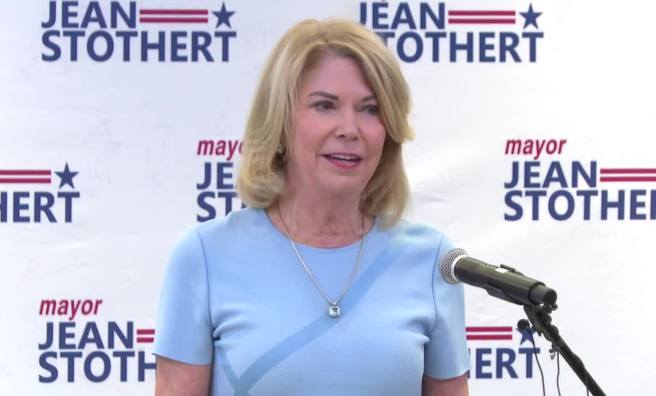 Photo credit: 3newsnow.com
Photo credit: 3newsnow.com
Minor error #1: former Omaha Mayor and nominal Republican Jean Stothert (elected in 2013, 2017 and 2021) is not a transvestite and therefore is not a "he" as a quote from the article states; a minor error but one which reveals a certain amount of cluelessness on the part of the quoter, who was a former chairman of the Nebraska Republican party. That guy did get one thing right -- Stothert is surely no conservative. Stothert had her easiest election in 2021 when three liberal Democrats split the primary vote and could not reunite in time for the general election one month later. Stothert lost in May of 2025 by almost 13 points to a liberal black Democrat, conclusive evidence of how the city of Omaha has finally completed its journey to the dark side. Even granting that Stothert's general election campaign in 2025 was sabotaged by Republican primary loser Mike McDonnell (who spitefully endorsed the Democrat), it seems that even moderate Republicans no longer need apply for electoral employment within the city limits.
The mayor of Omaha is technically a non-partisan position (like the state legislature) but the parties of the candidates and officeholders are rarely a secret.
Major error #2: Gizzi's own blunder in the article is a real howler: claiming that Brett Lindstrom, the presumptive GOP nominee for the open NE-2 seat in 2026, is "considered a strong conservative". In reality, Lindstrom is just so much leftover Bacon. He can usually be found on the left flank of the Republican party in Nebraska and at one time was the most liberal Republican in the Nebraska state legislature. During his time in Lincoln, Lindstrom's conservative ratings from CPAC were:
2015: 64%
2016: 54%
2017: 75%
2018: 73%
Having moved to the right while running for re-election for the first time in 2018, Lindstrom was safely returned to office for a second term -- and safely returned to being the liberal which he really always was. When he decided that he wanted to be Governor and would therefore have to appeal to conservative voters statewide by moving rightward (if he could win the primary while running to the left) -- a neat trick, but a common one for liberal Republicans -- Lindstrom began moderating his voting record in 2020.
2019: 52%
2020: 63%
2021: 64%
2022: 80%
In 2022 Lindstrom was absent (or failed to take a position) for nearly half of all key votes including one on abolishing the state income tax and another vote on preventing election fraud.
In 2022 Lindstrom finished third in the GOP primary for Governor. Moderate Jim Pillen won that primary (and then the general election, easily) and conservative Charles Herbster finished second after leading in the polls; he was slimed with some Clintonian-type accusations of sexual indiscretions. Herbster was endorsed by Donald Trump and others on the right; Pillen had all the moderates in his corner; Lindstrom was supported by some ex-Republicans who became Democrats, and he was endorsed by moderate-liberal Omaha Mayor Jean Stothert.
Even a squish like Pete Ricketts (a Pillen supporter) considers Lindstrom to be too liberal. Here is a quote from Ricketts which appeared during the '22 gubernatorial campaign: "Brett Lindstrom raised the gas tax 23%, opposed voter ID, gave taxpayer benefits to illegal immigrants, repealed the death penalty, and even tried to gut the Property Tax Credit Relief Fund. It's no wonder Democrats are supporting Lindstrom -- his liberal record speaks for itself."
And this guy is the best we can do while trying to hold the NE-2 House seat? Sadly, that may be the case.
Toasted Tillis:
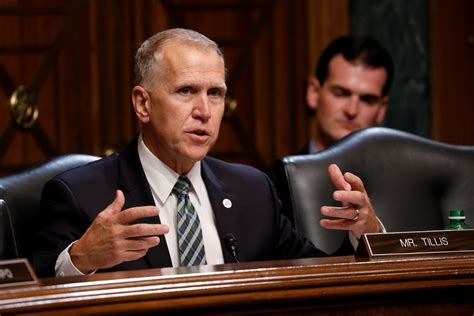 Photo credit: Washington Post
Photo credit: Washington Post
Business executive Thom Tillis was elected to the North Carolina state House in 2006 after one term as a city commissioner. Tillis compiled a conservative voting record (but was a more bipartisan type aside from some of his positions on key votes) during his 4 terms, and was Speaker of the NC House from 2011 through the end of his tenure there. True conservatives very rarely ascend to the position of Speaker even in the most conservative of states, and North Carolina isn't one of those anyway.
Liberal Democrat Kay Hagan, defeater of Elizabeth Dole and a rubber stamp for the Obama agenda in the Senate, was up for her first re-election bid in 2014. Polls showed her as being increasingly vulnerable heading into that election year, and numerous Republicans were considering opposing Hagan. Tillis jumped into the GOP primary as the favorite and received endorsements from high-profile squishes like Mitt Romney and Jeb Bush. Tillis' major opponent for the nomination was conservative "activist" and physician Greg Brannon. But Brannon was not a serious threat, never led in any poll against Tillis, and finished second in the primary, with 27.1% to 45.7% for Tillis.
For the general election, Democrats flooded the state with oodles of money on behalf of their doomed candidate and additionally invested $36 million in "independent" expenditures against Tillis. Despite the massive disparity in funding in favor of the Democrat (an extremely common occurrence in Senate elections in recent years), Tillis eked out a 1.5% upset victory over Hagan.
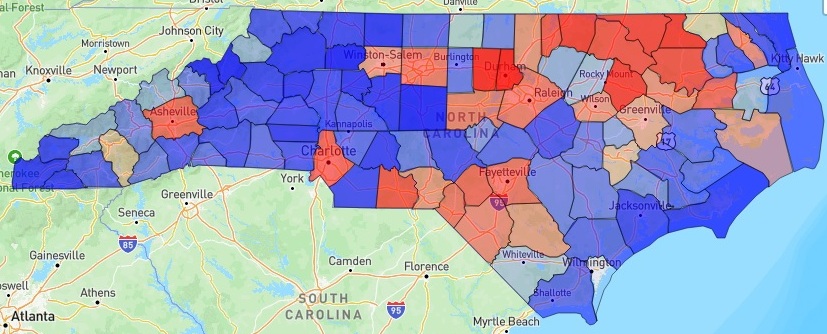 North Carolina Senate election results, 2014
North Carolina Senate election results, 2014
Tillis carefully walked a line down the middle of the road during his first two Senate years (2015-2016) which corresponded with the final two years of the Obama administration. Desperately seeking to project an image of moderation in his sharply divided state, Tillis supported Obama somewhat more often than he opposed the president on Senate votes. Tillis was a staunch (though not entirely reliable) supporter of Donald Trump during Trump's first term in office.
In 2020 Tillis faced another big spender, Democrat Cal Cunningham. Cunningham, a former U.S. Army lawyer, tried to portray himself as a sensible, patriotic moderate who was not on board with fashionable radical leftist causes like "Black Lives Matter" and "Defund the Police". As in 2014, Tillis -- though now having the advantage of incumbency -- trailed throughout the COVID summer and into the fall. Even the final polls predicted a 2-4 point win for Cunningham. A month before the election, the married Democrat patriot was found to have engaged in "sexting" with a woman not his wife. These revelations were typically downplayed by the media and Cunningham suffered no damage in the polls. But just like in 2014, Tillis pulled off the upset and prevailed by a small margin in November.
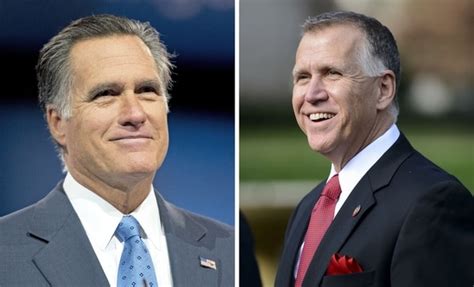 Romney and Tillis: Birds of a Feather
Romney and Tillis: Birds of a Feather
Photo credit: newsmax.com
With Trump safely out of the picture now, Tillis emerged as even more moderate (actually, liberal) than he had been in the past; his support for the Biden administration's policies and his opposition to conservative principles were both running in the 40% range from 2021-2024; that's Mitt Romney territory, though not quite as reprehensible as Susan Collins or Lisa Murkowski.
Trump's return to the White House has caused Tillis to largely abandon whatever was left of his principles. All politicians (not just Donald Trump) have massive egos, and few of them have larger egos than the "Elite 100" who occupy the United States Senate. Tillis, among some others, objects to the pressure to blindly obey the president's every wish regarding legislation. Occasionally in 2025 this is a good instinct for a Republican, but most of the time it is not. Tillis began the second Trump administration by railing (and voting) against worthy presidential nominees like Pete Hegseth for Secretary of Defense and Ed Martin for U.S. Attorney for the District of Columbia. Tillis singlehandedly derailed the Martin nomination and his ex-sister-in-law was the driving force behind the smear campaign against Hegseth. So Tillis wasn't just voting the wrong way -- he was doing much more damage than that, whether directly or indirectly.
Those actions, along with his other recent anti-conservative tendencies, made Tillis' 2026 re-election prospects quite dubious. The last straw was his vote against the "Big Supposedly-Beautiful Bill", which triggered Trump's wrath. Tillis The Moderate would be highly vulnerable in the Republican primary while remaining an underdog in the general, still reviled by North Carolina Democrats no matter how much of a centrist he thinks he is now.
NC Senate outlook for 2026:
So-called experts have designated the 2026 Senate election in North Carolina as a tossup, but anyone with multiple functioning brain cells would forecast exactly the same thing. No expertise is necessary to see that we are likely heading for another super-close statewide election in a state which specializes in such results. Hopium addicts on the right insist that North Carolina is a solid "red" state, but it is nothing of the sort even though it has voted Republican for president 11 of the last 12 times.
The last 5 presidential elections in North Carolina have been decided by an average of just 2.1%. The margin of victory in recent elections for Governor or Senator averages somewhere in the 5-6 point range. The outcomes of statewide row-office elections are even closer, with only two opposed candidates getting even 55% of the vote (and then just barely) in the past 13 years, covering a total of 35 elections.
The 2026 Senate race was a tossup from the beginning, whether Tillis ran or not.
The top Democrat contender is obviously former Governor Roy Cooper, who should be announcing his entry into the race any minute now. Cooper's average percentage in his two elections for Governor was barely 50%, yet he comes in as the favorite to be the next Senator from North Carolina. His token opposition in the Democrat primary would be one-term former congressman Wiley Nickel, a liberal carpetbagger who spent his life in California and Washington DC before migrating to North Carolina a few years ago. He won a close House race in 2022, but when the Democrat gerrymander of North Carolina's district lines was rightfully invalidated by the state Supreme Court, Nickel found himself in a no-win situation and failed to seek re-election in 2024.
 Photo credit: Carolina Journal
Photo credit: Carolina Journal
The Republican side is wide open. Lara Trump, chairman of the Republican National Committee for a little over 10 months in 2024-25 (and the daughter-in-law of President Trump) is the heavy favorite for the GOP nomination if she chooses to seek it. A native of the Tarheel State, Trump will still face allegations of carpetbaggery because she has spent much of her adult life elsewhere.
A hypothetical matchup between Trump and Cooper shows -- guess what? -- a close race! Lara Trump will face unprecedented amounts of hatred in 2026 if she is on the ballot, but Roy Cooper is far from unanimously popular despite a media-burnished image as an alleged moderate. Cooper would probably win against any Republican, but November, 2026 is an eternity away and gleeful Democrat prognosticators may find 17 months from now that their crystal balls weren't so accurate.
Other potential Republican Senate candidates include a large number of opportunistic congressmen, several of whom are still in their first term:
- Pat Harrigan, newly elected in the 10th district (mostly suburban areas like Mooresville, but also part of urban Winston-Salem) and one of the best of the non-Trump alternatives. Harrigan is a young military veteran, a Green Beret who served in Afghanistan and a solid conservative so far in Congress. Harrigan has declared that he will not run for the Senate if Trump does, so as not to split the right-wing vote.
- Tim Moore, newly elected in the 14th district (Gastonia, Shelby, Charlotte suburbs). He is a lawyer and career politician with a resume much like that of Thom Tillis (uh oh). Moore spent 22 years in the N.C. state House before moving up to D.C. He was the Speaker of the House for 10 years but is still thought to be somewhat conservative.
- Greg Murphy, currently in his fourth term in the House after winning a 2019 special election to replace the late Walter Jones in the 3rd district. Murphy has been re-elected easily three times and has compiled a record which began as fairly conservative but has moved a bit to the left since his initial term.
- Addison McDowell, another very young (31 years old) freshman House member from the 6th district (suburban areas around Concord, Greensboro, High Point and Winston-Salem). McDowell's main electoral challenge came during the 2024 primary where he narrowly defeated former congressman Mark Walker. Walker was the true conservative in the race. McDowell faced no Democrat opposition in November, but a Constitution party candidate received 30% of the vote (which is a lot for a penniless third-party candidate) and even won the portion of the district closest to Greensboro. McDowell has been a reliable party-line voter in the House so far, but it's early yet.
- Dan Bishop, former 2½-term congressman and one of the most conservative representatives during his 6 years in D.C.; he along with Harrigan would be the most conservative Senate options if Lara Trump takes a pass. Like Murphy, Bishop was initially elected in a 2019 special election. He opted to seek higher office (NC Attorney General) in 2024 but was dragged down by the Mark Robinson Debacle and lost to liberal Democrat Jeff Jackson for that important position.
- Brad Knott, the fourth freshman congressman on this list. He represents a suburban/rural ring of territory around Raleigh. Knott's voting record is indistinguishable from that of his freshman Republican colleagues -- loyal, but not enough data to draw conclusions from yet. Knott finished second to Kelly Daughtry in the 14-way House primary in 2024. She had more money and openly supported conservative/Christian values; he had Donald Trump's endorsement and also that of Senator Ted Budd. Daughtry graciously declined the runoff election and backed Knott.
Summary: The seat is probably Cooper's if he wants it. Despite Cooper's reputation as a moderate, the dominant liberal wing of the Democrat establishment will be 100% behind him (they don't really have anyone else here) and Cooper will most likely have at least twice the amount of money to work with as the GOP candidate; the difference will be well into the tens of millions.
Wiley Nickel won't even be a dime's worth of a threat to Cooper in a Rat primary, but the Republicans need to avoid a contentious primary as much as possible and then fully unite behind the winner. Otherwise, defeat in November is practically guaranteed.
Can a true conservative like Bishop or Harrigan (or Trump?) win a Senate race in North Carolina? Will we get to find out? Given the fact that the media will doggedly defend Cooper and his position as a so-called moderate, and will officially assign whoever the Republican nominee is to the "far right", we may as well go with a winner who would make us proud if he/she makes it to the Senate.
As opposed to enduring another Thom Tillis.
If Cooper really is the moderate he claims to be (spoiler alert: he's not) then his voting record in the Senate wouldn't be a whole lot different than Tillis' was. He may even be allowed to have carefully-controlled moments of dissent from party orthodoxy, a la John Fetterman, a/k/a "The Last Sane Democrat" in Congress. Of course we'd prefer a Tillis clone to that, but the GOP has its work cut out for it to ensure that "Senator Roy Cooper" doesn't become a reality. Cooper may surprise us all and choose not to run, but he will be (and already is) facing tremendous pressure to toss his hat into the ring.
Tags:
U.S. House
Senate
2026
Nebraska
North Carolina
|
|
6/29/2025:
How Conservative is Your House Rep? A Comparison of CPAC Ratings and RightDataUSA.com Ratings
[RightDataUSA]
|
 Photo credit: CPAC.org
Photo credit: CPAC.org
There is more to a congressman than his voting record -- there is his role in sponsoring or facilitating legislation; his role in various committees and subcommittees; providing services for his constituents, and other duties. Only the voting record provides a significant amount of quantifiable data about where he stands on the important issues of the day. Congress takes numerous votes over the course of a year. Many votes are not even officially tabulated -- these are "voice votes" -- but others ("roll-call votes") require an explicit enumeration of the Yeas and Nays.
In 2024 there were 516 roll-call votes conducted in the U.S. House of Representatives. Many of these were on topics that are frivolous, or they pertain to issues on which the correct position is so obvious as to be almost unanimously supported by our elected representatives. Some of these frivolous or obvious votes included:
Billie Jean King Congressional Gold Medal Act for the purpose of "recognition of her courageous and groundbreaking leadership" in being a non-heterosexual female who participated in professional athletics (paving the way for today's WNBA, though we are aware of no evidence that Ms. King was a hardcore racist against Whites). Also, at the age of 29, she once beat a 55-year old man in a highly publicized tennis match.
Enhanced Presidential Security Act, which was passed in September after a few assassination attempts were made against one particular 2024 presidential candidate. Even the most Trump-hating Democrats didn't want to be on the record against this bill (it passed 405-0).
A mandate for alarmist labeling on packages of pre-moistened baby wipes, a clear-cut issue of major importance which 56 Republican meanies still voted against.
The majority of House votes each year are far from frivolous, and there are hundreds of them. Therefore it is not possible for voters to keep detailed balance sheets in their heads regarding how each congressman voted.
Various special interest organizations such as the AFL-CIO, ACLU, League of Conservation Voters, pro-abortionist groups and numerous others (not all of them are on the left) try to help their followers know which politicians they should like and which they should hate, by producing narrowly-focused ratings of congressmen every year. These groups select a tiny subset of votes which are of interest to them, and they grade members of Congress based on the percentage of the time the member's vote aligned with the wishes of the group doing the rating.
There are two groups which produce more broadly-based ratings -- Americans for Democratic Action (ADA) on the left, and CPAC (formerly known as the American Conservative Union) on the right. Neither of these organizations exactly provide up-to-the-minute data; the ADA has published one set of yearly ratings since 2021, and here in June of 2025 CPAC has finally released its ratings for 2024.
Like all other ratings organizations, both of these groups identify certain important ("key") votes and compute the percentage of the time that each congressman voted their way. CPAC selected 23 key votes which took place in the House in 2024, and has issued ratings based on those votes.
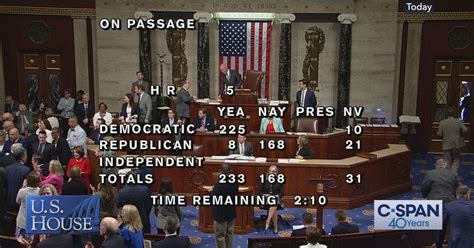 Photo credit: c-span.org
Photo credit: c-span.org
At RightDataUSA.com, we have a complete record of CPAC/ACU key votes and their results going all the way back to 1970, which is when the ACU began issuing ratings. We have also created our own ratings, based on likely ACU criteria, for the years 1961-1969 for those who are interested in ancient history.
More pertinently, we generate our own House ratings during each year, while those two higher-profile organizations do not release their data until well into the following year (if at all, in the case of the ADA). Our source for data is voteview.com, which is typically updated every few weeks and contains information on every roll-call vote taken in Congress. Aside from identifying what we consider to be key votes, we use this data to calculate Party Unity scores along with the percentage of the time each representative actually showed up for work (their Voting Percentage). An example is shown here, for Representative Elise Stefanik (R-NY)
Explanations of the various columns are provided underneath the data table. The numbers in the last two columns represent the percentage of the time which Stefanik voted liberal (according to the ADA) or conservative (according to CPAC). These numbers, for recent years, are linked to their corresponding data sets. For example, click on the number "71" in the "Conserv." column for the year 2024, and you will be taken to a page which lists all 23 CPAC key votes -- one of which was so important to them that it is double-counted -- and how Stefanik voted on those 23 issues. Her rating of "71" means that CPAC believes she voted the conservative position 71% of the time in 2024.
As noted in the explanations, the liberal and conservative figures for a year do not necessarily add to 100% because ADA and CPAC use different sets of key votes for their evaluations.
Click through to this page to see details regarding all CPAC key votes for 2024. The subject of the first one was the Biden administration exempting electric vehicle chargers from "Buy American" requirements. Stefanik voted the right way on this issue. To see how the entire House voted, click on the Result ("Passed 209-198"):
Vote Data for SJRES38 (118th Congress) Subject: Waiver of Buy American Requirements for Electric Vehicle Chargers
That page is sorted by Yeas/Nays by default, but can also be sorted alphabetically, or by party or state. A green check next to a member's name indicates that he voted the right way; a red X means that member voted the wrong way. There are pages such as this on RightDataUSA.com for every single key House vote since 1961, but probably few users have discovered them up to now.
While updating the pages of all 2024 House members to reflect the recently-released CPAC figures, we noticed that in many cases their ratings deviated from our own ratings by a substantial amount. The table below displays data for each congressman -- the CPAC rating, the RightDataUSA rating and the aggregate rating (a combination of CPAC ratings and ours).
Right at the top of the chart is one good example of this divergence: Alaska representative Mary Peltola, a Democrat who was defeated for re-election last November, was assigned a 53% conservative rating by us for 2024 but only 22% by CPAC. Peltola, as a Democrat from a supposedly solid "red" state, was forced to masquerade as a moderate in order to have any chance of returning to the House for a second term; she came close but lost by 2.4%.
How conservative was she, really? Note that even 22% is a very high conservative rating for a Democrat these days and 53% is stratospheric. In the event of a major difference between our rating and CPAC's rating, the truth typically lies somewhere in between. Peltola's aggregate rating was 40% for 2024.
For 2024:
The average GOP representative received a rating of 79% from CPAC and 91% from RightDataUSA.
The average Democrat representative received a rating of 2% from CPAC and 9% from RightDataUSA.
The average House member received a rating of 41% from CPAC and 50% from RightDataUSA.
Why are the two sets of 2024 House ratings so different in many instances? Our evaluations skew to the right as compared to those of CPAC. Of the 441 representatives who participated in House votes in 2024, we assigned a higher conservative rating than CPAC to 353 of them; we assigned a lower rating to only 51 (37 received identical ratings from both sources).
Even though RightDataUSA and CPAC are approaching this subject from the same conservative perspective, there was surprisingly little agreement on what constituted a key vote in 2024. Between the 23 votes CPAC selected and the 39 we selected, there were only two which overlapped. Furthermore, there was a considerable differentiation in the type of key vote which was selected.
Each key vote can be assigned to one of the following categories:
Many key votes could easily be assigned to multiple categories (e.g. practically every vote has some economic component to it), however we limited all votes to a single classification. As one example, all key votes dealing with border control and/or illegal immigration are classified as Social rather than Foreign because it is much more of a social issue than one of foreign policy; but illegal immigration, like so many other vote topics, has a compelling economic impact as well.
CPAC's 23 key votes break down as:
- 62.5% Economic
- 29.2% Social
- 8.3% Foreign
Our 39 key votes were distributed as:
- 20.5% Economic
- 59.0% Social
- 20.5% Foreign
Once CPAC ratings are available for a particular year, we allow them to supersede our own ratings and therefore we display the CPAC data and remove ours (we may update the site to show both datasets shortly). Here is a listing of the 39 key House votes we selected for 2024:
- Denouncing the Biden administration's open-borders policies
- Impeaching Alejandro Mayorkas, Secretary of Homeland Security
- Extension of continuing appropriations for 2024
- Laken Riley Act
- Denouncing the Biden administration's immigration policies
- Protecting Americans from Foreign Adversary Controlled Applications Act
- Denouncing the Biden administration's anti-American energy policies
- Cutting Green Corruption and Taxes Act
- Prohibiting warrantless searches of U.S. personal communications in the FISA database
- Renewing FISA (the FBI's tool often used against conservatives) for 5 years
- Expanding prohibited disclosures of stored electronic communications
- Rescinding Biden's waiver of Iran sanctions
- End the Border Catastrophe Act
- "Emergency" spending on Ukraine
- Alaska's Right to Produce Act (also selected by CPAC as a key vote)
- Reinstating Migrant Protection Protocols
- Hands Off Our Home Appliances Act
- Equal Representation Act (also selected by CPAC as a key vote)
- DC CRIMES Act
- Security assistance for Israel
- Banning non-citizens from voting in DC elections
- Sanctions against the International Criminal Court
- Defense Department funding of sex change operations
- Defense Department funding of abortions
- Eliminating DEI in the Defense Department
- Requiring proof of citizenship to vote
- Finding Attorney General Merrick Garland in contempt
- Condemning "border czar" Kamala Harris for dereliction of duty
- Obedience to the World Health Organization
- Chinese spying and other issues pertaining to Communist China
- No Foreign Election Interference
- Violence Against Women by Illegal Aliens Act
- FY 2025 continuing resolution
- End Woke Higher Education
- No Bailout for Sanctuary Cities
- Accountability for key officials in the Biden-Harris administration
- Leaking the Ethics Committee report on Rep. Matt Gaetz
- Midnight Rules Relief Act
- American Relief Act
Is there any doubt that these votes were on issues which should be of great importance to conservatives? Why did CPAC omit 37 of these 39 votes? Are economic issues -- which they strongly lean towards -- really that much more important than other issues? Was there a desire by CPAC to choose a set of votes which would yield ratings that match their subjective evaluations of certain representatives? Or are we at RightDataUSA overemphasizing social issues and neglecting economics?
It should be apparent that the dual sets of votes were selected independently of each other -- during 2024 we had no idea which votes CPAC was considering and (unless they actually visit this site) they had no idea which votes we deemed to be critical.
In 2025 the pattern is similar. There are no CPAC ratings to compare to yet, and there probably won't be any until well into 2026. However our 2025 ratings of House members bear a strong resemblance to the ones we generated during 2024, in the sense of being noticeably to the right of what some folks might consider to be accurate.
So far in 2025 we have selected 20 House votes as being key ones. Republicans are for the most part so thoroughly united that nearly all of them score at about 90% -- and it would be closer to 100% if we reversed our position (which corresponds to CPAC's position) on the abominations known as Continuing Resolutions (CRs). These resolutions are a cowardly way for Congress to avoid passing an actual budget, thus allowing government spending, the burden on taxpayers and the national debt to continue to spiral out of control because -- so the politicians claim -- the only alternative is the dreaded Government Shutdown. All Republican politicians live in mortal fear of that, since the Democrat Propaganda Machine known as "the media" will ensure that blame is placed solely on one side of the aisle in the event of a so-called shutdown.
CPAC always opposes CRs, and so do we. The pair of CRs among our key votes in 2025 are the only ones in which Republicans as a group get a failing grade because they voted in favor; opposition Democrats therefore get a passing grade for opposing CRs, however ludicrous it may be that a majority of Democrats are assigned to the "right" side on anything.
If Republicans have majorities in the House and Senate (which they do) and if they are so united (which nearly all of them are) then why are those majorities not accomplishing more?
Clearly it's because those majorities are so extremely narrow.
The GOP has some ornery contrarians (like Rand Paul and Thomas Massie), grandstanding war-mongering pricks (like Lindsey Graham) and outright Democrats posing as Republicans (like Susan Collins and Lisa Murkowski). When only one or two votes are needed to thwart legislation, these people and others who occasionally behave like them rise to the occasion and become the liberal media's Queen For A Day. Other times, principled conservatives may refuse to be whipped into line on a particular piece of legislation because they will not concede that it is 15% good while being "only" 85% terrible, and the rebels may temporarily receive Strange New Respect from the media as a reward (a reward full of ulterior motives) for derailing something the media objects to.
Summary: It's a good idea to be able to evaluate congressmen to determine whether their performance in Congress is in line with the voters of their districts. Several organizations attempt do that, although most such organizations are ones which obsess over a single issue; therefore their ratings appeal only to voters who share that same obsession. A few organizations, including RightDataUSA.com, evaluate members of Congress over a wider range of issues that is based on a larger sample of votes. However, even groups who are on the same side of the political aisle can disagree about the level of liberalism or conservatism that is expressed via a sample of a congressman's votes. Here we have presented our ratings alongside those from CPAC, and readers can decide for themselves which ones to accept.
As we get closer to the 2026 midterms, these evaluations will take on greater significance and we will update our ratings as we did here in 2024. Urban Democrat congressmen must always guard their left flanks in primary elections lest a younger and more aggressive and hate-filled ultra-liberal challenge them. In other districts, Democrats are well aware that "moderation" (fraudulent though it is) is a sensible thing. In both types of districts, the degree to which incumbents are concerned with their re-election chances will be reflected in their votes.
On the Republican side, the GOP establishment is never interested in having more aggressive conservatives in Congress, and will help squishy incumbents with financing and by creating "paper conservatives" when necessary, to flood the primary ballot and split the right-wing vote. Even with all that GOPe assistance, supposedly vulnerable left-wing Republican incumbents normally run to the left as elections approach, and that will be apparent in their vote ratings too.
To make an educated choice, particularly in a primary election, smart voters will want to know everything they can about the person they are voting for -- or against.
Tags:
U.S. House
Ratings
CPAC
|
|
4/15/2025:
U.S. House District Analysis -- What Are "PVIs"?
[RightDataUSA]
|
Not all House districts are created equally, in partisan terms. Some are designed to elect Democrats, some are designed to elect Republicans, and a comparatively small handful could go either way. When U.S. House elections roll around, as a couple of special ones did in Florida earlier this month, there is a desire to quantify districts so that people can anticipate the outcomes. Does Candidate A have any chance at all against Candidate B? How close should the race be? Could there plausibly be an upset?
Analysts often describe the direction (and degree) to which a House district leans by referring to something called a PVI, which stands for Partisan Voting Index. Here is a rare example of an unbiased and almost factual statement (which references PVIs) from a typically biased article published by a thoroughly left-wing source:
"The Cook Political Report's partisan voting index (PVI) classifies both [Florida special election] districts as Republican-favored, with FL-1 as R+22 and FL-6 as R+7."
On April 1, Republican Jimmy Patronis won the special election in FL-1 by a margin of 14.6%; Republican Randy Fine won the special election in FL-6 by 14.0%.
[The left-wing article had the FL-6 number wrong; it should have been R+14 and not R+7. You'd think they would want to be especially accurate here, in order to make their party's "moral victory" not appear to be such a small one.]
So what is all this "R+" stuff?
It's nomenclature created by political analyst Charlie Cook, for the purpose of evaluating House districts; Cook claims to have published the first such data in the late 1990s. His evaluations, which are known as PVIs, are considered to be the gold standard for district ratings. When you see how they are created, you may find yourself wondering why they hold such a lofty status.
From Cook's website: "The Cook Partisan Voter Index measures how partisan a district or a state is compared to the nation as a whole. A Cook PVI score of D+2, for example, means that district performed an average of two points more Democratic than the nation did as a whole, while an R+4 means the district performed four points more Republican."
These ratings are not merely measures of past performance; they are also imbued with predictive value and are used to answer questions about future elections in House districts, questions such as the ones in the opening paragraph of this commentary.
A slightly more detailed explanation of the calculation comes from Wikipedia: "The [PVI] looks at how every congressional district voted in the past two presidential elections combined and compares it to the national average. The Cook PVI is displayed as a letter, a plus sign, and a number, with the letter indicating the party that outperformed in the district and the number showing how many percentage points above the national average it received."
We emphasized part of that last sentence because the vast majority of people who throw around PVIs are clueless about the actual meaning of the numbers, and misinterpret them entirely. This misinterpretation is not of tremendous import as long as the numbers are merely being compared to each other, which after all is their primary purpose. In the above example FL-1 is obviously a more Republican-leaning district than FL-6. Even those who are mathematically-challenged are capable of understanding that 22 is a larger number than 7 (or even 14), though they have no idea -- or the wrong idea -- of what the "22" means or how that number was calculated.
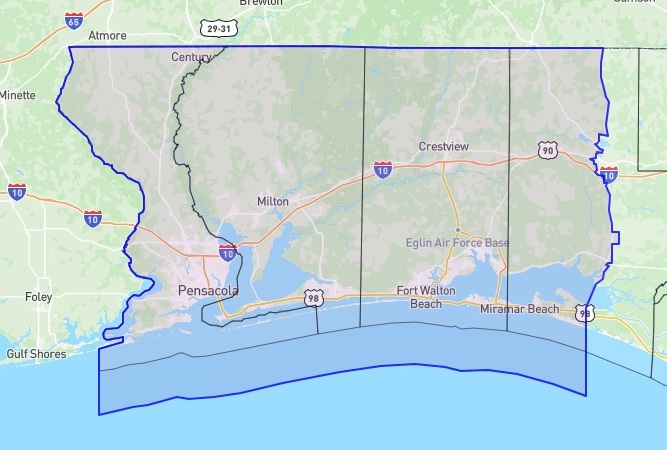 Florida congressional district 1
Florida congressional district 1
Let us illustrate. Both Republicans on April 1st won easily in their respective Florida special elections, however given the lean of their districts they appear to have underachieved. This enabled the media and other Democrats to claim hollow "moral" victories in the wake of Democrat defeats, because the GOP candidates did not obliterate their liberal rivals by as much as they were supposed to.
Nevermind that at least one feverish poll in late March -- this one by the rabidly liberal "St. Pete Polls" -- was gleefully anticipating a possible actual Democrat victory in FL-6 and not merely a moral one. Sounds more like the Democrat was really the true underachiever in that case, seeing as how he ended up losing by almost 15 points; but only if you believe polls which are published in the liberal media for no purpose other than gaslighting -- energizing Democrat voters and attempting to suppress Republican turnout. The gaslighting in Florida, along with astronomical Democrat funding by wealthy out-of-state contributors, certainly did have an effect on these outcomes.
How do we know how much the two Republicans were "supposed to" win by? The PVI of the districts tells us.
Using FL-1 as an example, its rating of R+22 does not mean "a Republican typically wins this district by 22 points". What R+22 does mean is "a Republican in this district typically does 22 points better than average". Those are hardly equivalent statements.
In any 2-way race the average is 50%. If the Republican does 22 points better than average, he gets 72% of the vote. Which means the Democrat gets 28%. The Republican therefore does not win by a margin of only 22% in a typical 2-way race in an R+22 district; he wins by 44%. Winning by only 14%, as Patronis did in FL-1, was indeed a substantial underachievement. Sub-par Republican performance is a regular occurrence in special elections and, as we have pointed out many times, does not necessarily portend anything for the future. Neither FL-1 nor FL-6 are suddenly lurching leftward, and even the Democrats know it.
 Florida congressional district 6
Florida congressional district 6
Randy Fine won FL-6 (PVI of R+14) by exactly 14 points, which sounds like a precisely typical result there. But R+14 does not mean the Republican should win by 14%; it means the Republican should win by 28%. So yeah, another "moral defeat" (LOL) for the GOP. Once again, this outcome is not a harbinger of future performance. In November of 2026 the GOP will win that district every bit as easily as it usually does, and Democrats will not be pissing $10 million of billionaires' money down the drain as they did a few weeks ago, no matter how easily they can afford to do so.
The Cook Political Report (CPR) has lately decided to charge a fee for up-to-date district ratings, which is a shame (for those who actually fork over cash) because their ratings are based on very limited data, and that data contains an overwhelming bias in the logical sense as opposed to the partisan sense. Anyone who has the time, the ability, and the underlying data can calculate PVIs that are not only free of charge, but which are more accurate if based on a wider range of relevant data.
The Cook Political Report's current bias can be summarized as "All Republican candidates are Donald Trump". Does that sound like a good assumption to make? Democrat campaign coordinators and their media allies surely agree with Cook, but sensible folks would dispute his assertion.
The CPR looks at two -- just two -- points of data for every congressional district in the country, and then anoints the districts with their sacred ratings based on that meager amount of data. The two data points are these, currently:
- 2020 presidential election result in the district
- 2024 presidential election result in the district
Astute observers will notice that the one and only Republican in this sample is Donald J. Trump. Thus, Cook is determining district ratings based solely on how much that district voted for or against President Trump. Does an affinity or a hatred for Trump all by itself determine exactly how other Republican candidates -- the ones in U.S. House races -- will fare in their specific districts? What kind of idiot would assume that it does?
Below we provide the RightDataUSA.com PVI ratings, without any fee, for every U.S. House district in the country. Our ratings are likely to be similar but hardly identical to the "official" Cook PVIs (we don't know and we aren't paying to find out), because our ratings are based not only on the last two presidential elections but also on many other recent statewide elections. In the table, the "2024 Result" is the percentage which the victorious House candidate received in the November, 2024 election.
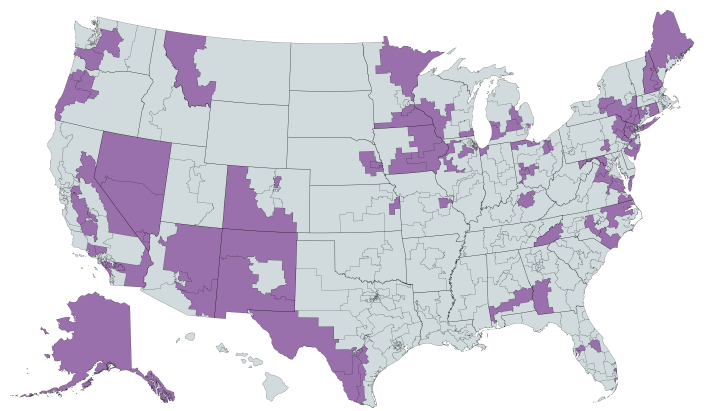 Map of 2026 battleground districts,
created using mapchart.net
Map of 2026 battleground districts,
created using mapchart.net
First, a note about the most competitive districts: Battleground districts are highlighted in the map above and in the table of all House districts which appears further down this page. It is unusual for a House member to win election in a district which tilts 6 points or more towards the opposite party although it does occasionally happen, so we define a "battleground" district as one in the range from D+5 through R+5. When upsets occur in House elections, they normally take place in these marginal districts, and therefore aren't truly "upsets".
Twelve House districts flipped (switched from one party to the other) in the 2024 House elections, not counting those flips which were solely caused by 2024 redistricting. We omit the court-ordered gerrymandered Democrat victories in AL-2 and LA-6. We also exclude the three North Carolina districts in which Democrats were replaced by Republicans after the N.C. Supreme Court discarded a couple of Democrat gerrymanders and allowed the state legislature to handle the drawing of the district map in accordance with state law. The previous Democrat-controlled court had appropriated that task for itself in 2020 and 2022. Here are our ratings for the other 12 flippers:
- AK-at large (went from D to R): R+5
- CA-13 (R to D): even
- CA-27 (R to D): D+2
- CA-45 (R to D): even
- CO-08 (D to R): D+1
- MI-07 (D to R): D+2
- NY-04 (R to D): D+5
- NY-19 (R to D): D+1
- NY-22 (R to D): D+4
- OR-05 (R to D): D+2
- PA-07 (D to R): D+1
- PA-08 (D to R): even
In three cases above (CO-08, MI-07 and PA-07) the district is currently held by the "wrong" party -- the one which voters normally do not favor in statewide elections. You can bet that these three, plus other similar districts, are the ones which the national parties will have at the very top of their target lists in 2026. Those other similar districts are:
- AZ-01 (Schweikert): D+1
- AZ-06 (Ciscomani): D+2
- CA-21 (Valadao): D+1
- ME-02 (Golden): R+3
- MI-10 (James): D+1
- NE-02 (Bacon): D+2
- NH-01 (Pappas): R+2
- NH-02 (Goodlander): R+1
- NY-17 (Lawler): D+4
- OH-09 (Kaptur): R+1
- PA-01 (Fitzpatrick): D+3
Based on the above lists, there is much more low-hanging fruit for Democrats to pick off in 2026 than there is for Republicans. Not to mention the two Republicans in already-marginal districts (Brian Steil, Derrick Van Orden) who are destined for extinction by the upcoming court-ordered Democrat gerrymander in Wisconsin. These are not the only districts which have a chance of flipping in 2026. In order to maintain control of the House, Republicans will need to hold on to a significant majority of their most vulnerable seats and perhaps achieve a small number of pickups of Democrat-held seats. They narrowly succeeded in 2024, but it will be more difficult in '26.
Update: Either we caught them on a good day or they've decided to drop the paywall for some reason, but the 2025 Cook PVI ratings are currently available even for non-subscribers! We still believe that more data means greater precision, but now readers can compare the two sets of ratings and decide for themselves.
Tags:
PVI
Charlie Cook
U.S. House Ratings
More Data = More Accuracy
|
|
1/11/2025:
2024 Special Elections: Not So "Special" for Democrats After All
[RightDataUSA]
|
Prior to November in 2024 there was considerable wailing and pearl-clutching on the right (and gloating on the left) over the underperformance -- if not worse -- of Republican candidates in special elections at the congressional and state levels.
 Photo credit: abc7ny.com
Photo credit: abc7ny.com
It's true that Democrats did win the most important special election of them all. That took place in February in New York's 3rd congressional district, where ex-incumbent Thomas Suozzi (D) easily defeated newcomer Masi Melesa Pilip (R) in that D-leaning district. The election was held in order to select a replacement for freshman Republican George Santos, who was expelled from Congress in December, 2023. The impetus to oust Santos came not so much from Democrats, but mainly from Santos' own party and particularly his fellow Republican freshmen in the New York delegation. Those frightened frosh were fearful of Santos dragging them down with him in November, so they pre-emptively removed him and thought they had solved their problem.
They hadn't. As we noted even before the February special election outcome, those NY freshmen congressmen were greatly endangered regardless of the disposition of the Santos situation. Most of the other Five Freshmen -- Nick LaLota (CD-1 and the only real non-fluke), Anthony D'Esposito (CD-4), Mike Lawler (CD-17), Marc Molinaro (CD-19), Brandon Williams (CD-22) -- had won in fluke outcomes in 2022 and it was always likely that their numbers would be thinned considerably in November, 2024.
 Photo credit: desposito.house.gov
Photo credit: desposito.house.gov
They sure were, exactly as we predicted. In CD-22 Williams was victimized by a Democrat gerrymander which removed good areas of his marginal district and replaced them with bad ones; it didn't require a major change to the lines, just a little push further to the left was sufficient. In September, anti-Santos ringleader D'Esposito was accused by the liberal media of having an affair and then putting the woman on his payroll, but he was a dead man walking even before that. Molinaro went down in flames in CD-19 as well.
In another special election for Congress which took place in June, liberals cackled about Republican Michael Rulli's supposedly weak showing in Ohio's 6th congressional district, where he defeated a relatively penniless Democrat by "only" 9 points in a district which is typically much more GOP-leaning than that. We wrote about that outcome here and noted presciently that Rulli would have no trouble at all in the November rematch. He won by over 30 points. Special elections are often influenced heavily by organizational and motivational factors, and Republicans normally lack both of those in low-turnout elections which are little publicized on the right.
Moving down to the state legislative level, in September, 2023 readers were scolded by some trembling GOP establishment blogger who calls himself "Bonchie" that Republicans had failed to learn from the numerous defeats of conservative candidates in 2022 and were still fielding bad (i.e. "conservative") candidates in special elections instead of nice, squishy, electable moderates.
He specifically referenced New Hampshire where a conservative GOP nominee lost a 2023 special election in a microscopic state House (not congressional) district that was fraudulently described by the blogger as being solidly Republican. That Republican candidate, minister James Guzofski, did himself no favor by inviting the liberal media to portray him as a kook when he declared something like "Jesus told me that Donald Trump really won in 2020!", and the minister came out on the wrong end of a narrow decision in 2023. "Bonchie" concluded from this infinitesimal sample size that certain disaster awaited the GOP in the 2024 elections everywhere if they didn't heed his warning and run screaming to the left.
Guzofski ran again in November, 2024 against the same Democrat who had defeated him in that 2023 special election where less than 3,000 people bothered to vote. This time Guzofski wasn't such a bad candidate after all -- over 50% of the voters chose him and Republicans swept all 3 state House seats in that New Hampshire district.
In Florida a marginal state House district in the deteriorating Orlando area was vacated by an incumbent Republican, and the special election in January, 2024 went as expected: Democrat Tom Keen won by 2.6 points in a district which favors his party by about 2 points. As liberals were going bonkers about this "major upset" the massive GOP margin in the FL state House was merely reduced from 85-35 to 84-36. Hardly an occasion for panic, except for those who are easily rattled.
What happened the next time a real election rolled around? Keen lost by nearly 4 points to Republican Erika Booth in this Democrat-leaning district, and once again those who had previously declared that the world was coming to an end were proven to be Chicken Littles.
Another example: In a state House district which lies just north of Oklahoma City, liberals were outwardly cheerful despite yet another defeat because it was by a much closer margin than expected. Republican Erick Harris prevailed by only 5.3% in a February special election in a district that Democrats hadn't even contested since 2018. Nervous Nellies on the right got the vapors again. Democrats weren't fooled by the fluke outcome although they took the opportunity for some big talk. In November the Rats failed to come up with any nominee at all, and Harris trounced a Libertarian to easily hold the R+14 seat. The Rats never had a chance in this district, but acted as if they did and some idiots believed them.
The lesson which should be learned here is -- most of the time, anyway -- there is nothing to be learned from low-turnout special elections, especially when they take place in puny little state House districts; and even more so when the balance of power won't be affected one iota no matter what the outcome is (like in Florida and Oklahoma).
Occasionally special elections DO portend a future wave, as in 1993-94 when Republicans won U.S. House elections in places where they had never previously prevailed (like in OK-6 and KY-2) and came surprisingly close to winning in WI-1 which Democrats had held for a quarter-century at the time. Democrat Peter Barca almost lost in 1993 and did lose in 1994; the Rats have never won there again, nor have they ever won again in those Oklahoma and Kentucky districts.
There will be 3 special elections to Congress coming up in the first few months of 2025: FL-1 (Matt Gaetz), FL-6 (Michael Waltz) and NY-21 (Elise Stefanik). These vacancies have occurred because the incumbents were nominated for positions in the second Trump administration, though Gaetz has since withdrawn. Each of these 3 districts are solidly Republican, and Democrats will not be winning any of them. But the liberal media will still be watching closely. When a Republican prevails easily, you'll never hear about it -- however if a Democrat does 0.1% better than expected it will be used as anti-Trump propaganda and described as a preview of a definite Republican bloodbath in the 2026 midterms.
A bloodbath may in fact happen and the 2026 midterms may be similar to those of 2018, but that has nothing to do with these 3 elections. In all likelihood, what special elections in 2025 and 2026 will tell us about the future is. . . . nothing.
Tags:
2024
House
Special (?) elections
|
|
11/6/2024:
Congrats to President Trump! He Still Needs a House
[RightDataUSA]
|

November 5th was a wonderful night to be an American, and we get to begin enjoying the election results today!
As we had been stating all along, the "landslide" which delusionals on both sides were certain was going to happen (Virginia to Trump! Iowa to Harris! Cao wins VA Senate! Allred defeats Cruz! LOL!) was never going to materialize. But Donald Trump was able to get back to where he was on election night of 2016, and he will be the 47th President of the United States. The Senate has gone almost exactly as expected as well, with GOP pickups in West Virginia and Montana as well as a big tossup win in Ohio. Republicans may even get a bonus Senate seat or two in Pennsylvania and Nevada once all the votes are counted, although those are likely to turn out to be mirages. [Update: PA is being declared a win for McCormick though Democrat election-deniers refuse to concede; Nevada did what it always does to Republicans, though at least Trump won there.]
But the extremely important U.S. House is still up for grabs.
As we predicted, a Trump win in 2024 could easily be accompanied by Republicans losing control of the U.S. House of Representatives. We forecast a net loss for the GOP of 2 to 8 seats and that is very likely what is going to happen -- though we won't know for sure for possibly as long as a month. Democrats need a net gain of four seats in order to seize control of the House from the Republicans. Surely they are planning for that coup by working on articles of impeachment for President Trump already.
The reason for the delay is Ballot Harvesting Month in the state of California. This is where party operatives (mostly Democrats) try to locate people who did not vote, and get them to fill out a ballot for the candidates of their choice. The party's choice, that is.
This will not affect the outcome of the races for President or Senator in California, but it will massively affect approximately half a dozen House races or perhaps even a larger number.
As this is being written on the morning after the glorious election, there are another two dozen or more House districts where insufficient votes have been counted or which are still too close to call despite nearly all votes having already been tabulated. We will enumerate these below.
Here are the districts which have been called as of Wednesday morning, and which have flipped from Republican to Democrat:
Here are the districts which have been called and which have flipped from Democrat to Republican:
These initial districts flipped almost solely due to the effects of redistricting. In Alabama and Louisiana, racist court rulings mandated the ouster of White Republicans from the House and the substitution of black Democrats. In New York, Democrats belatedly gerrymandered the state earlier in 2024, but NY-22 was likely to be lost even without that factor. In North Carolina, an illegal Democrat gerrymander which had been in place in 2020 and 2022 was finally removed and replaced by a legitimate district map. The Michigan district was an open seat which was formerly held by Democrat Elissa Slotkin, who left to run for the Senate (and probably win, but that's not been called yet).
Here are the other potential pickups for Republicans:
CA-47 (open seat) Scott Baugh gave it a good shot in this D+3 district. No GOP pickups in CA this year but only minimal losses.
ME-2 (Golden) Golden pulls it out again, unfortunately. He is the most "moderate" Rat in the House, though.
WA-3 (Perez) Southwest WA rejects a good conservative for the second time in a row; Perez holds on.
- CO-8 (Caraveo) One of the top GOP House targets finally comes through almost a week after election night.
OH-9 (Kaptur) Got the Ohio Senate seat, but the GOP really blew it in OH at the House level, where +2 was quite possible.
- AK-at large (Peltola) See what happens when the GOP gets smart for a change and limits intra-party warfare?
NV-3 (Lee) Another close-but-no-cigar, as so often happens in Nevada.
- PA-7 (Wild) For the first time since these PA districts were gerrymandered into existence...
- PA-8 (Cartwright) ...the GOP takes them! They had been 0-for-2 for three straight elections.
MD-6 (open seat) Would have been a big upset, but the Rat was so repugnant that it almost happened.
CA-9 (Harder) The GOP didn't really try hard here, but came close anyway.
Here are the other potential losses for Republicans:
- NY-4 (D'Esposito) D'Espo has bitten the dust; the GOP needs all possible seats, but good riddance to this scumbag.
- NY-19 (Molinaro) Molinaro went down too in the bloodbath in NY; GOP frosh lost 3 of 5 (4 of 6 if you count Santos).
- CA-13 (Duarte) A victim of California's Ballot Harvesting Month.
CA-22 (Valadao) An unexpectedly early and positive result!
- CA-27 (Garcia) It was never reasonable to think that ALL vulnerable Republican incumbents in CA were going to win, as we have noted since 2022.
CA-41 (Calvert) But this one did; good for Calvert for defeating a particularly slimy and hateful Democrat.
- CA-45 (Steel) Another victim of California's Ballot Harvesting Month.
NE-2 (Bacon) Bacon has won (!). He's no bargain, but he's better than the alternative.
PA-10 (Perry) Perry (barely) survives as GOP sweeps the winnable eastern PA districts!
- OR-5 (Chavez-DeRemer) Another lost seat. The 2022 (R) win here was an obvious fluke right from the start.
CO-3 (open seat) The Rat spent more ($15 mill) than any House challenger in the COUNTRY. And still lost. Ha ha.
IA-1 (Miller-Meeks) By a razor-thin margin, MMM has been declared the winner.
AZ-1 (Schweikert) A good conservative holds on to his seat.
AZ-6 (Ciscomani) This moderate-to-somewhat-conservative freshman wins a second term.
MI-10 (James) James won.
Republicans need to find some pickups and limit their losses in order to maintain House control. We will update this commentary as more districts are called. At the moment, Decision Desk (DD) is predicting a net loss of only 3 seats for the Republicans which, if true (and their forecast is just a guess at this point) means that Republicans will maintain control by the narrowest possible margin: 218-217.
At one point on 11/6 DD saw a possible R+2 outcome in the House; they are predicting R-1 as of the evening of 11/8 and have been sticking to that number ever since. R-1 means they keep control, 220-215.
Update 11/9: DD shows 11 House races uncalled and the GOP needs only to win 2 to maintain control; DD believes they will win 4 of the 11. Evans (R) is now ahead of Caraveo (D) in CO-8; Ciscomani (R) is clinging to life in AZ-6 and Begich (R) is ahead but still short of the necessary 50% in AK. All other undecided seats are in CA and Republicans lead in some of those too.
Update 11/10: Golden may not win in ME-2 after all -- with all ballots counted he has fallen below 50% and therefore the race will be decided by Rigged Choice Voting just like it was in 2018 when that scheme was first used in Maine. Golden is still likely to win, but apparently not 100% certain at this point.
Update 11/11: Most media called it on Sunday but now everybody says that Republicans have picked up CO-8. AZ-6 is still too close to call and they're all asleep in Alaska, where vote totals haven't moved in a long time. Republican incumbents will probably lose no more than 2 seats in CA (we hope) and there will be no pickups there, but in the end the House should stay (R).
Update 11/12: It's over (as far as who will run the House) -- Republicans hold CA-41 and AZ-6 but lose CA-27. A net of minus-1 there may not sound impressive, and it's not, but it is sufficient to reach the 218 threshold; they are at 219 with possibly 2 more wins yet to come (AK and CA-13). If those wins materialize we'll wind up exactly where we started, with Republicans having a 221-214 advantage. That outcome may also sound unimpressive, but given the number of marginal districts which had to be defended, merely breaking even isn't bad at all and a slightly better outcome than realists like us projected for them.
So far Trump has named 2 incumbent GOP House members to his administration, which will necessitate special elections in FL-6 (Waltz) and NY-21 (Stefanik). Those special elections should be easy wins for the Republicans.
Final update: In mid-December the GOP lost the last 2 House elections to be called, both of them in California, and both in districts where Republican incumbents had been leading for over a month. Democrats were able to "harvest" enough ballots to put their candidates over the top just before time expired. The final count then is 220-215, a net loss of 1 seat for the GOP -- slightly better than we expected (-2 or a little worse) but far worse than the conventional "wisdom" which desperately envisioned House gains to go along with a presidential win.
Tags:
2024
House?
We'll find out in December
|
|
11/2/2024:
Election 2024: The Final Hours
[RightDataUSA]
|
 Photo credit: CNN
Photo credit: CNN
With just a few more hours until the 2024 election campaign season mercifully concludes, we are on track for one of the closest elections in U.S. presidential history if the polls can be believed. But some folks are not so sure about that, and are thinking in terms of "waves" and "landslides" that will deliver not just the White House but also the U.S. House and Senate. For example (just from the past few days):
But also:
These polar-opposite worldviews are hardly unexpected; the fragile snowflakes on both sides (there are far more on the left, but no shortage on the right either) need to be constantly reassured that things are going their way, no matter what "lies" they may hear which say otherwise. Pay no attention to the man behind the curtain and believe everything we tell you, they say. Well, somebody is lying, and somebody is going to be crushingly disappointed on November 6th or whenever the vote-counting finally ceases.
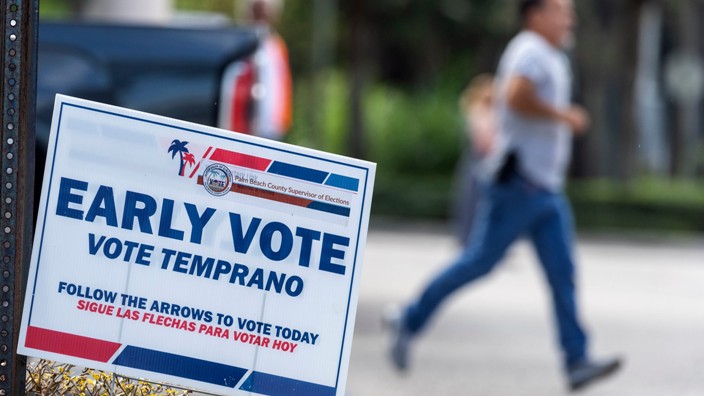 Photo credit: Palm Beach Post
Photo credit: Palm Beach Post
Early Voting
We've heard a great deal about how well the GOP is allegedly doing in Early Voting, even in heavily Democrat states like New Jersey, and it's being claimed that Early Voting is going to be the critical determinant as to which side wins once all the votes are in.
The only available facts about Early Voting pertain to the number of ballots requested and returned, which are normally broken down by party registration in those states which actually register voters by party. Until election day when the ballots are counted, there is no way to know who the early voters actually voted for in any race. Therefore it is nothing more than assumptions at this point regarding any of the following:
Assumption #1: "Republicans vote for Trump, Democrats vote for Harris, and we have no clue about independents but we'll pretend that we do." A related happy assumption is that there will be less defections among Republicans than Democrats; i.e. more Democrats are crossing party lines to vote for Trump/Vance, than Republicans who are voting for Cackles and Tampon Timmy. This could turn out to be an unfortunately specious assumption, though not a particularly impactful one.
Assumption #2: Independents are "breaking for the challenger (Trump, in this case) as they normally do". That's probably just an old wives' tale to begin with, and yet another possibly incorrect assumption. All states have a significant number of so-called independent voters, and in numerous states there are more such voters than either Republicans or Democrats. Most people are likely unaware of this fact. So even if Trump, for example, holds 94% of Republicans but Harris only takes 92% of Democrats, that minor difference is absolutely swamped by how the indies vote.
A good illustration of the above comes from 2016 exit polling. Hillary did infinitesimally better (89%) among Democrats than Trump did among Republicans (88%). Both candidates lost 8% of their party to the other side and the remaining 3-4% voted for neither Trump nor Hillary. For every White lower/middle-class Democrat blue collar worker who was attracted by Trump's populist messaging, one liberal suburban soccer-mommy "lifelong" Republican ran sobbing hysterically over to the left and so it was a wash.
Indies made the difference in 2016. Trump did better with them than Hillary, 46% to 42%, though it wasn't sufficient to win the overall popular vote. But it was sufficient to help put him over the top in the closest states. That was 2016; Trump lost indies by 13 points in 2020 (54%-41%), while both he and Biden retained 94% of their own party's votes. Polls in 2024 are all over the place as they flail around trying to figure out how this critical segment of the electorate is going to vote; their sub-sample sizes are normally much too small to draw any conclusions from.
Assumption #3A: Increased GOP turnout in Early Voting will not "cannibalize" their turnout on election day. They'll still have enough voters who are willing to "crawl over broken glass" to get to the polls, and therefore the extra turnout we're seeing prior to November 5th is mostly a bonus!
Assumption #3B: On the other hand, relatively decreased Democrat turnout in Early Voting will persist through election day because many Democrats are too lazy to get up off their fat asses and stand in line; if they don't vote early, they likely won't vote at all!
The amount of bullshit those twin assumptions contain for 2024 remains to be seen. Perhaps, by coincidence, all of these assumptions will finally be correct and those who pretended they "knew" it all along will get to say "we told you so!". That would be great.
In the past, when Democrats thoroughly dominated Early Voting, we were assured that the Republican surge on election day would counterbalance the early Democrat advantage, and then some. But it never came close to doing so, even though Republican voters were often instructed to wait -- and specifically avoid voting early -- because of the fear of turnout cannibalization on the big day, and something about Democrats knowing exactly how much fraud they would need to commit.
Put it all together and you can see that there's a substantial disconnect from:
"GOP is doing a little better in early voting (we up, they down!)"
to:
"WE GONNA WIN RED WAYVE BAY-BEE!!!"
The main value these early voting stats have is propaganda value. In prior years the media and other Democrats could crow about what a huge advantage their party had and how it portended eventual victory; this year Republicans are crowing about how they have narrowed the gap a little bit or, in some cases, more than a little bit. What does it matter? Basically, it doesn't. A vote is a vote, no matter when it is cast. Even, when Democrats get their way, ones which come in well after election day.
In a nation as closely divided as this one, it appears that the potential for a "wave" that would sweep over the presidency, the Senate and the House is minimal. But it's not impossible. We'll say this much: if there is any kind of wave, it's probably going to be the kind we don't want to see. Republicans routinely underestimate the amount of hatred Democrats are capable of, and hatred is an excellent motivation for voting.
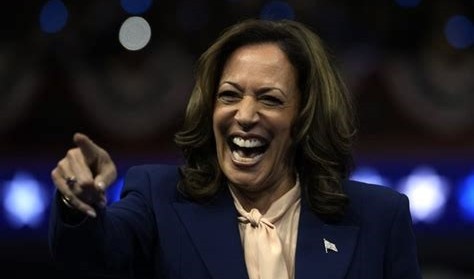 Photo credit: Twitchy.com
Photo credit: Twitchy.com
The 2024 Presidential Election:
As most observers have known all along, it's going to come down to the seven swing states: Arizona, Georgia, Michigan, Nevada, North Carolina, Pennsylvania and Wisconsin. It's entirely possible that all seven will be decided by less than 5 points, possibly much less, and right now nobody knows for a fact exactly which way they are going to go. Maybe that's why they're called "swing" states.
Crackheads on the left are dizzily contemplating Harris winning. . . Texas! And Florida! And Ohio! And IOWA!
Their hopium-snorting counterparts on the right figure Trump has a damn good shot in. . . New Jersey! And Minnesota! And New Mexico! And VIRGINIA!
For another few hours they can still dream before the Methadone of reality kicks in. It will be just peachy if Trump can merely replicate what he did in 2016, by squeaking out razor-thin victories in enough of the swing states to get to 270. The Real Clear Politics recent polling averages show the following:
[As of 7:00 AM ET on 11/5]
- Trump up 2.8% in Arizona (11 EV)
- Trump up 1.3% in Georgia (16 EV) -- but Democrats are already working on the steal.
- Trump DOWN 0.5% in Michigan (15 EV)
- Trump up 0.6% in Nevada (6 EV)
- Trump up 1.2% in North Carolina (16 EV)
- Trump up 0.4% in Pennsylvania (19 EV)
- Trump DOWN 0.4% in Wisconsin (10 EV)
If this series of miniscule margins that generally favor Donald Trump -- ALL of which are within the margin of sampling error -- carry over to the actual vote counts, then Trump will prevail in the Electoral College by the count of 287 to 251 assuming all other states go as expected. Which means that the "Keystone" to the election is the state of Pennsylvania -- as we noted long ago and wrote about in considerable detail; it is tremendously likely that whoever wins PA wins the election.
There are a couple of things to keep in mind about all of these pollsters who are showing exceedingly close races in several states at the presidential level, and in other races as well:
- Blowout fantasies notwithstanding, the pollsters aren't wrong about how close things are.
Or are they?
Nate Silver thinks they're not only wrong, they are outright lying. He doesn't say for whose benefit they are lying (it's for their own benefit, actually, so as to keep themselves relevant). So who does he think is clearly ahead?
He says: Trump 55%, Cackles 45%. That's not an expected popular vote percentage (obviously), it's the probability of victory as Silver sees it. However just a few days earlier (October 23), Nate claimed "the election remains a 50-50 coin flip". Now he's angry at pollsters who say the same thing. Have things changed so dramatically since then? Has Trump really surged that much in two weeks?
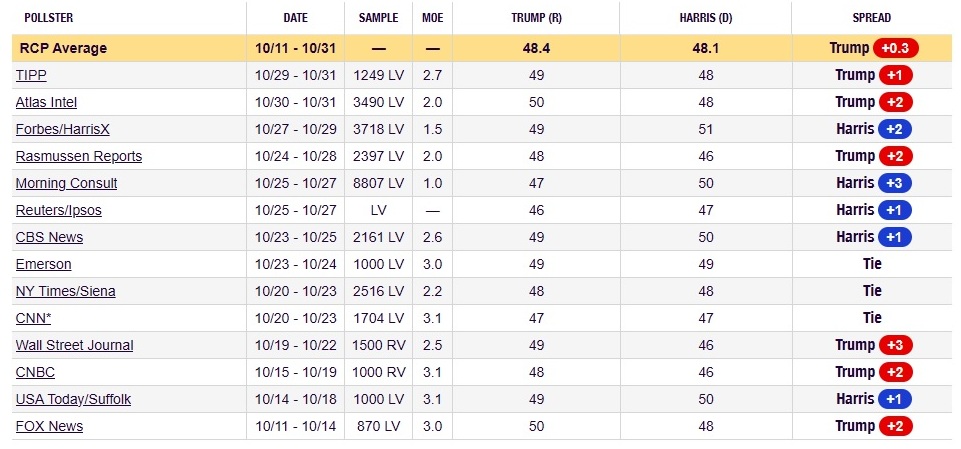 Real Clear Politics polling average as of 11/2: Trump vs. Harris (click image to enlarge)
Real Clear Politics polling average as of 11/2: Trump vs. Harris (click image to enlarge)
Trump has apparently improved his position, and it's not like a 55% chance of victory makes his election a mortal lock anyway. Presidential contests in the swing states really are likely to be nailbiters, regardless of whether Nate Silver objects or not. If the actual margins aren't quite as small as the pollsters are claiming and, for example, Harris wins and obtains a significantly greater number of votes than was expected, the pollsters will shed some crocodile tears regarding their lack of credibility. While at the same time gleefully accepting the outcome.
Even better for them: when 2028 rolls around these pollsters can be accused of having overstated Republican percentages in the recent past, instead of simply being shills for the Democrats. That would undoubtedly be a first in U.S. polling history, at least since the days of "Dewey Beats Truman!". It would remove a vital "crutch" ("ALL POLLZ ARE BI-USSSED TO THE LEFT!!1!) from amateur polling experts on the right. Let's pray it doesn't happen that way.
- By declaring so many tossups, the pollsters can't really be blamed if the result is slightly the opposite of what they predicted. Exactly how many decimal places are polls supposed to be accurate to?
For example, the final Pennsylvania poll from left-leaning (to put it mildly) Quinnipiac College asserts that Donald Trump will win by 1% there (47% to 46%) with a margin of error of 2.1%. If/when it turns out that Heels-Up Harris wins PA by a small amount then Quinnipiac can hardly be roasted for inaccurate forecasting; a swing of, say, 2% between their poll and the final outcome is not remarkable and only the perpetually-outraged would say otherwise. Besides, if the phrase "President Harris" ever becomes "a thing", there will be a hell of a lot more to be outraged about than some minor polling variance.
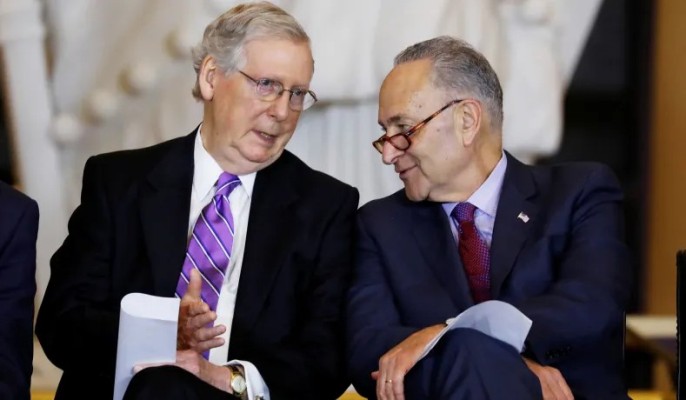 Photo credit: National Review
Photo credit: National Review
The Senate:
The Democrats currently hold a 51-49 advantage, including the four so-called "independents" who march along with the Rats. If there is one certainty in the Senate this year, it is the Republicans picking up the West Virginia seat from the retiring Joe Manchin. Recent polling is somewhat sparse, but GOP challenger Tim Sheehy is supposed to be up by about 6 points against ultra-liberal Democrat incumbent Jon Tester in Montana and, along with everyone else who is already counting that chicken as having hatched, we'll agree that in 2024 Tester finally goes down in flames after a Senate career that was much longer than it should have been.
With those two seats in hand, it would be Republicans with the 51-49 advantage next year.
Next on the potential flip list is Ohio, a supposedly crimson "red" state (like Montana) which (also like Montana) has been electing a far-left Democrat to the Senate for far too long. This race is a tossup. Incumbent Sherrod Brown has won three times in the past, by 12 points in 2006, 6 points in 2012, and 7 points in 2018 (crimson red, my ass). But that was then and this is now. Brown is in a dogfight for the first time, with polls favoring him over Bernie Moreno by perhaps a single point. Brown's margin is slender, but he is ahead in almost 100% of the polls even including Trafalgar (R).
The potential bad news comes from Florida, Texas and even rock-solid crimson, burgundy, maroon Nebraska, where an "independent" phony-moderate candidate is supposedly within striking distance of squishy Republican incumbent Deb Fischer according to the far-left New York Times and the liberal candidate's own polls; all other polls forecast a normal Nebraska outcome. The Democrats did not even field a candidate here -- aside from the one who is calling himself an independent.
Republicans are likely to hold all three of those seats. The Rats are flooding Florida and Texas with $$$ but it would still be quite an upset if Ted Cruz or Rick Scott were to lose; some now classify the TX race as a tossup. The saving grace for these two Republicans could be the laughably poor quality of their liberal Democrat opponents. But the usual Democrat formula of (money + lies + hate) = victory certainly could work.
There's one important ingredient we left out of that equation, which helps Democrats greatly when money + lies + hate isn't quite sufficient. That ingredient is normally not added until after the votes are cast.
 Photo credit: The Hill
Photo credit: The Hill
It's not necessarily about voters actually supporting the dim-bulb Democrats in FL & TX; it's more about voting against the Republicans. Neither Scott nor Cruz are popular with anything more than the tiniest majority of the electorate in their states. Trump is going to win Florida and Texas and even though casual observers will be surprised to hear that a coattail effect might be required for Scott and Cruz, that very well may be the case. We'll say they both pull it out in the end.
Nebraska could be different (though it probably won't be), and that would be the biggest upset of them all. Trump will win Nebraska by an even larger percentage than Texas and Florida, but Fischer is claimed to be running so far behind Trump that she might lose her grip on his coat; she should hardly need such assistance in the first place. Trump is not universally popular in the Cornhusker state -- he is going to lose CD-2 (Omaha) again, and the electoral vote which goes with it; and the liberal GOP House incumbent in CD-2 (Don Bacon) is looking likely to be defeated by the slimy Democrat insect who's opposing him. Trump's support in Nebraska is enormous in the rural western two-thirds of the state, but is tenuous in the Lincoln area and underwater in Omaha.
And now for the potential good news:
In the House, Republican control is in serious jeopardy because of the number of toss-up districts they must defend, because of where the toss-up districts are located, and because of the dynamics of those districts including their partisan composition and the astronomical amount of "possibly" illegally-laundered "ActBlue" money Democrats are spending.
No, that's not the good news.
The good news is that in the Senate the situation is the opposite of the House in one important aspect: it is the Democrats who must do the defending in the marginal states. Those states are:
There are also lunatic fringe pipe dreams regarding Republican pickups in Maryland and Virginia. However the GOP has zero chance in Maryland and at most a 10% chance in the Virginia Senate race. But those other six states are going to be close, to one degree or another. Ohio and Wisconsin are the most likely pickups; Arizona (one outlier poll aside) and Nevada are the least likely. Pennsylvania and Michigan currently look improbable too.
In any event, this is all gravy for the Republicans. They have nothing to lose in these states and everything to gain.
The probability, however, is that they will gain nothing, or at most one. But it would take only a very slight shift to the right, and suddenly it could be another +2! Or more! All Senate polls are close in these marginal states and, on average, they all show the Republican losing.
Final score: The most likely outcome is a net gain of 2 or perhaps 3 seats for the GOP, which means the breakdown will be 51-49 or 52-48 in the Republicans' favor starting in 2025. It may be assumed that any "wave", however low the probability is that one occurs, can only push things further in the Republican direction. But don't completely discount the possibility of an unpleasant surprise in Texas or Florida. Worst case scenario: the Senate stays 51-49 Democrat, and that is not terribly likely.
 Photo credit: Fox News
Photo credit: Fox News
As far as the likely outcome: as we have noted on numerous occasions, having only 51 or 52 seats is not satisfactory to give the GOP anything but nominal control. There are at least two Republican senators -- Lisa Murkowski (Alaska) and Susan Collins (Maine) -- who are for all intents and purposes Democrats. They can continue to sabotage GOP efforts from within as the leadership would prefer; they can drop the charade and become Democrats; or they can go the "independent" route. Regardless, GOP "control" of the Senate will be largely illusory in every way aside from perhaps mathematics.
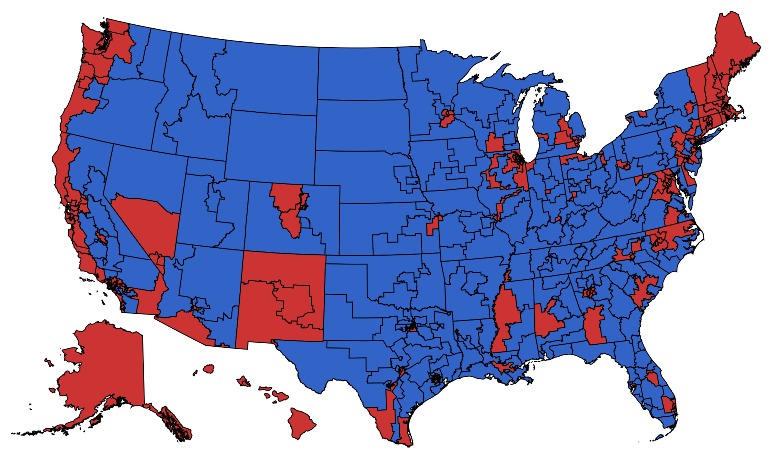 Current U.S. House breakdown by district
Current U.S. House breakdown by district
(Map created using mapchart.net)
The House:
As we wrote a couple of weeks ago, there are 40 (out of 435) House seats that can be truly considered as toss-ups this year, with perhaps another 25 lying near toss-up territory. The other 370 seats are just about 100% safe for whichever party currently holds them.
The current split in the House is, effectively, 221 Republicans and 214 Democrats; 218 is the magic number needed to have control, which means that a net loss of merely 4 House seats and it's "Say hello to Hakeem Homeboy" as the new Speaker of the House. And that means, assuming Trump wins the presidency, "Impeachment begins on day one!". It may sound incongruous that Trump could be elected while at the same time the GOP loses its grip on the House; that is not an unlikely parlay at all. When Trump "lost" in 2020, Republicans actually gained 13 House seats that November; it was as if Trump had coattails. . . but no coat for himself. This year could be the opposite, with a Trump win and GOP House losses.
Negative factors in the House:
- Republicans have far more marginal seats to defend than Democrats do.
- Republican candidates, on average, have less (sometimes much less) funding than their Democrat opponents.
- The most marginal seats are almost entirely (34 out of 40) in "blue" states which Trump is definitely going to lose, or in swing states which could go either way. Only six of the 40 are in states which Trump is going to win.
Democrats could get the +4 they need in New York and California alone. Republican freshmen (and some incumbents) won numerous close -- fluke -- elections in 2022 and a large portion of those outcomes are highly likely to be reversed. One already has been reversed (NY-3, Santos) in a special election.
There are as many as five vulnerable GOP freshmen in New York. Two of the five (Brandon Williams, Anthony D'Esposito) appear to be near-certain losses. Two others (Marc Molinaro, Mike Lawler) are tossups at best.
Numerous Republicans are on the hot seat in the Land of Fruits and Nuts. Endangered incumbents include John Duarte, David Valadao, Mike Garcia, Michelle Steele and Ken Calvert. It will be no surprise if at least two or three of those lose. Don't bother staying up late on election night to find out. California gives itself 30 days to count votes in order to facilitate "ballot harvesting" after election day. Thirty days apparently wasn't enough time for California Democrats in 2022; don't expect the same results in 2024. Unless an endangered California incumbent is solidly ahead prior to Ballot Harvesting Month, then he/she doesn't have much of a prayer of remaining in Congress.
Republicans will pick up 3 seats in North Carolina due to the removal of the 2020/2022 illegal Democrat gerrymander. Republicans will lose 2 seats (one in Alabama, one in Louisiana) due to the impact of racist court rulings which have demanded that a White Republican be replaced by a black Democrat in both instances.
Elsewhere, the list of likely ("likely" = "maybe a 50.1% chance" so don't get too excited) GOP pickups is a short one:
The list of likely GOP losses is longer, even without including the five endangered Californians:
- NY-22, Brandon Williams was always in danger and the 2024 Democrat gerrymander in New York sealed his fate.
- NY-04, say goodbye to Anthony D'Esposito, who will have the distinction of costing the GOP two seats in 2024 (his own, and the adjacent one formerly held by George Santos).
- NE-2, liberal Republican Don Bacon, as mentioned above in the Senate commentary.
- OR-5, freshman Lori Chavez-DeRemer won in a fluke in 2022 but is likely toast now.
- PA-10, conservative Scott Perry won't be missed by the GOPe after being defeated by an ultra-liberal media bimbo.
- IA-1, moderate Republican Marianette Miller-Meeks is being overwhelmed by a flood of Democrat cash. Republicans could lose two of their four seats in Iowa, even though Trump should win the state easily. Probably the House loss will be just one seat (this one) at most.
- AZ-6, freshman Juan Ciscomani is too conservative for the GOPe and too liberal to suit actual conservatives. He could lose to a well-funded femiNazi, similar to the one Miller-Meeks is facing in Iowa.
Neither of these lists is exhaustive. For a wider range of possible House flips, read our report from a couple weeks ago. If there is any kind of movement off-center, one list or the other will expand.
Based on all of the above expectations, the final outcome in the House is going to be exceedingly close. Republicans will need at least a small swing to the right in many districts in order to simply retain what they already possess; that swing is hardly a certainty. The likeliest outcome is that the GOP suffers a net loss of 2 to 8 seats.
The results from 2022 in California and New York are what gave the Republicans the House during this past term; the results from those states in 2024 will be the ones which are primarily responsible for giving Democrats control beginning in 2025, if the House does in fact flip.
State legislatures:
Nearly all states are having legislative elections this year. Those elections are well under the radar as compared to the U.S. House, Senate and presidency, but they are hardly unimportant. In most places, partisan control of a state House or state Senate is not in much doubt. However there are a handful of states -- many of the same ones which are tossups at other levels too -- in which control of a state legislative body could easily flip from one party to the other. The ones that are most flippable include:
Alaska: Both the House and especially the Senate are close, but it almost doesn't matter because even when the GOP has the numbers (as they always do) the liberal-RINO wing of the party conspires with liberal Democrats to form a "coalition" which ensures that conservative legislators are on the outside, and powerless. The House currently consists of 21 R, 13 D and 6 independents; the Senate has 11 R and 9 D -- with 8 Republicans and all 9 Democrats working together to seize control and exclude three conservative Republicans.
Arizona: The Rats need ONE House seat (there are 31 R and 29 D) and ONE Senate seat (16 R, 14 D) to move from minority status into a tie. Obviously that means they need +2 to take full control of the state government.
Michigan: Dems flipped both houses in 2022. Michigan Republicans are in an identical position to Arizona Democrats: +1 to tie, +2 to win. The House is 56 D, 54 R; the Senate is 20 D, 18 R. Neither Arizona nor Michigan are exactly known for election integrity lately, so temper your expectations accordingly.
Minnesota: Republicans need a net gain of 1 seat in the Senate (34 D, 33 R) to win back what they lost control of in 2022. It will take a small wave (R+4) to get the House.
New Hampshire: In a state where practically every neighborhood has its own representative (there are 400 seats in the House of this tiny state) things often fluctuate wildly. If they fluctuate just slightly to the left, Rats will get the House. The current breakdown is 201 R, 196 D, 3 I. Republicans have nominal control of the state Senate (14 R, 10 D).
Pennsylvania: Could cause the fragile types to ingest a ton of copium next week if Cackles wins, Casey is re-elected, Perry loses, etc. Then add the Democrats going +3 and taking the state Senate (current breakdown: 28 R, 22 D) and by doing so seizing 100% control of PA government. The GOP is fighting hard and may avert disaster, at least in the state Senate. The Rats currently lead 102-101 in the state House and on a good election night the Republicans will take it back. On a bad night they won't.
Wisconsin: The GOP has large majorities in both houses of the legislature.... today. In 2025, they won't. A Democrat gerrymander has been put in place for 2024 and when the votes are counted the Wisconsin House and Senate are going to look a lot like Pennsylvania's or Michigan's -- tossups all the way around. The Wisconsin GOP needs a good election night at all levels. Currently the splits are 22 R, 11 D in the Senate and 64 R, 35 D in the House. Enjoy it while you still can, Wisconsin Republicans.
Tags:
2024
House
Senate
Presidency
Hope we're wrong about the House
|
|
10/17/2024:
2024 Election Analysis: Will Republicans Hold the House?
[RightDataUSA]
|
 Current U.S. House breakdown by district
Current U.S. House breakdown by district
(Map created using mapchart.net)
1. Competitiveness
As happens every two years, all 435 seats in the U.S. House of Representatives (one for each congressional district) are up for re-election. Some folks equate this to 435 flips of a coin, and believe that -- with some luck -- Republicans could win 250 seats, maybe 300, maybe more!!!! That rosy outlook reflects considerable ignorance as to how these districts are constructed.
The fact is that somewhere around 360 of those 435 districts are not competitive at all and have only the most miniscule chance of changing hands; they are almost 100% safe for whichever party currently holds them. That leaves approximately 75 districts which are truly competitive to any extent -- or which should be hotly contested, but sometimes aren't. These 75 are the ones where control of the House will be determined in a few weeks, and of those 75 it's really only about 40 which are truly "toss-ups" this year.
We use objective criteria to determine which districts are the "swing" districts; in addition to recent past results, we consider:
- Partisan composition of the district
- Suitability of the candidates to the district
- Potential effects of other races (like the one for President) on downballot elections like these
- How hard the parties are trying to win, which is easily measured in terms of $$$$
That last one is a biggie, but the others are also important.
Regarding the suitability of the candidates:
Democrats always try to run the most liberal candidates possible in House races, but in a marginal district they must (with the help of their army of media allies) attempt to disguise their nominee as a "moderate" because they understand that most voters in a marginal district would find an in-your-face liberal nutbucket to be repugnant.
Once elected, Democrat "moderates" normally march in goose-step with their liberal colleagues. Even when narrowly in the minority as is the case today in the House, Democrats voting as a united bloc is nearly always sufficient to thwart any unwanted legislation. This happens because there are always enough liberal Republicans in the party's "big tent" to cross over and assist the Democrats whenever the Republican establishment (GOPe) desires for that to occur. Sometimes, particularly on legislation which has no chance of passing the Senate or being signed into law, the Democrat puppetmasters will permit their most vulnerable House members to temporarily leave the plantation and cast a non-liberal vote. Which they can then highlight to the voters back home as a sign of their alleged "independence" when re-election time rolls around. Of course there is no real independence; they vote as they are told to -- always.
Those who control the Republican party (and especially its purse strings) also seek to run the most liberal candidates possible in House races -- even in solid Republican districts -- because the GOPe finds anyone who is even remotely conservative to be repugnant. On this topic, the leadership of both parties are in agreement. Occasionally, the GOPe is correct in running a moderate-liberal if the nature of the district is inappropriate for a nominee who is perceived as being too far to the right.
Based on the above criteria, we have identified 62 districts which should be competitive this year. This list is not substantially different from the one we published over a year and a half ago, but the data associated with these districts is now up-to-date. In addition to the potential flippers, there's also one district in Washington which features two Republicans and zero Democrats running; the incumbent Republican is a Trump-hating impeachment RINO while the challenger is a solid conservative. If an upset should occur there it won't count as a GOP pickup since they already hold that seat, but it would be a welcome development nonetheless.
2. Background
After the 2022 elections, Republicans controlled the House by the margin of 222-213. Since that time there have been 8 special elections held to replace representatives who retired or died. Seven of those 8 were won by the same party which originally held the seat. The lone exception occurred in New York in February when Democrats won the special election in NY-3 to replace conservative Republican George ("Miss Me Yet?") Santos. That election was necessitated when the Stupid Party decided to expel Santos from Congress in December, 2023 for allegedly being so corrupt that he might as well have been a Democrat. But he voted like a conservative which, come to think of it, probably didn't help his case with the party leadership.
The have been three other resignations or deaths for which special elections have not yet been held (or will not be held), and the GOP currently has a 220-212 advantage in the House. Because two of the three vacancies exist in solid Democrat districts (NJ-9, TX-18) which will be easily retained in November, the Democrats effectively have 214 seats going into the election which means they require a net gain of merely 4 seats to seize control.
3. Belated Redistricting
Congressional redistricting -- the redrawing of U.S. House district lines -- took place in all states prior to the 2022 elections, except of course in the six (Alaska, Delaware, North Dakota, South Dakota, Vermont and Wyoming) which have only one district that comprises the entire state and therefore there are no district lines.
After 2022 however, a handful of states redrew their districts. This will have a net effect of close to zero on the partisan composition of Congress in 2025, but will result in significant changes within the affected states.
In North Carolina the Democrat-controlled state Supreme Court in 2020 (and then again in 2022) chose to illegally bypass the Republican-controlled legislature and mandated district lines which favored Democrats. In 2022 the voters of the Tarheel State delivered a GOP majority to the Court. The Court then began acting lawfully and returned the task of line-drawing to the legislature, where it belongs. As a result, Republicans will almost certainly be picking up three House seats (NC-6, NC-13, NC-14) from Democrats on election day.
However this windfall will be negated by redistricting-related outcomes in Alabama, Louisiana and New York. In the two southern states, partisan Democrat judges demanded that two conservative White Republicans (one in Alabama, one in Louisiana) be replaced in the House by two liberal black Democrats. Barry Moore (AL-2) and Garret Graves (LA-6) are the two Republicans who will be out of work after 2024 because of these racist court rulings.
In New York, Democrats in 2022 were forced to settle for a district map that was only a slight improvement over the one from which they had benefitted in 2020; they had tried for a hyper-partisan gerrymander which would have all but eliminated Republicans (it would have been something like 22 Democrats and just 4 Republicans) from the New York congressional delegation. In March of 2024, New York Democrats tried once again to gerrymander the state's congressional districts in their favor, and they succeeded without any resistance from the GOP. We wrote about this in detail at the time it occurred.
Having already picked up NY-3 in the Santos debacle, NY Democrats ensured that their pickup would not revert to the GOP in November (and it won't). Additionally, they have altered the Syracuse-Utica area district of freshman Republican Brandon Williams to severely endanger him, making it all but certain for the Democrats to go +1 in New York. At least +1. Redistricting greatly altered no other New York districts, though it did make NY-18 a little safer for liberal freshman Democrat Pat Ryan. However it always was probable that New York and California would be bloodbaths for the Republicans in 2024. That logical assertion is based on the sheer number of close (fluke) House wins which the GOP somehow achieved in those liberal states in 2022, and many close/fluke outcomes were likely to be reversed in 2024 with or without the assistance of Democrat gerrymandering.
One other state -- Georgia -- redrew its lines after 2022 by a court order similar to the one which affected Alabama and Louisiana. Democrats have been fuming ever since that ruling came down because Republicans found a way to comply with the racist ruling without sacrificing any of their currently-held seats. We also wrote about that in detail at the time it occurred.
Even counting New York at only -1 for the Republicans, that, along with the -2 which is guaranteed from Alabama and Louisiana means a break-even as the result of belated redistricting despite the upcoming GOP bonanza in North Carolina.
4. The 62 Most-Flippable Districts
These do not include the North Carolina, Alabama and Louisiana districts already mentioned above, but does include NY-22 (Williams) because it is not quite 100% certain that the district will be won by a Democrat. The following 62 districts are the ones which should be strongly sought by both parties -- but it doesn't work out that way in all cases, as we will illustrate. Several of the listed districts, mostly ones held by Democrats, are not very likely to flip despite the vulnerability of the Democrat incumbents. Or at least not nearly as likely as they should be, mainly because the GOP does not have infinite funds to work with, while the Democrats (via their "ActBlue" money laundry) apparently do.
Some are finally beginning to catch on to the illegal activities of ActBlue, but it's too late to do anything about it in this election cycle and Democrats are likely to be able to purchase a significant number of House and Senate seats which might otherwise be far more tenuous.
Here are the 62 most likely potential flippers, by region. The bloodiest battlegrounds are highlighted, and some which probably won't be so bloody come with brief explanations.
Northeast (16):
- CT-5: Hayes (D)
- ME-2: Golden (D)
- NJ-3: open (D) -- D+5 district, limited GOP funds are better spent elsewhere
- NJ-7: Kean (R)
- NY-1: LaLota (R)
- NY-2: Garbarino (R) -- Democrats have other far better pickup opportunities in NY
- NY-4: D'Esposito (R)
- NY-17: Lawler (R)
- NY-18: Ryan (D)
- NY-19: Molinaro (R)
- NY-22: Williams (R)
- PA-1: Fitzpatrick (R)
- PA-7: Wild (D) -- R+2 district but Republicans seemingly conceding defeat anyway
- PA-8: Cartwright (D)
- PA-10 Perry (R)
- PA-17: DeLuzio (D) -- district rated even but same story as PA-7
Mid-Atlantic (3):
- MD-6: open (D) -- GOP retread has little chance against mega-$$$$ Democrat
- VA-2: Kiggans (R) -- could be a battleground but GOPe ($$$) loves this moderate freshman
- VA-7: open (D)
South (2):
- FL-13: Luna (R) -- local (biased) "shock" poll showed her losing; even Rats don't believe that
- NC-1: Davis (D)
Midwest (13):
- IA-1: Miller-Meeks (R)
- IA-2: Hinson (R) -- a rare potential battleground that Democrats declined to compete in
- IA-3: Nunn (R)
- IL-17: Sorenson (D) -- only D+2 but seems farther left; GOP basically punting here
- MI-3: Scholten (D) -- only D+1 but another GOP punt
- MI-7: open (D)
- MI-8: open (D)
- MI-10: James (R)
- MN-2: Craig (D) -- Rats have always spent big to support this carpetbagging dyke from Arkansas
- OH-1: Landsman (D) -- another winnable district in which the Republicans have bailed
- OH-9: Kaptur (D) -- Republicans showing a faint pulse here, but not much more
- OH-13: Sykes (D) -- see OH-1, and this district is even MORE winnable than that one
- WI-3: Van Orden (R)
Great Plains-Mountain West (8):
- CO-3: open (R)
- CO-8: Caraveo (D)
- KS-3: Davids (D) -- yet another R+ district with a radical leftist Rat incumbent; GOP punts again
- MT-1: Zinke (R)
- NE-2: Bacon (R)
- TX-15: de la Cruz (R) -- a marginal district where the Republican seems to be safe
- TX-28: Cuellar (D) -- Democrat with ethical issues; Republicans let him completely slide
- TX-34: Gonzalez (D)
West (20):
- AK-At Large: Peltola (D)
- AZ-1: Schweikert (R)
- AZ-6: Ciscomani (R)
- CA-3: Kiley (R)
- CA-9: Harder (D) -- D+5 isn't that far left for CA but GOP pulled the plug to play defense elsewhere
- CA-13: Duarte (R)
- CA-22: Valadao (R)
- CA-27: Garcia (R)
- CA-40: Kim (R) -- she's no conservative and has a lot of $$$; Rats are sort of giving her a pass this time
- CA-41: Calvert (R)
- CA-45: Steel (R)
- CA-47: open (D)
- CA-49: Levin (D)
- NM-2: Vasquez (D)
- NV-1: Titus (D)
- NV-3: Lee (D) -- a vulnerable but well-funded Rat in a marginal district; GOP not trying hard enough
- NV-4: Horsford (D) -- ditto
- OR-5: Chavez-DeRemer (R)
- WA-3: Perez (D)
- WA-8: Schrier (D) -- district is more marginal than it appears, but Republicans haven't noticed
As noted above, the most competitive districts are bolded. A little more (34) than half of the listed districts fit that description. Of these 34, 11 are currently held by Democrats and 23 by Republicans. That's not a good ratio.
There are some others which are perhaps a small amount behind in terms of competitiveness. They are:
- CT-5 -- GOP candidate from '22 back for a rematch; came within 1 point last time
- MI-10 -- also a 2022 rematch and it was very close (0.5%) then
- MT-1 -- and yet another rematch; Zinke should win somewhat comfortably
- NV-1 -- a D+1 district in which the GOP is at least trying to compete
- PA-1 -- the 4th 2022 rematch in this section; lots of D $$$ here (unlike '22) but probably won't prevail
- PA-8 -- an R+4 district held by a very wealthy slimy trial lawyer D incumbent; don't get your hopes up
Three of those are currently GOP districts and three are held by Democrats. Add them to the 34 super-contested districts and the Republicans have the potential to lose 26 marginal seats, the Democrats 14.
The 40 most competitive districts are mostly in states which are toss-ups at the presidential level (AZ, MI, NC, NV, PA, WI) or ones which the bumbling Word Salad Queen is guaranteed to win (CA, CO, NE*, NJ, NM, NY, OR, VA, WA).
Only six of the 40 battleground districts lie in states that Trump should win (AK, IA, ME*, MT, TX). Eleven lie in the swing states and 23 are in states where Trump's probability of victory ranges from "very unlikely" to "utterly impossible". If there is any presidential coattail effect in that latter group, it is hardly going to be beneficial for GOP House candidates.
[* ME-2 and NE-2 are in states which split electoral votes. Trump is likely to win ME-2 and lose NE-2, replicating the 2020 outcome in those two districts.]
In these 40 districts, Democrats have raised more money in 30 of them and have spent more money in 30 of them. Republicans have the financial edge in only 10 of the 40. As we've stated several times before: there is no election in this country, at any level, in which Democrats cannot outspend Republicans (often by astronomical amounts) if they wish to do so. Money alone doesn't determine the outcome of an election, but having more than your opponent surely doesn't hurt.
The results in the other districts listed above are not likely to be as close as they should be. Republicans are not trying as hard as they might in R-leaning districts like KS-3, OH-9, OH-13 and PA-7. They are also not terribly competitive in some districts which lean only slightly to the left (in the D+1 to D+4 range) such as IL-17, MD-6, MI-3, MN-2, NV-3, NV-4, OH-1, PA-17 and TX-28. These represent blown opportunities, although if a "red" wave somehow materializes there may be some pleasant surprises here.
There are about a dozen districts which have not been mentioned previously but could change partisan hands in November; it would require moderate to major upsets in order to wind up doing so. Some of these are really just pipe dreams for one party or the other, and the majority of them are not even being seriously contested (financially) although some are. We enumerate them just to cover all the bases:
- AZ-2: Crane (R)
- CO-4: open (R -- Lauren Boebert moving over from CO-3)
- FL-9: Soto (D)
- FL-27: Salazar (R)
- FL-28: Gimenez (R)
- IN-1: Mrvan (D)
- NH-1: Pappas (D)
- NH-2: open (D)
- OR-4: Hoyle (D)
- OR-6: Salinas (D)
- TN-5: Ogles (R)
- WI-1: Steil (R)
5. Conclusion
Add it all up and the probability of the GOP remaining in charge of the House appears to be less than 50% (perhaps much less), barring a clear shift to the right between now and November 5. As we have documented, there are likely to be more tight races in Republican-held districts than there will be in Democrat-held ones.
Anything can happen in a close election, in case you've somehow forgotten 2020.
Even if the GOP wins as many as half of the most precarious 40 districts, which is by no means certain to happen, that would make it +6 for the Democrats and 220-215 control of the House.
When Democrats rule a legislative body by even one seat, they govern with an iron fist as if they have 100% control; when Republicans face the same margins -- as they currently have in the House and will in the Senate next year -- they become even more timid than usual (they aren't really comfortable with the concept of "governing") and act as if they have control of nothing. Which, in effect, they don't. And good luck with Senate "control" anyway with traitors like Lisa Murkowski, Susan Collins and Lindsey Graham in the GOP caucus -- assuming that none of them switch parties after 2024.
The difference between how the parties behave in advantageous situations will be quite evident beginning in January, unless the Republicans can stem the tide of potential House losses and cling to power, such as it is with a twerp like Mike Johnson in command. As spineless as the GOP leadership is, that party's control of the House at least means that the Trump agenda (assuming he wins the presidency) is not immediately D.O.A. as it would be under racist election-denying Speaker Hakeem Homeboy, and it also means we would avoid a never-ending series of Trump impeachments.
Vote hard.
Tags:
2024
House
"Red" wave in the House?
Not likely
|
|
9/14/2024:
Senate's most vulnerable list still dominated by Democrats
[Roll Call]
|
 Photo credit: Tom Williams/CQ Roll Call
Photo credit: Tom Williams/CQ Roll Call
The caption at rollcall.com which accompanies the above photo describes Senator Bob Casey, Jr. (D-PA) and his wife as they "celebrate on the final night of the Democratic National Convention". That's one grim-looking "celebration". It seems they aren't feeling the "joy" which, as you surely know by now, is one of the laughable emotional buzzwords that has been assigned to Queen Kamala's campaign by the gaslighting liberal media. It looks more like the Caseys are feeling a bit of constipation, and there's some chance they may get that sensation again in November, whenever Pennsylvania finally decides to stop vote-counting.
The article linked above was published on Thursday and ranges from the mundane to the ludicrous. It's mostly good news for Republicans, with (on the mundane side) the five Senate seats most likely to flip being ones currently held by Democrats. On the ludicrous side, they dredge up the highly unlikely possibility of upsets in dead-red (proper color usage) New Mexico and true-blue Nebraska.
We'll give our detailed analysis below, which provides much more depth than the cursory evaluations published by left-leaning Roll Call. What follows are the Senate races, in order of their likelihood to move from R to D based on the outcome of the 2024 elections. The current partisan breakdown of the Senate is 51-49, with Democrats in control. There are only 47 actual Democrats, but there are four so-called "independents" and every one of those four are highly dependent on the Democrat party. Even the ones who are retiring after 2024 (Joe Manchin, Kyrsten Sinema) are still showing their true colors and voting with the Democrats as often as ever.
 Photo credit: CNN
Photo credit: CNN
1. West Virginia
West Virginia is going to be a Republican pickup, period, and at this point there's nothing pertinent left to say about the Mountain State's Senate race. Incumbent Democrat Joe Manchin ran away rather than see his perfect record of election victories shattered into pieces, and doddering moderate Governor Jim Justice will be the new senator from West Virginia in 2025. His voting record may not differ much from Manchin's, and Justice will be a reliable tool for Mitch McConnell or whichever one of his sock puppets becomes the party leader in the Senate next year.
West Virginia will finally have two elected GOP senators for the first time in nearly a century. It's a shame that this now heavily-Republican state still won't have any conservative senators.
 Photo credit: Fox News
Photo credit: Fox News
2. Montana
The Senate race in Montana is looking OK for now, but don't count those chickens yet; the Biden-Harris administration may quietly transport some Haitian "refugees" into Montana, and those chickens (and geese, cats, dogs, etc.) would become greatly endangered.
A few months ago the GOP establishment, or those who work on its behalf, used threats of violence against conservative Rep. Matt Rosendale and his family in order to intimidate him out of the Montana GOP Senate primary (and out of Congress altogether) just moments after he entered that race.
Moderate businessman Tim Sheehy thus was effectively unopposed for the Republican nomination to take on three-term liberal Democrat Jon Tester. Tester has never been truly popular with the Montana electorate -- he's cleared 50% just once in three tries, and even that one was by a mere 0.3% -- but he is adept at campaigning as something other than the ultra-liberal that he is, he has the state's major media outlets thoroughly on his side, and he has benefited in the past by the presence of Libertarian candidates who suck votes away from the Republican. The last time Tester ran (2018) the Libertarian saw that he was being used as a pawn for Democrat dirty tricks, and he withdrew from the race and endorsed the Republican. But since he exited only one week before the election, it had little effect aside from highlighting the dirtiness of the Democrats.
Montana is far from the monolithically-Republican state that some may think it is. It almost never votes Democrat for President (just once since 1968, and that was only because of the Perot Factor in 1992), but Democrats have won 9 of the last 12 elections for Senator or Governor. One of Montana's two House districts is somewhat marginal; the other is solid GOP.
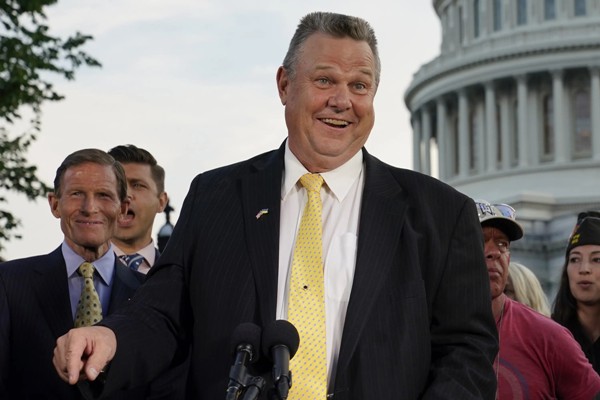 Photo credit: AP News
Photo credit: AP News
At long last it appears that Tester's appeal has diminished to the point where he is in serious trouble. He may be in trouble in the polls, where surveys lately show Sheehy ahead by about 5 points, but if money alone determined the election outcome Tester would be winning in a landslide. As of the latest FEC filings, Tester has spent over $33 million as opposed to just over $10 million for Sheehy. As we have mentioned here on numerous occasions, there's not a House district or Senate seat in the U.S. where Democrats can't outspend Republicans by incredible margins if they want to. This will be proven to be true in almost every single hotly-contested Senate and House race in 2024.
This race is not nearly over yet, and Sheehy's lead is hardly insurmountable. Even months-old data shows Tester with nearly $11 million still in the bank, and those funds will be used to saturate the airwaves and mailboxes of Montana with typical Democrat ads full of hate and lies about Sheehy (and lies about what a great senator Tester has been). Sheehy may not yet comprehend what's going to hit him between now and November, but he will find out shortly and he'd better be prepared. His lead could evaporate as quickly as it materialized.
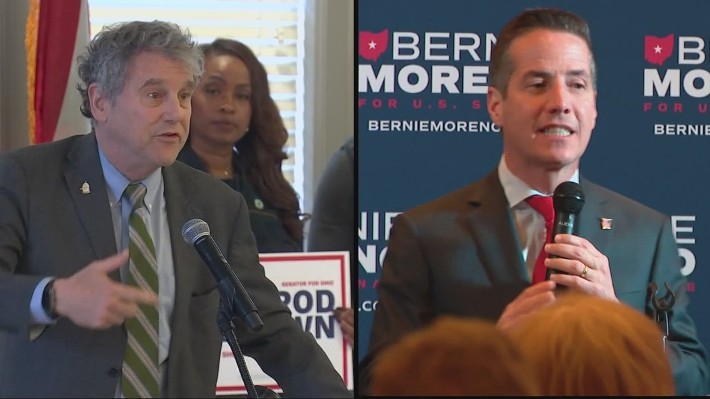 Photo credit: 10TV
Photo credit: 10TV
3. Ohio
The current Senate campaign in Ohio bears a strong resemblance to the one which took place in that state two years ago. The only substantial difference is that there was no incumbent seeking re-election in 2022 however there is one running in 2024. Incumbency is normally a distinct advantage, and this race is no exception even though the incumbent is a Democrat and Ohio (like Montana) is thought to be unfriendly territory for those on the far left of the political spectrum.
In 2022, Republican senatorial squish Rob Portman retired and there was a fractious 3-way primary to determine the GOP Senate nominee, while slimy Democrat challenger Tim Ryan faced no intra-party opposition and was able to keep his powder dry while watching three Republicans stab at each other.
In 2024 there was a fractious 3-way primary to determine the GOP Senate nominee, while slimy Democrat incumbent Sherrod Brown faced no intra-party opposition and was able to keep his powder dry while watching three Republicans stab at each other.
 Photo credit: WCPO
Photo credit: WCPO
The 2022 Republican nominee, J.D. Vance, was (and still is) unacceptably conservative according to the wimpy wing of the Republican party, he had some trouble raising money and seemed to be off the air for long periods in the summer while Ryan was on the attack 24/7. Smelling blood in the water and sensing an unexpected pickup opportunity, Democrats flooded the state with oodles of cash and Ryan was able to outspend Vance by the margin of $57 million to $15 million. After trailing most of the time, finally in October Vance consistently pulled ahead in the polls and then won in November, but it was uncomfortably close in supposedly "dark red" Ohio.
 Photo credit: Ohio Star
Photo credit: Ohio Star
The 2024 Republican nominee, Bernie Moreno, is unacceptably conservative according to the wimpy wing of the Republican party, he has had some trouble raising money and seemed to be off the air for long periods in the summer while Brown was on the attack 24/7. Democrats flooded the state with oodles of cash and Brown has so far been able to outspend Moreno by the margin of $43 million to $11 million. After trailing the entire time, finally in September Moreno appears to be closing the gap in the polls, but has yet to be shown in the lead in any poll. Will "dark red" Ohio come through for Moreno, with Trump dragging him across the finish line?
We'll see.
Trump may have difficulty attaining the 8-point margin he received in Ohio in 2020, which means his coattails aren't going to be as long as might be hoped.
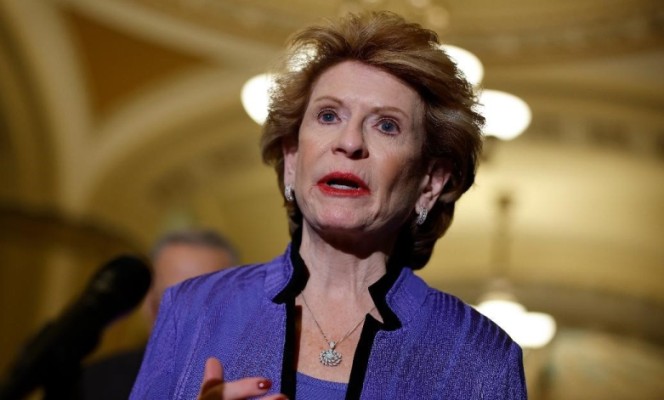 Photo credit: Market Realist
Photo credit: Market Realist
4. Michigan
Retiring liberal Democrat incumbent Debbie Stabenow was first elected to Congress in 1996 when she unseated conservative freshman Republican Dick Chrysler in Michigan's 8th congressional district. At the time that district was rated as "even" although it included all of Ingham County (Lansing) and a heavily-Democrat suburban portion of Genesee County (Flint). The presence of suburban Livingston County helped balance out the bad areas of the district, and Chrysler had won in the glorious year of 1994 because of Livingston alone (he very narrowly lost the rest of the district).
As you will see, there has been a cozy relationship between this Senate seat and that particular congressional district ever since.
Stabenow moved up to the Senate in 2000, failing to win a majority of the vote but still defeating incumbent one-termer Spencer Abraham. Abraham's win in 1994 was the last time a Republican was elected to the U.S. Senate from the state of Michigan, and Stabenow was re-elected with relative ease in 2006, 2012 and 2018, all of which were anti-GOP years. Like nearly all Democrats in elections which are even slightly contested by Republicans, Stabenow was able to outspend her GOP opponents each time by considerable margins.
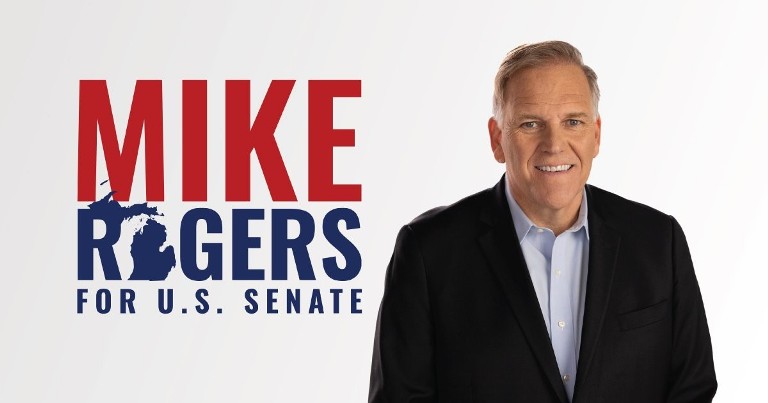 Photo credit: Rogers for Senate
Photo credit: Rogers for Senate
Stabenow's replacement in the 8th congressional district in 2000 was Republican Mike Rogers -- the same guy who is now trying to replace her in the Senate in 2024. Rogers, who was at the time a Michigan state senator, defeated fellow state senator Dianne Byrum in 2000 by just 160 votes out of nearly 300,000. Rogers campaigned as a moderate and was even able to obtain some endorsements from Democrat politicians.
Rogers' voting record in the House was a shade to the right of "moderate" for most of his 14-year career, which ended when he chose not to run for re-election to an 8th term in 2014. The 8th district was moved to the right in the 2001 redistricting, perhaps emboldening Rogers to show a little more backbone in his congressional voting. Or maybe it forced him to move a little to the right, lest he be vulnerable to a conservative challenge in a primary election.
The district's partisan composition notwithstanding, Rogers anticipated that he would never face the voters again and therefore he dropped the charade and lurched to the left in his final term. He announced his retirement in March of 2014, and pointedly declined to endorse a conservative Republican state legislator as his successor (claiming that the guy might "embarrass" the district) and opted instead to back the more moderate Mike Bishop.
After two terms in the House, Bishop was sent packing in the anti-Trump referendum election of 2018. Bishop's ultra-liberal Democrat opponent and her party were able to spend a whopping $7.5 million to purchase that House seat -- and that doesn't even include the $5.5 million which was accumulated on her behalf by "independent" groups.
Who was that extremely well-funded Democrat?
 Photo credit: CNN
Photo credit: CNN
It was Elissa Slotkin -- the "former" Deep State operative who is now the Democrat nominee for the 2024 Senate race against Mike Rogers.
Financially, it's the same story as in all other swing states this year: the Democrat has raised and spent far more money than the Republican. As of two months ago, which is the latest available data at this time, Slotkin has raised $24 million to $5 million for Rogers; she has spent $15 million while Rogers has forked out less than $3 million.
You don't have to be in some Michigan media market to understand that voters are being influenced by non-stop Democrat ads, while Rogers probably has his hands full just playing defense and trying to fight off the attacks. Rogers has done well to stay within the margin of error (but always on the losing side) in the polls. A poll which was released on September 13 showed him down by 3 points, which is his high-water mark over the last several months.
Can Rogers break the 30-year iron grip which liberal Democrats have had on Michigan's pair of Senate seats? The probability of that happening is still less than 50%, but his chances seem to be improving at this time.
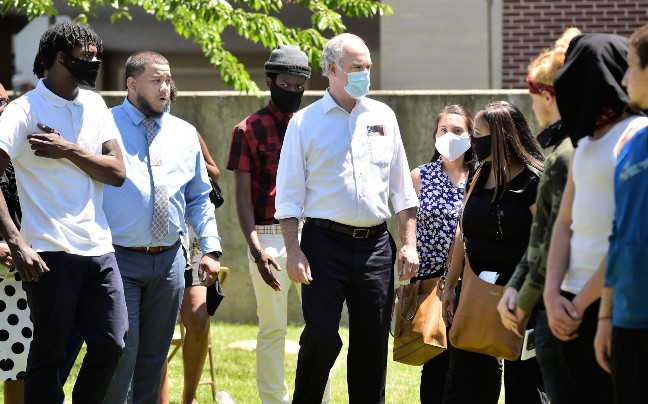 Photo credit: Lancaster Online
Photo credit: Lancaster Online
5. Pennsylvania
Current senator Bob Casey, Jr. is dumber than a chimp (or even Kamala Harris). But unfortunately so are a slim majority of PA voters, as has been consistently demonstrated in recent years with the exception of the 2016 presidential election, when Democrat overconfidence led to a (relative) lack of fraud on their part, and Trump was able to win the Keystone State by a fraction of a percent.
Part of that slim majority of ignorant PA voters consists of Gullible Geezers who tend to believe whatever lies ("Republicans are going to ELIMINATE your Social Security and Medicare! For real this time!") the liberal media continually spouts on behalf of their party.
PA is a fairly elderly state, with a percentage of over-65s (18.8%) that is nearly as high as Florida's (20.3%). When they see the name "Casey" on a ballot, some portion of Pennsylvania geezer-dom undoubtedly believes that it is Bob Casey SENIOR they are voting for. Senior was a much-beloved Governor in the 1980s and 90s who became famous nationally when he was prohibited from speaking at the 1992 Democrat National Convention due to his outspoken anti-abortionist position. Senior was totally in line with liberal Democrat orthodoxy on every other issue, however.
 Photo credit: Dave McCormick PA
Photo credit: Dave McCormick PA
Casey's (the Junior one) challenger this year is Dave McCormick. McCormick spent lavishly of his own money in the 2022 Republican primary vs. "Electable" Dr. Oz, but lost by less than 1,000 votes out of 1.34 million which were cast. McCormick graciously conceded and now has returned for another shot at the Senate -- this time with the GOP field cleared for him; no more dealing with pesky moderate dilettantes like Oz or staunch conservatives like Kathy Barnette. McCormick is again funding a large part ($4 million as of late June) of his own campaign and, aside from a recent left-biased outlier poll from CBS, appears to be inching closer to a possible -- but still unlikely -- upset.
Casey is now in his 18th Senate year, and has voted the liberal position 94% of the time during his tenure. He has been a reliable supporter of the Biden-Harris agenda and marches out of lockup on only the rarest and most unimportant of occasions. McCormick is a wealthy moderate businessman -- the kind of candidate the GOP establishment absolutely adores. Wealthy businessguys often lack icky conservatism and they have the ability to waste spend lots of money on their own behalf. It could be argued that a true conservative would have little chance of being elected statewide in Pennsylvania, and a nominal conservative like Pat Toomey or Rick Santorum is the best we can do.
Should McCormick somehow pull off the upset, his voting record in the Senate would likely be a little to the left of Toomey-Santorum though nowhere near (hopefully) as lunatic leftist as ex-Republican Senator Arlen "Judas" Specter, who went out in a blaze of bitterness back in 2010. Anything even close to Toomey-Santorum territory would be a tremendous improvement over the Casey pup in the empty suit.
PA may be 51% Democrat at the ballot box, but it deserves better than a pair of 100% liberal Senators; one is quite enough.
Other states which could have close Senate elections:
- Democrats are desperately wishing for major upsets of Republican Senate incumbents in Florida and Texas; there are no other GOP-held Senate seats which are even close to being in play. Republicans are desperately hoping for major upsets in Arizona, Nevada, Wisconsin or Maryland. The probability is that none of the above will happen, although the loss of Florida or Texas for the GOP has a greater chance of occurring than pickups elsewhere.
- GOP candidates are particularly floundering in the southwest (AZ, NV) and Ted Cruz is underperforming in Texas. We've already written in great detail about how Texas is absolutely not the solid "red" state that it might have been a few years ago, and people have quickly forgotten how marginal Florida is capable of being; 2018 wasn't all that long ago.
- Even after Governor Ron DeSantis' successful election integrity measures which targeted shady Democrat election officials in places such as Broward County and Palm Beach County, Florida can still be finicky and Rick Scott may not be taking this Senate race as seriously as he should. Scott has raised a handsome sum of money, but he may have shot his wad too early -- the femiNazi running against Scott actually has more cash on hand as of the end of July. She is also a lot closer to Scott in the polls than she should be.
Debbie Mucarsel Hyphen Powell isn't right on Scott's tail because of anything desirable or positive on her end; she may as well be listed on the ballot simply as "Not Rick Scott". Scott is the "Jon Tester" of Florida -- he has won three elections and only once has he cleared 50% (he received 50.1% in 2018). He is not popular and never has been; he has been just barely popular enough in the past.
- Only one outlier poll has showed the Republican within true striking distance in Wisconsin. In Maryland, although Larry Hogan is keeping it somewhat close against his affirmative-action opponent, Hogan seems less interested in winning a Senate seat than he does in using his campaign as a vehicle for virtue-signaling and Trump-hating.
Perhaps Maryland's version of Chris Christie is trying to position himself as a GOP presidential candidate for 2028? Or maybe he's looking to be the Democrat nominee? Either way, Hogan's not winning anything in 2024 absent divine intervention. He's going to get beat down hard in the Baltimore-D.C. corridor.
Conclusion:
The most likely scenario is that the Republicans will have a net gain of 1 or 2 seats in the Senate. If they win West Virginia and Montana but nothing more, and do not lose Florida or Texas, that will be a pretty good election night at the Senate level. But we'll still have people wailing and being bitterly disappointed in positive developments -- just like they were in 2022 -- because their greedy expectation of "muh red wayve" didn't come true and Santa didn't leave everything they wished for under the Christmas tree.
Tags:
2024
Senate
Montana
Ohio
Michigan
Pennsylvania
|
|
8/23/2024:
Reverse Poll-arity
[RightDataUSA]
|
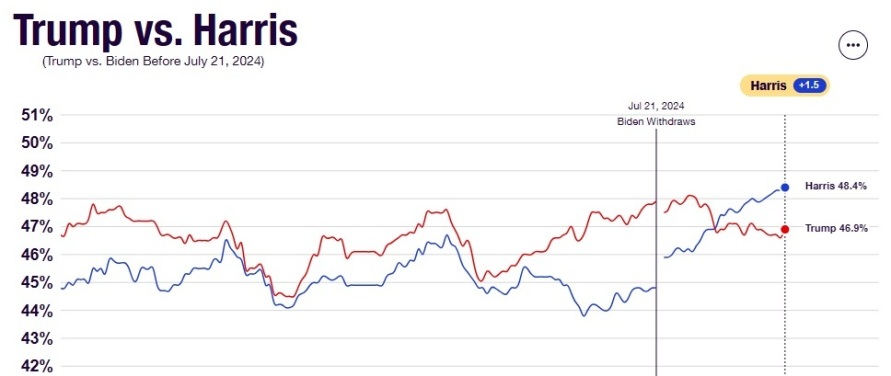
Your humble author here at RightDataUSA can now see that he wasted his time many years ago getting a 4-year Bachelor of Science degree in Mathematics and Statistics, because it turns out that a person can become an expert on subjects like polling, sampling, margins of error, etc. without any expensive formal education. He can demonstrate his alleged expertise simply by parroting the same boilerplate drivel which those who are offended by unwelcome polling results routinely resort to.
As the chart above (from Real Clear Polling) shows, this year's presidential election polls were going fairly well (i.e. telling us what we wanted to hear) up to a certain point, and now most of them are absolutely bogus (i.e. telling us what we don't want to hear). These bogus pollsters obviously live in their own fantasy world. They are clearly Democrat puppets with no interest in reflecting reality, but instead are focused on trying to gaslight the public and shape reality to their liking (oh dear, there's some of that boilerplate drivel).
Of course Democrat pollsters damn well do engage in gaslighting, but that (along with the rest of the drivel) is merely a weak crutch; when these crutches are constantly used and abused in an attempt to explain away every poll we don't like -- just as "Frodd, frodd, frodd!!!" is used to explain away every election outcome we don't like -- these feeble rationalizations lose whatever factual impact they may actually have possessed, and they become a cogent explanation for precisely nothing.
 Real Clear Politics polling average: Trump vs. Biden (click image to enlarge)
Real Clear Politics polling average: Trump vs. Biden (click image to enlarge)
Donald Trump was doing reasonably well in what turned out to be the final polls against Joe Biden, but suddenly things are a lot tighter or have even flipped in some places. Weird, eh?
It's almost as if something important pertaining to the election has changed.
Like the identity of the Democrat nominee.
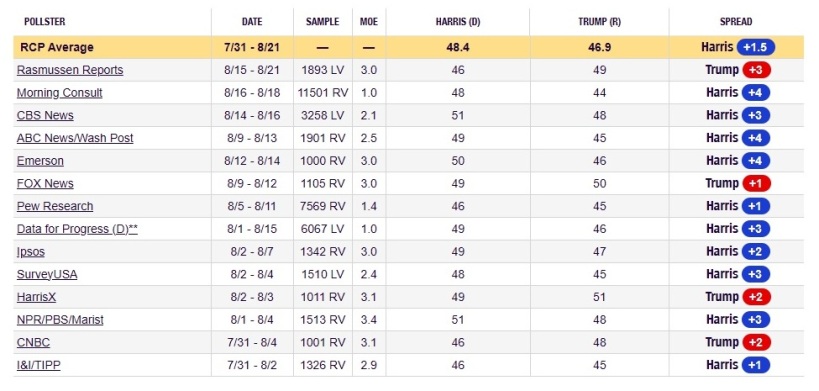 Real Clear Politics polling average: Trump vs. Harris (click image to enlarge)
Real Clear Politics polling average: Trump vs. Harris (click image to enlarge)
Some who are not entirely clueless on the subject of polling claim -- with some justification -- that the reversals suffered by Trump and down-ballot Republicans lately do not necessarily mean that respondents have reconsidered whom they intend to vote for in November. But they proceed from that valid assertion to declare that the numbers have begun heading the wrong direction merely because the pollsters are "cooking the books" -- meaning that they have baselessly altered their underlying sampling schemes in various ways which appear to energize the left and demoralize the right. What these folks identify as the pollsters' motivation for this (e.g., "setting up the Democrat steal in November") descends back into boilerplate drivel territory, but regardless of motivation the dynamics of the upcoming election have changed and the forecasting models which are employed by pollsters therefore must also change.
Polling companies vary in their methods for determining the composition of the American electorate. They must make alterations in their samples regarding respondents' sex, race, political identification, geographic location, education level and a myriad of other factors whenever necessary. Some companies make subtle alterations (which can still be sufficient to generate significant movement); some companies make more blatant alterations; and some perhaps make none at all.
Like the captain of the Andrea Doria, there are pollsters who do not accept that danger lies ahead; they refuse to change course and continue on just as if conditions haven't changed. Continuing that analogy, there are a tiny number of pollsters including Rasmussen Reports which those on the right cling to like a life raft when everything else around them seems to be sinking. Like some others in the business, Ras will only reveal the recipe for their secret sauce for a price, so we can't determine whether the relatively happy (outlier) polling results which they continually provide -- for now -- are based on ignorance of reality or on something else which might be justifiable. Other life rafts for the right (or perhaps just flotsam and jetsam) currently include Fox News (!) and Trafalgar.
Outliers notwithstanding, most pollsters have recalibrated their surveys to reflect the fact that the presidential race is quite obviously not the same as it was prior to the Democrat coup which forced Biden's exit from the ticket. Still, there are those who refuse to accept that these recalibrations are necessary and instead see nothing but sinister motives for the changes.
Well then, let's turn this around 180 degrees and gauge the reaction. What would happen if the identity of the Republican candidate suddenly changed in mid-stream? What would happen if we dumped some lackluster presumptive nominee and switched over to our own "rock star"?
 Photo credit: CNN
Photo credit: CNN
Picture, if you will, an alternate universe where Nikki Haley easily won all of the 2024 GOP primaries because she was unopposed except by some pissant candidate like whoever the Republican equivalent of Dean Phillips is (some alleged "moderate" who nobody's ever heard of).
Then the conservatives in the GOP stage a "coup" and force Haley out of the race in favor of Donald Trump, who wasn't even on the ballot in the primaries.
Now let's say the pollsters do not change their forecasting models, and therefore they show Trump doing no better than Haley against the Democrat, or perhaps doing even worse than her.
What would we be shrieking about then?
 Photo credit: Ethan Hyman
Photo credit: Ethan Hyman
Among other things, we'd be hearing:
"Pollsters are still 'oversampling' wimmen! But Trump is the nominee now and that's going to bring out more men as a percentage of voters! They need to account for that!"
"Trump is White and Haley is a minority (either Asian or black depending on whichever is most helpful at any given moment), but pollsters are still oversampling non-Whites!"
"They aren't acknowledging our exponentially-increased enthusiasm and that's the biggest factor of them all! They've tried to wave that off by claiming that Trump is just enjoying a brief 'honeymoon' period and they believe our enthusiasm will greatly diminish by November. No way, Jose! Trump really is a rock star -- just look at his rallies -- and our excitement is going to peak on election day! It's never going to wear off!"
"We grudgingly voted for Haley in the primaries because we had no other choice; she wasn't inspiring at all. Her support was a mile wide and an inch deep, and yet she wasn't faring too poorly in the polls against the Democrat. But now that Trump is our guy we have discovered the meaning of 'joy'! The pollsters still aren't budging and are refusing to accept what will surely be a dramatic turnout spike on the GOP side! We're pumped! We're stoked! We haven't seen passion like this since Ronald Reagan was running! We'd crawl over broken glass, blah blah blah...."
"In short, everything is different now, but these lying partisan Democrat pollsters haven't changed one thing. They truly live in a bubble!"
But not us. Definitely not us.
We don't like the polls but we can't change reality if we can't even bear to face reality. This election is far from over, but doing an impression of an ostrich from now until November is not the recommended way to try to achieve the best result for America.
Tags:
2024
Polls
Alternate Universe
|






















































































